- South Africa
- Family Safaris
- Luxury Safaris
- Wildebeest Migration
- Primate Safaris
- Riding Safaris
- Kilimanjaro Climbs
- Cycling Safari
- Mobile Safaris
- Beach Holidays
- Exclusively yours
- Canoe and Mokoro Safaris
- Weddings & Honeymoons
- Specialist Photographic Safaris
- Walking Safaris
- Small Group Travel
- Single Travellers
- Self Drive Adventures
- Getting Started
- When to Travel
- Safari Pricing
- Accommodation
- A Day on Safari
- Safari Tipping Guide
- The Insider’s Guide
- Why Aardvark?
- The Aardvark Story
- Meet the team
- Feedback we loved
- Responsible Tourism
- Booking Conditions
- Aardvark Guarantee

10 Best Places To See Giraffe On Safari
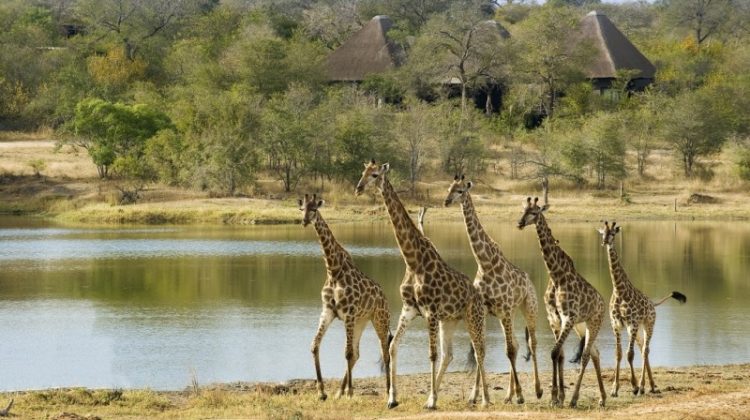
Giraffe are one of Africa’s most mesmerising animals. Spotting a head peering over the top of an acacia tree or admiring the effortless ease with which they canter across the plains never fails to delight. They are rarer than many would think, with current estimates suggesting around 111,000 individuals – a drop of nearly 45,000 from the mid 1980s. Split into four distinct sub-species, they can be seen in a variety of locations throughout sub-Saharan Africa.
- Where can I see the biggest giraffe herds?
- Where can I see reticulated giraffe?
- Where can I see Masai giraffe?
- Where can I take young children to see giraffe up close for a few hours?
- Where can I see giraffe up close?
- Where can I see giraffes with the Big 5?
- Where can I horse ride with giraffe?
- Where can I see a giraffe on a walking safari?
- Where can I see desert giraffe?
- What giraffe charities are there?
1. Where can I see the biggest giraffe herds?
Large herds gather in Selous, Tanzania
You can see groups of up to 50 giraffe in northern Selous, Tanzania, and Murchinson Falls National Park, Uganda. Back to Top
Northern Selous, Tanzania
The Nyerere National Park (formerly Selous Game Reserve) is perhaps the closest Tanzania gets to a true wilderness paradise, a fantastically large, remote region – the size of Switzerland and the biggest reserve in East Africa – and with plenty of water, opening up a whole range of activities other parks can only dream of.
Bailey’s Banda private house and pool, Beho Beho, Selous, Tanzania
Stay at Beho Beho where open plan stone and thatch cottages offer glorious views over the landscape beyond, or opt for Bailey’s Banda, still part of Beho Beho and close to the camp, but a lovely private house for those seeking exclusivity and privacy. As well as wildlife drives guests can go on walking safaris, sleep out under the stars in a tree house or take a boat trip on Lake Tagalala, and swim in the nearby hot springs.
Murchison Falls, Uganda
A giraffe birth at Murchison Falls, Uganda, Giraffe Conservation Foundation
View Rothschild’s giraffe, at Murchison Falls National Park, Uganda’s largest and oldest conservation area. The park is famous as one of the best places to see the extraordinary shoebill as well as a diverse selection of mammals and birds.
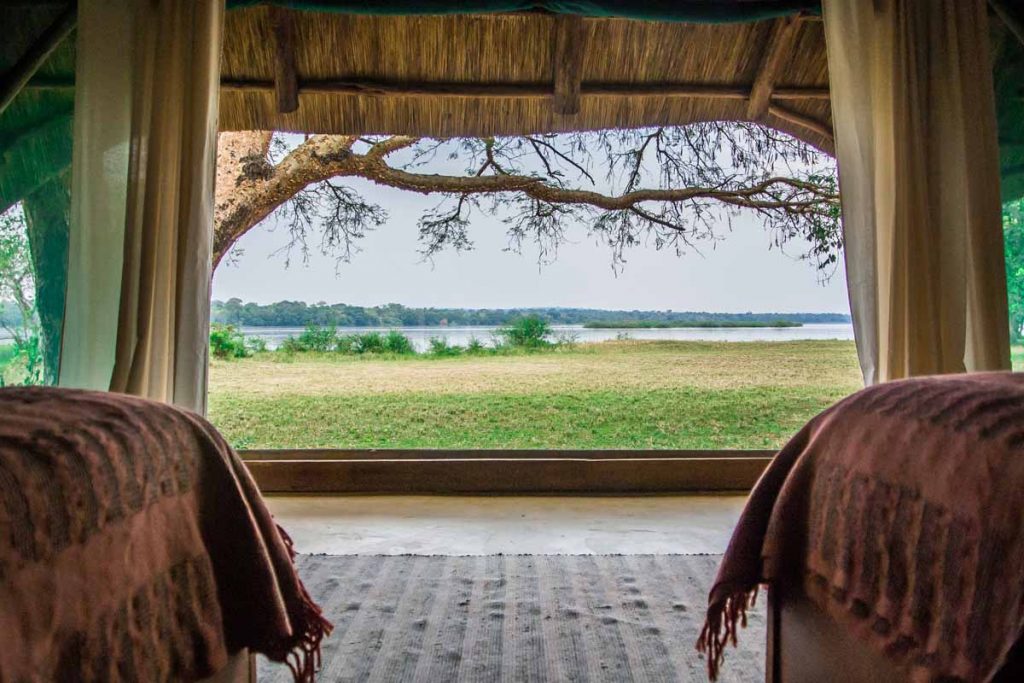
Views over the Nile from Baker’s Lodge
Stay in the park on the banks of the Nile River, at Baker’s Lodge and enjoy wildlife drives, river trips on the Nile to the base of the Murchinson Falls. Back to Top
2. Where can I see reticulated giraffe?
Reticulated giraffe on a dry riverbed in Samburu National Reserve, Sasaab , Kenya.
Northern Kenya is home of the reticulated giraffe, the most distinctive and handsome of the species, with polygonal patches divided by a neat grid of bright white lines. You can see them in Meru and Samburu Buffalo Springs in Kenya.
Meru National Park, Kenya
With only a couple of safari camps, Meru is little-visited and you’re unlikely to encounter many other vehicles here. It is one of the most rewarding of all Kenya’s National Parks and certainly a great part of any safari. All the large mammals are found in Meru and, with a bit of luck, you can spot the ‘Big Five’ of lion, leopard, buffalo, rhino and elephant, but that’s not really what you come here to see. More rewarding is to search out the ‘northern five’ of gerenuk, Grevy’s zebra, reticulated giraffe, beisa oryx and Somali ostrich.
Panoramic views of Meru at Elsa’s Kopje , Kenya, Elewana Collection
Stay at Elsa’s Kopje which takes its name from the orphaned lioness Elsa in the film Born Free. One of the most elegant lodges in Kenya, this lovely property has nine suites, and a honeymoon suite, all offering grand views of the park. Wildlife drives, guided walks, rafting on Tana River, and fishing are all possible here. If you’re after total privacy then nearby Elsa’s Private House would be a great choice.
Samburu-Buffalo Springs, Kenya
For many travellers Samburu is the highlight of a Kenya safari. It’s a wild and beautiful place, and wildlife is easy to spot in the parched landscape. There are large herds of elephant and plenty of buffalo, waterbuck, giraffe and zebra, and also dry-country rarities such as gerenuk, which reach tender shoots by standing on two legs. There’s rarely much grass cover so lion, leopard and cheetah are relatively easy to spot, and the banks of the river Ewaso Ngiro, with its large shady trees, provide plenty of excellent vantage points as the wildlife gathers at the water for an evening drink.
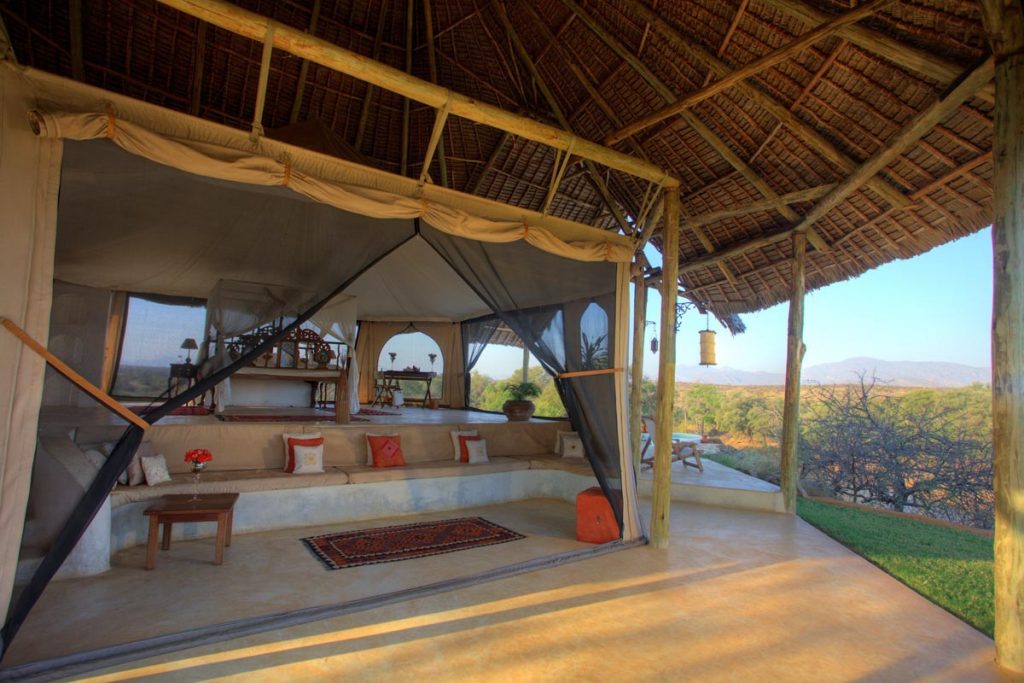
Safari tent at Sassab, Samburu, Kenya
Stay at Moroccan style Sasaab , set on a ridge over the Ewaso Ngiro River and with views of Mount Kenya, where every now and again the pool is used as a water hole by wildlife. Activities here include wildlife drives and walks, day trips to the Samburu reserve for its large herds of elephants and endangered Grevy’s zebra, mountain biking, camel riding, spa and cultural village visits. Back to Top
3. Where can I see Masai giraffe?
The Masai is the most widespread species of giraffe found in Kenya and Tanzania and is famous for its irregular coat pattern of blotches on a yellow fawn background.
Chyulu Hills, Kenya
Beautiful Chyulu Hills offer stunning views of Mt Kilimanjaro, Ol Donyo Lodge , Kenya
If it is views of Kilimanjaro you want then you have to stay in the Chyulu Hills. A wide variety of wildlife can be found in this area but due to low rainfall it is a little sparser than in other regions. It may take a little longer to find them than in the Masai Mara, but you might see gerenuk, hyena, bat eared foxes, lion, huge old tusker elephant, jackal, wild dog and large numbers of zebra, wildebeest, Masai giraffe and other antelope in wonderful privacy and absolutely stunning scenery.
Ol Donyo Starbed , Chyulu Hills, Kenya
Stay at Ol Donyo Lodge where each of the ten guest suites has its own rooftop sundowner or ‘star bed’ to enjoy the dramatic views over the plains and Mount Kilimanjaro. There are two family cottages which have space for four and their own pool. Enjoy beautiful walks as well as day and night wildlife drives, fantastic horse riding, and and mountain biking. Another great option for the more adventurous is to camp out on the plains under the stars.
Naboisho Conservancy, Kenya
The Mara Nabiosho Conservancy – a private 50,000 acre wildlife conservation area adjacent to the Masai Mara Reserve – hosts an impressive amount of wildlife, including what is considered to be the greatest density of giraffe anywhere in Africa. Among other wildlife thriving here are healthy populations of elephant, buffalo, zebra, hyena, and lion. The number of guests within the conservancy is strictly limited so you will never find a queue of vehicles huddled around a sighting. Not restricted by rules with in the Masai Mara Reserve itself, visitors here can enjoy off-road day and night wildlife drives, walking safaris and fly camping.
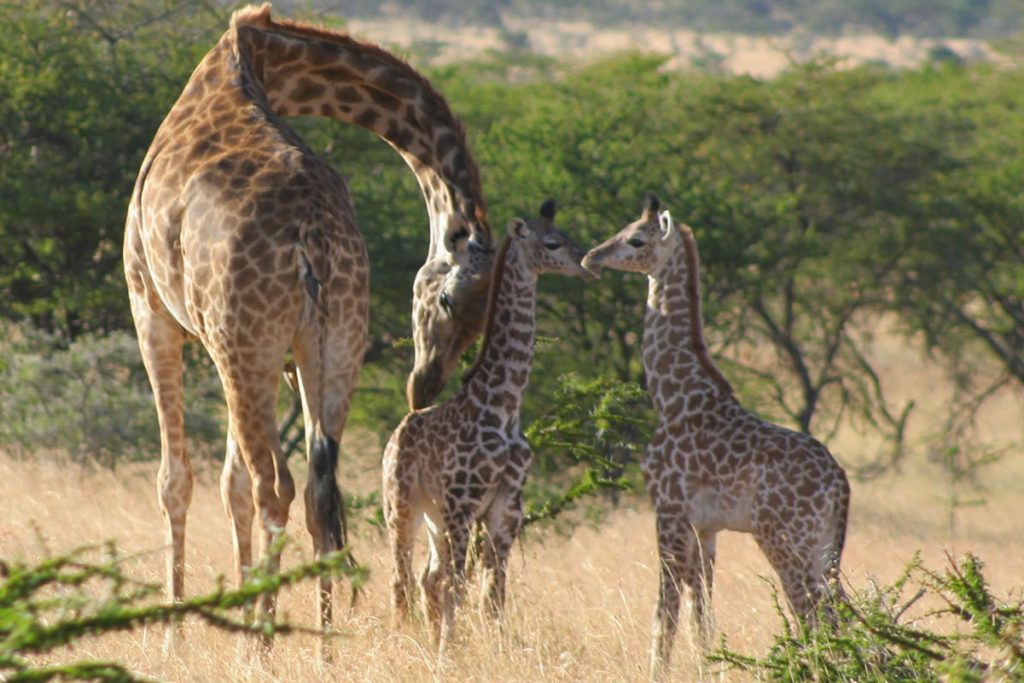
Young giraffe close to Nabiosho Camp, Nabiosho Conservancy, Kenya
Naboisho Camp is a great place to stay, and since the conservancy is a partnership between local people and the safari camp operators your visit directly benefits the community.
Serengeti, Tanzania
Known by the Masai as the ‘endless plains’ the Serengeti is filled with grazing species, including giraffe, topi, hartebeest, impala and Grant’s gazelle, alongside huge herds of buffalo and plenty of elephant. All these herbivores provide a rich and varied diet for predators and in the Serengeti you get them all. There are lion aplenty, leopard and cheetah as well as smaller species such as serval cat. Unusually, all three species of African jackal are found here, along with spotted hyena. There are aardvark and also aardwolf, a rare and delightful species which dines on the endless termite mounds dotted across the Serengeti.
There are lion aplenty in the Grumeti reserve, Tanzania
Stay at Singita Explore Camp , a private mobile camp located in the Singita Grumeti Reserve. Designed to offer guests a true wilderness experience in complete luxury, there are no set camp sites; rather location is selected for the very best wildlife viewing and scenery for the time of year.
Luxury safari tent at Singita Explore, Serengeti, Tanzania
The camp has just six large tents, each luxuriously appointed with uninterrupted views across the grassy plains. All have en-suite bathrooms with bucket showers and all the little touches synonymous with the Singita brand. The comfortable main mess area and open fire provide the focal point of camp and the perfect place to relax, enjoy a G&T and chat about the day’s adventures. Back to Top
4. Where can I take young children to see giraffe up close for a few hours?
The african fund for endangered wildlife kenya (giraffe centre), nairobi, kenya.
Family fun hand feeding a Rothschild’s Giraffe, Giraffe Centre, Nairobi
Commonly known as the Giraffe Centre this charity was founded to provide free environmental education to the Kenyan youth, and aid the conservation of endangered species. In doing so it gives visitors the opportunity to get up close and personal with endangered Rothschild giraffes at its sanctuary in Nairobi.
Giraffes amble right over to you to snack on peanut pellets from your hand. If getting licked by a foot-long tongue and hit with musky giraffe breath isn’t your idea of fun, there’s also a café, a gift shop and a tortoise pen. Back to Top
5. Where can I see giraffe up close?
Giraffe manor, nairobi, kenya.
With ten rooms and two family suites, this luxury house-turned hotel in the Karen suburb of Nairobi is a great place for a night before or after safari proper. Resident Rothschild giraffes join guests for breakfast or can be fed from your bedroom window. Cheeky giraffes have also been known to try and squeeze into the foyer.
Share breakfast with these inquisitive giraffe at Giraffe Manor , Nairobi, Kenya
Rothschild giraffe live in the grounds of Giraffe Manor , Nairobi, Kenya
Guests can feed and photograph the giraffes and the warthogs at the Manor, and also wander through the adjoining primeval forest to view the bushbuck, dik dik, and more than 180 species of birds. Back to Top
6. Where can I see giraffes with the Big 5?
Kruger, south africa.
The wildlife in the Kruger is almost overwhelming, especially in the well-watered south around the Sabi River. The best sightings are probably around the Sabi Sands region as this is where you will also find good rhino populations. It’s a fabulous area to quickly spot the ‘Big Five’ of lion, leopard, elephant, buffalo and rhino.
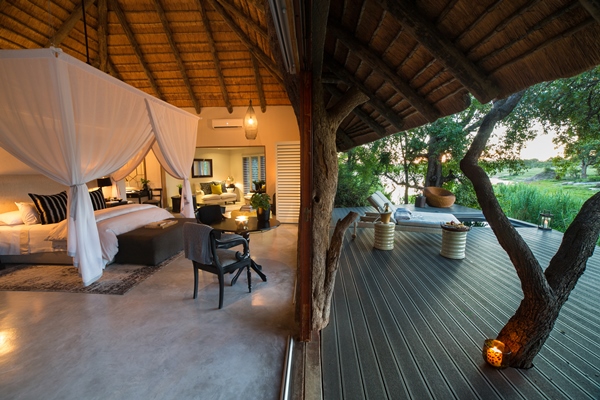
Luxurious accommodation at Chitwa Chitwa, Sabi Sands, South Africa
Chitwa Chitwa ’s stunning location in the Sabi Sands offers a great chance to see leopard, rhino, elephant, buffalo, lion, hyena – and if you are lucky, the elusive wild dog. Eight luxury suites overlook the nearby lake which is a popular water hole for a wealth of wildlife. Chitwa Chitwa offers guests the chance view the abundant wildlife on morning and evening drives, or bush walks. Back to Top
7. Where can I horse ride with giraffe?
Okavango delta, botswana.
Riding with giraffe, Okavango Delta , Botswana, African Horseback Safaris
For experienced equestrians, a riding safari with African Horseback Safaris in the Okavango Delta affords a unique way to glimpse this wildlife hotspot. Cantering through the delta floodwaters alongside giraffes is a real once-in-a-lifetime experience. Accommodation with African Horseback Safaris is in a classic safari style twin bedded Meru tents. Each has an adjoining bathroom, as well as a spacious verandah with armchairs overlooking the flood plain. At the heart of the camp there is a large furnished dining tent and tucked away in the trees is a small plunge pool on its own deck. Though this is for confident riders, we can also offer options for novice riders wishing to ride out with giraffes. Back to Top
8. Where can I see a giraffe on a walking safari?
South luangwa, zambia.
Walking safari with giraffes, South Luangwa, Bushcamp Company
You’re never that far from the wildlife in the South Luangwa – it’s one of Africa’s finest wildlife areas with more than 60 animal species and at least 400 different types of bird. When you see a lion, others won’t be far behind as here they tend to roam in prides of up to 30. It’s also home to the Thornicoft giraffe, a sub-species found only in the South Luangwa.
Thornicoft giraffes viewed from Chinzombo , South Luangwa, Zambia, Norman Carr
Stay at Chinzombo Camp , one of the finest in Zambia, where the six private villas with lovely views over the Luangwa River provide a wonderful base for exploring the park on day and night drives. Walking safaris are available too, or you could just watch the wildlife from the comfort of the open plan lounge.
Laikipia, Kenya
Giraffes in the mist, Laikipia, Kenya, Karisia Walking Safaris
Camel supported walks can be arranged in many parts of Kenya such as the Laikipia region, or in lesser travelled areas such as the Mathews Range to the north of Mount Kenya. Giraffes are seen in good numbers in these areas and when walkers are alongside the camels, the giraffes are happy to allow them to get really close.
Camel safari, Laikipia, Kenya, Karisia Walking Safaris
The mobile camp used by Karisia is very comfortable with walk-in traditional style safari tents. Each tent is furnished with a large mattress on the floor and a table, chair and basin outside. Behind each tent is a loo and a bucket shower, which is filled with hot water upon request. Meals are freshly prepared each day with hand chosen local produce and meats, and all of the cooking is done on a camp fire. Walking through the Kenyan bush with one of Karisia’s expert guides allows guests to experience the smaller things often missed from a vehicle – the tracks, the plants, the sounds, the smells.
Back to Top
9. Where can I see desert giraffes?
Skeleton coast national park, namibia.
Namibia may not have quite the populations of wildlife as its near neighbours, but its desert adapted species are quite astonishing. Elephant, rhino, giraffe, oryx and springbok are among those that have developed to cope with the harsh conditions here. Footage taken near Hoanib Skeleton Coast Camp featured in the BBC David Attenborough “Giraffes: Africa’s Gentle Giants.”
Contemporary lounge and bar at Hoanib Camp , Skeleton Coast, Namibia, Wilderness Safaris
Hoanib camp sits unobtrusively in its surroundings, overlooking a small waterhole which is occasionally visited by elephant, oryx and other animals. There are seven twin tents and one family unit, each of which is comfortably appointed and has en-suite facilities. The tents are raised on short stilts with a private, shaded outdoor lounge which is a perfect spot for relaxing in between activities. The camp has a lounge, bar area, dining room, library, fire pit, plunge pool and deck. Guests can experience walking and vehicle safaris. Hoanib also offers a flying visit to the Skeleton Coast if you stay three nights or longer.
Watch a clip of BBC documentary, ‘ Giraffes: Africa’s Gentle Giants ’, in which conservation team strive to relocate 20 wild giraffes to safety from poachers. Back to Top
10. What giraffe charities are there?
Giraffes are endangered – loss of habitat and poaching for bush meet – has led to numbers plummeting in some areas. The Giraffe Conservation Foundation featured in the BBC documentary, Giraffes: Africa’s Gentle Giants is a leading international charity dedicated to giraffe conservation and management in the wild. Back to Top
Any questions?
If you’ve got this far and not found an answer to a question you have that we should have included, please ask in the comments section below, or pop us an email. We’ll be sure to reply and may amend the article to include our answer.
We would be delighted to help you plan a giraffe safari, or answer any questions if you’re at an earlier stage. Our team of experts have travelled widely throughout Africa. They can offer expert advice on every type of safari from family and beach holidays to riding and primate safaris. If you would like to talk to someone who has been there and done it, please just send us an email or give us a call .
3 responses to “10 Best Places To See Giraffe On Safari”
I have seen a place that you can stay in a treehouse and you can view Giraffe come right up to you. Would you know where that would be and the Name! Thank you Mark
Dear Mark, Your enquiry has been passed on to a travel expert who will be in touch. Best regards Renate
Dear Mark, Your enquiry has been passed on to a giraffe treehouse expert who will be in touch. Best regards Renate
Leave a Reply Cancel reply
Your email address will not be published. Required fields are marked *
This site uses Akismet to reduce spam. Learn how your comment data is processed .
More about the Author
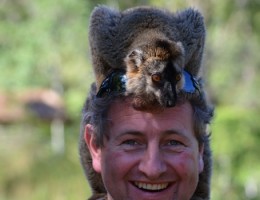
Favourite African experience
Favourite animal, my favourite four camps.
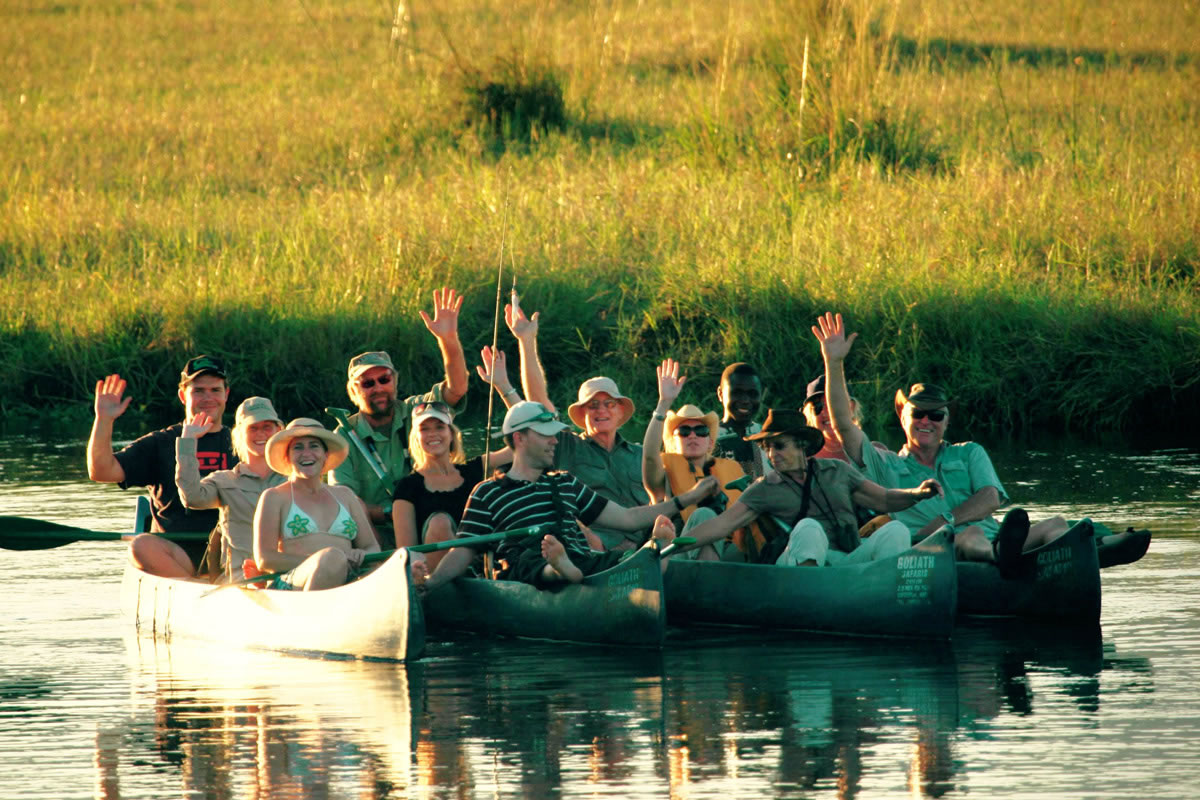
African countries visited
Tropical islands visited, riding experience, on arranging holidays.
- © 2024 Aardvark Safaris
- Privacy Policy
Our website uses cookies
Privacy overview.

Discover Uganda on a Value+ or Luxury Safari with Kabiza Wilderness Safaris
- Our Safaris
- Luxury Safaris
- Midrange Safaris
- Expat Safaris
- Fly-In Safaris
- Wellness Safari
- Family Safaris
- Gorilla Safari-Teens
- Photo Safari
- Gorilla Habituation Safari

Best Places to see Rothschild Giraffes in the Wild in Uganda
The endangered rothschild giraffes of uganda, the foremost places to see rothschild giraffes, also known as nubian – baringo or uganda giraffes..

It is especially true in Murchison Falls National Park, where there are now over 1,550 Rothschild known as Nubian (aka Baringo, or Ugandan) Giraffes.
Do not let all the different names confuse you. It is the same species of Giraffe, and they are Genetically Identical – so call them what you want – Nubian – Rothschild – Baringo, or Uganda Giraffe.
In November 2019, Rothschild-Nubian Giraffes were trans-located to the Pian-Upe Wildlife Reserve in Eastern Uganda on the border with Kenya.
Uganda, at present, is home to over 1,650 Nubians, formerly known as Rothschild Giraffe. They are found in three National Parks, Murchison Falls Park, Kidepo Valley Park, Lake Mburo National Park, and the Pian-Upe Wildlife Reserve. The Best Park in Uganda for Giraffes is Murchison Falls Park, with 1,550.

Uganda, The Pearl of Africa, is home to the most significant number of the most endangered subspecies of the Giraffe: the Nubian Giraffe (G. c. Camelopardalis).
Once, they were found in the Wild across western Kenya, western Ethiopia, southern South Sudan, and Uganda. Nubian Giraffe has been eliminated from its former rangeland in those countries except for Uganda.
In 2010, it was estimated that only about 250 Nubian giraffes (then considered Rothschild’s Giraffe) were found in Murchison Falls National Park. Poaching during Uganda’s turbulent years had taken its toll on much of the wildlife, including the Nubian Giraffe.
The Rothschild’s Giraffe was listed as Endangered on the IUCN Red List in 2010.
The Uganda Wildlife Authority, in cooperation with the Giraffe Conservation Foundation, worked together to increase the number of giraffes in the Wild in Uganda. This miraculous conservation effort has paid off, and Uganda is now home to over 1,650 Nubian giraffes. The Number of Rothschild Giraffes in the Wild in Uganda is a wildlife conservation management success story.

In 2016 a study was published in the journal Current Biology. Researchers from the Giraffe Conservation Foundation (GCF) collected and analyzed DNA from skin samples representing 190 giraffes across Africa and identified 4 Subspecies of giraffes in Africa. The Rothschild Giraffe became the Nubian Giraffe.
The Nubian Giraffe is the nominate subspecies, which means that because it was the first specimen recorded, its Latin sub-specific name is the same as the first species described. The estimated number of Nubian Giraffes is approximately 3,000 individuals, which includes the genetically identical formerly recognized as Rothschild Giraffe . Fewer than 200 occur in western Ethiopia, 450 in eastern South Sudan, 800 in Kenya, and more than 1,650 in Uganda.
Most refer to the now Nubian Giraffe as Rothschild Giraffe, which is genetically identical. When you see them, you will be caught up in the Wild Encounter with Giraffes and now worry about the particular Subspecies they are.
Best Places to see Rothschild Giraffes in the Wild of Uganda’s Parks.

Murchison Falls National Park in Uganda is the best location for seeing the Nubian or Rothschild Giraffe in the Wild. With a population of over 1,550 Giraffes, you can nowhere else see groups of up to 50 Giraffes roaming the Savannah of the park.
Due to a recent translocation of giraffes to the other side of the Nile, where no Giraffes have been for years, Giraffes can now be seen on both sides of the historic River Nile.
The story of the Giraffes of Murchison Falls National Park is a conservation success where the population of Giraffe has been used to foster the Rothschild Population of Kidepo Valley Park and start it in Lake Mburo National Park.
There is nothing like seeing a herd of 50 Giraffes together on your Game Drive in Murchison Falls Park.

Kidepo Valley Park is one of the Best Parks in Africa, and when it comes to the endangered Nubian-Rothschild Giraffes, it is the second-best place to see them.
The park was initially restocked with Giraffes from Kenya, and recently, Giraffes from Murchison Falls Park were brought here. The population of giraffes is growing here, and it is hoped that it will soon reach one hundred in number.
This unique park – is like Africa was 50 years ago. You have that all-alone feeling since there are less than 20 new visitors daily.
When you encounter the Rothschild – Nubian Giraffes here, it is an experience like nowhere else in Africa since most likely, no one else will be around.

15 Rothschild Giraffes were taken from Murchison Falls Park and transferred to Lake Mburo to restock the park with giraffes killed during the violent times in Uganda.
The environment of Lake Mburo Park is suited for Rothschild Giraffes since there are many Acacia Trees for them to feed on. Lake Mburo National Park is now the only park in Western Uganda with Giraffes.
There are now about 20-plus Giraffes found in Lake Mburo National Par, and it is the only Savannah Park with the Rothschild Giraffes.
They are in Lake Mburo because the conditions are right for them, with plenty of Acacia Trees for them to chew on.

In 2019 Giraffes from Murchison Falls Park were translocated to the Pian Upe Wildlife Reserve in Eastern Uganda on the border with Kenya. The reserve is Uganda’s 2nd largest Wildlife Reserve after Murchison Falls Park Protectorate.
Giraffes were once in abundance, but due to the past Rinderpest outbreak, poaching, and the encroachment of pastoralists, their cattle and the wildlife suffered here. It is part of the restoration of the reserve to its former wildlife glory days. Various other species have already been brought here and are thriving as the Giraffes will.
The Pian Upe Wildlife Reserve is presently off-of-the-beaten Tourist Path. However, that will soon change.
Rothschild-Nubian Giraffe Facts

Height and Weight: Male giraffes can reach a height of 6 meters (20 feet), and females are 4.5 meters in height. Males weigh up to 1,930 kg (4,250 pounds), and females up to 1,180 kilograms (2,600 pounds). Due to their size, they are like watchtowers, and they can spot a lion far away. Other animals rely on their alerting them.
Unique Features of Nubian-Rothschild Giraffes: They have white socks up to their knees. They have five horns on their heads. Two of them are in the same place as other giraffes at the top of their head, called ossicones. The third horn is in the center of their forehead, and the other two are behind each ear. They are also different from other Giraffes in the coat coloring, consisting of dark patches and then areas of creamy white through them. Their markings are along the lines of that of a leopard.

Giraffes are browsing animals that use their vast necks, and their long and mobile tongues (45.6 centimeters long) strip the leaves and bark from trees in the African Savannah. They also graze and have a series of individual valves. And a complicated network of elastic blood vessels in the neck, not only to prevent the animal from passing out when it bends down to drink or graze but also to ensure that the blood is successfully pumped along its long neck to the brain.
Another fantastic fact about Giraffes is that they can go for months without drinking liquid water – instead, they receive their water via the leaves, such as from acacia trees that they eat. You can always find them nibbling away on the top of the trees that dot the Savannah.

Giraffes live in nonterritorial groups of up to 20 (In Murchison Falls, you may see Groups as large as 50). Home ranges are as small as 85 square km (33 square miles) in wetter areas but up to 1,500 square km (580 square miles) in dry regions. The animals are gregarious, allowing for increased vigilance against predators.
They have excellent eyesight, and when one Giraffe stares, for example, at a lion a kilometer away, the others look in that direction too. Giraffes live up to 26 years in the wild and slightly longer in captivity.
You might see them moving slowly through the Savannah, but don’t be deceived. These creatures can run at a rapid clip. Despite their great height and gangly appearance, the Giraffe is one of the fastest animal species, reaching speeds of 35mph (56km/h) when running over open ground. The Giraffe can lope along for longer distances at about ten mph (16km). They have one of the most extended and mobile tongues reaching an average length of 45.6cm.
Best Places to see Rothschild Giraffes
There is no more beautiful sight than to see these gracious animals moving through Savannah in numbers. It is always the most memorable moment for visitors to Murchison Falls National Park – Kidepo Valley Park, and Lake Mburo Park.
If you are interested in visiting the Best Places to see Rothschild Giraffes in the Wild while on your Safari in Uganda – please let us know .
Related Pages:
- Best Places to see Zebras in Uganda Wildlife Parks in Uganda where you can see Zebras Best...
- Rough Guides-Murchison Falls Park pick of the best places to travel in 2020 2020 -Rough Guides-Murchison Falls Park pick of the Best Rough...
- Best Places to see Savanna Elephants in Uganda Uganda -The best place to see Savanna Elephants The best...
- The Best Places to see Leopards in Uganda the Pearl of Africa Best Parks in Uganda where you can find Leopards The...
- The Best Kidepo Valley Park Wildlife Safaris – Uganda One-of-a-kind Kidepo Valley Park Wildlife Safaris – Africa as it...
Kabiza Wilderness Safaris

Discover the best of Uganda with Kabiza Wilderness Safaris. With over 16 years of exceptional service, we offer luxury and mid-range safaris tailored to your preferences and budget. Enjoy top-notch accommodations, personalized service, and thrilling activities. Our knowledgeable driver guides provide an immersive journey without relying on GPS. Explore Uganda's beauty, wildlife, and rich culture with us. Rest assured, we are a member of AUTO and licensed by the Uganda Tourism Board. Create lifelong memories on Safari with us.
Read more about us:
Book your 2024 Safari

Embark on a worry-free Primate-Wildlife Safari with Kabiza Wilderness. Our experienced team is here to ensure every aspect of your safari adventure is taken care of. From planning and logistics to accommodations and activities, we've got you covered. Relax and enjoy the incredible wildlife and primate encounters in Uganda while we handle all the details. Book with Kabiza Wilderness for a truly worry-free experience.
Useful Links
- About us-Kabiza Wilderness Safaris
- Terms of Service
- Safari Payment
- Price Guarantee
- Flexible Booking Policy
- Privacy Policy
- Safari Reviews by our Clients
- Travel Insurance
- Uganda Travel Tips and Ad
- Current Uganda Travel Advisories
- Why you need a Safari Tour Operator
- Fly into Rwanda and Trek Gorillas in Uganda
Client Support Page

Everything you need to make your Safari in Uganda with us a reality. Visa-Information, Arrival Information- health, security information, packing lists, and more. Get the information that you need before you arrive.
Head for our Client Support Page.
Kabiza Wilderness Safaris-Hakuna Matata-Worry Free Safaris in the Pearl of Africa-Uganda
Our tour blog
Places to see giraffes in Uganda
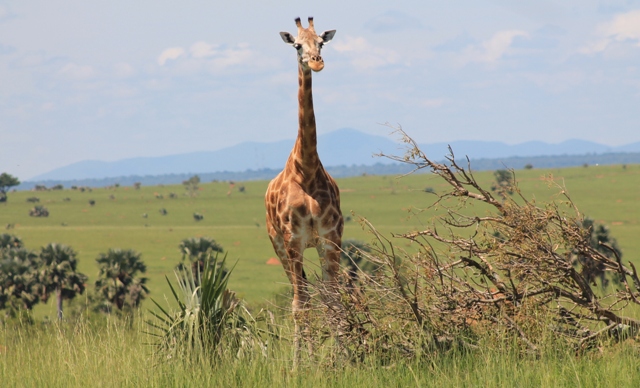
The tallest land mammal, the Giraffe , is one of the most fascinating creatures to see in the bush. This longest-naked animal with its beautiful skin patterns of brown is amazing to look at as it saunters gracefully across the plains, towering over all animals, and even plants. Such an iconic animal! It is little wonder the Giraffe is a favorite animal for a lot of people.
Uganda is a proud home to Giraffes that can be seen in some national parks and wildlife reserves and at the Uganda Wildlife Education Center (UWEC).
How many giraffes are in Uganda?
According to the last census carried out in 2020 the population of giraffes in Uganda was 2072 giraffes which was an increase of giraffes from 880 counted in 2017. These figures are by the Uganda Wildlife Authority, the government organization that manages the parks and reserves in Uganda.
What species of giraffes are found in Uganda?
Of the four known species of giraffes in Africa, Uganda has the Northern Giraffe species. The Northern Giraffe has three subspecies and of these the one subspecies found in Uganda is the Nubian Giraffes formerly (or sometimes) called the Rothschild Giraffes.
The Nubian or Rothschild is easily identified or distinguished from other giraffes by the plain white legs from knee to the hooves. The simple description is that Rothschild Giraffes “put on stockings”.
Places to see giraffes on safari in Uganda
If you are planning a safari vacation to Uganda and the Giraffe is among the animals your must see list the following are places to visit
Murchison Falls National Park
Murchison Falls National Park is simply giraffe territory! Uganda’s biggest park has the biggest population of giraffes in Uganda that were numbering 1968 by 2019. This is also the biggest population of the Nubian or Rothschild Giraffe in the world.
The giraffe population in Murchison Falls National Park has been steadily growing, having been 919 in 2016.
The growing giraffe population in Murchison Falls National Park has enable giraffes to be translocated to other park and reserves that did not have giraffes.
During the safari in Murchison Falls National Park plenty of giraffes are spotted in the savanna on the northern bank of the Nile River.
Lake Mburo National Park
Lake Mburo National Park is a recipient of giraffes translocated from Murchison Falls National Park.
16 giraffes were translocated to the park in April 2019, and according to the census in 2021 the giraffes had increased to 37 individuals.
Lake Mburo National Park being a small park makes finding the giraffes easy and thus a nice place to see giraffes in Uganda.
Kidepo Valley National Park
Kidepo Valley National Park had a few giraffes which were boosted with a 15 new individuals translocated from Murchison Falls National Park. The number is growing steadily and the park should have more than 30 individuals, improving the chances of spotting the giraffes in Uganda’s remotest safari destination.
Pian Upe Wildlife Reserve
15 Giraffes were introduced into the Pian Upe Wildlife Reserve in 2018 and the numbers have been growing. On your search for cheetahs for which the reserve is known for you can therefore expect sighting giraffes
Uganda Wildlife Education Center (Zoo)
If you wish to get closer to the giraffes and interact with them through the epic mouth-to-mouth feeding visit the Uganda Wildlife Education Center (Zoo) in Entebbe that is home to 3 giraffes.
Leave a Reply Cancel reply
Your email address will not be published. Required fields are marked *
Current ye@r *
Leave this field empty

Nubian Giraffe Conservation in Uganda
Uganda is home to one of the most threatened subspecies of giraffe: the nubian giraffe ( g. c. camelopardalis )., once free ranging across western kenya, western ethiopia, southern south sudan and uganda, the nubian giraffe has been largely eliminated from much of its former range..
In 2010, it was estimated that only 250 Nubian giraffe (then considered Rothschild’s giraffe) lived in their native range in Murchison Falls National Park. Consequently, Rothschild’s giraffe was listed as Endangered on the IUCN Red List in 2010. GCF became actively involved in giraffe conservation in Uganda in 2013, when our team conducted the first surveys and genetic sampling at Murchison Falls National Park.
This initial field work has formed the base for a long-term close collaborative giraffe conservation programme in Uganda involving GCF, the Uganda Wildlife Authority (UWA) and other partners. Ongoing conservation and research efforts by all partners indicate that giraffe numbers are higher than initially estimated and continue to increase. Due to concerted efforts to increase giraffe numbers in the country, Uganda is now home to over 1,800 Nubian giraffe – still a precariously low number that highlights the need for ongoing monitoring to ensure their survival.
GCF and UWA’s collaborative effort to conserve giraffe in Uganda is guided by a Memorandum of Understanding (MoU) that was signed by both parties in 2014 to formalise this important partnership. As part of this partnership, the National Giraffe Conservation Strategy & Action Plan for Uganda (2020-2030) was developed to identify conservation priorities. Nubian giraffe conservation in Uganda is an important programme for GCF and we are currently focusing on three national parks that host giraffe, namely Murchison Falls (northern and southern bank), Kidepo Valley and Lake Mburo National Parks, as well Pian Upe Game Reserve, where giraffe were reintroduced in 2019.
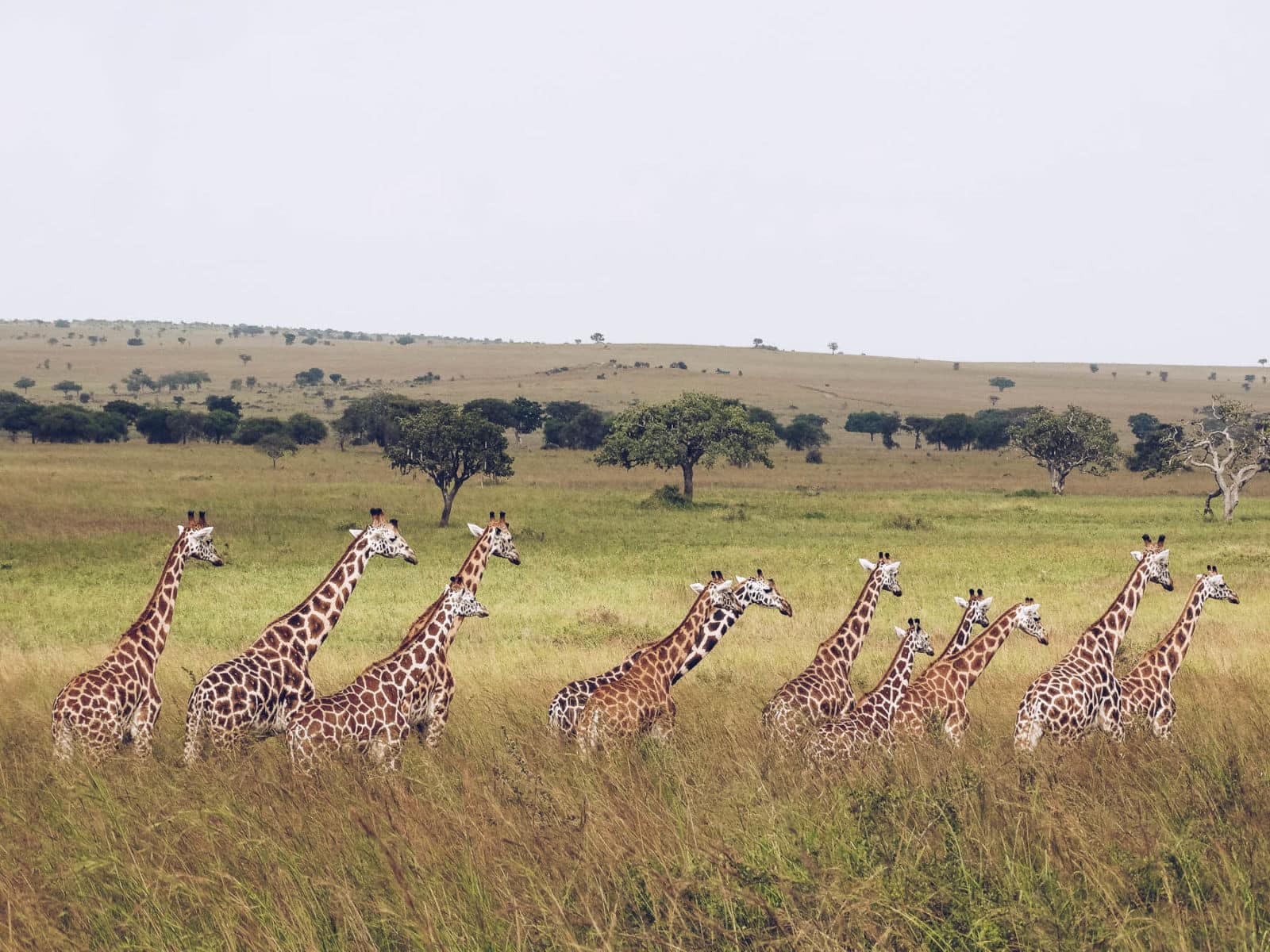
Murchison Falls National Park
With a recent estimate of 1,550 adult giraffe, the northern part of Murchison Falls National Park hosts by far the largest population of Nubian giraffe and is therefore at the centre of our Uganda programme. GCF has implemented a long-term study on giraffe numbers, their distribution and ecology in close collaboration with UWA and Dartmouth College since 2013.
With recent discovery of oil in the park and only separated from the Democratic Republic of Congo by the mighty River Nile, poaching (mainly snaring) is a major threat to all wildlife including giraffe. While giraffe are not a target species, they are collateral damage in wire traps. GCF is working closely with UWA to monitor giraffe numbers and movements, as well as providing directly anti-poaching and de-snaring support. The programme helps to provide a solid baseline to assess their long-term monitoring and proactively adapt to potential threats through oil exploration.
An important tool to secure a sustainable future for giraffe in Uganda is to increase their range within the country by establishing viable satellite populations. In January 2016, UWA with support from GCF successfully translocated a first group of 18 over the Nile River to the southern bank – Operation Twiga I. This new Nubian giraffe population was further augmented in August 2017, when 19 more giraffe were moved across the Nile River in Operation Twiga II. GCF provided significant financial support to both translocations, largely through funding raised during World Giraffe Day 2015 and 2018. After several births, the new population is now estimated at 45 individuals, indicating a solid and sustainable Nubian giraffe population in this part of the Park.
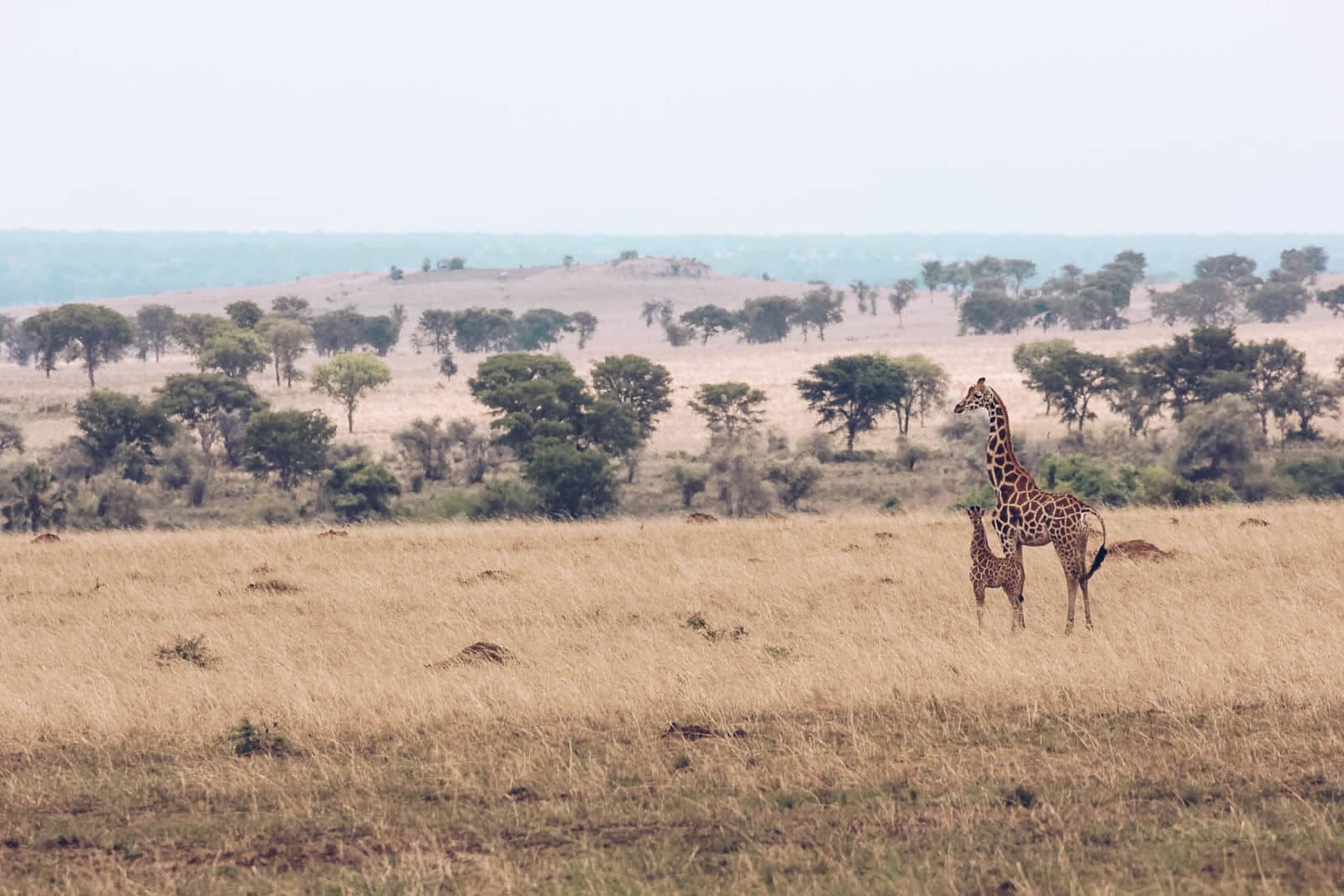
Kidepo Valley National Park
In the 1990s the giraffe population in Kidepo Valley National Park was reduced to only three individuals. Illegal hunting (poaching) was a major issue in Kidepo Valley National Park in the past due to civil unrest in neighbouring South Sudan. While poaching has since stopped and the giraffe population has seen a slow increase, these giraffe are still under threat by habitat loss and fragmentation, and disease. All these threats can ultimately be linked to human population growth.
In 2015 GCF initiated the first-ever annual giraffe census in Kidepo Valley National Park. Our annual surveys in partnership with UWA have determined that the population continues to grow slowly and increased to 36 individuals in 2018. To provide a boost for the population’s viability, an additional 14 giraffe (13 females and one male) were translocated to the park in August 2018 from Murchison Falls National Park during Operation Twiga III by UWA with the support of GCF. Ongoing monitoring of the natural and translocated population is critical. Regular field surveys are complemented by fitting several giraffe with GPS satellite units to help us track their movements and the population is now estimated at 77 individuals.
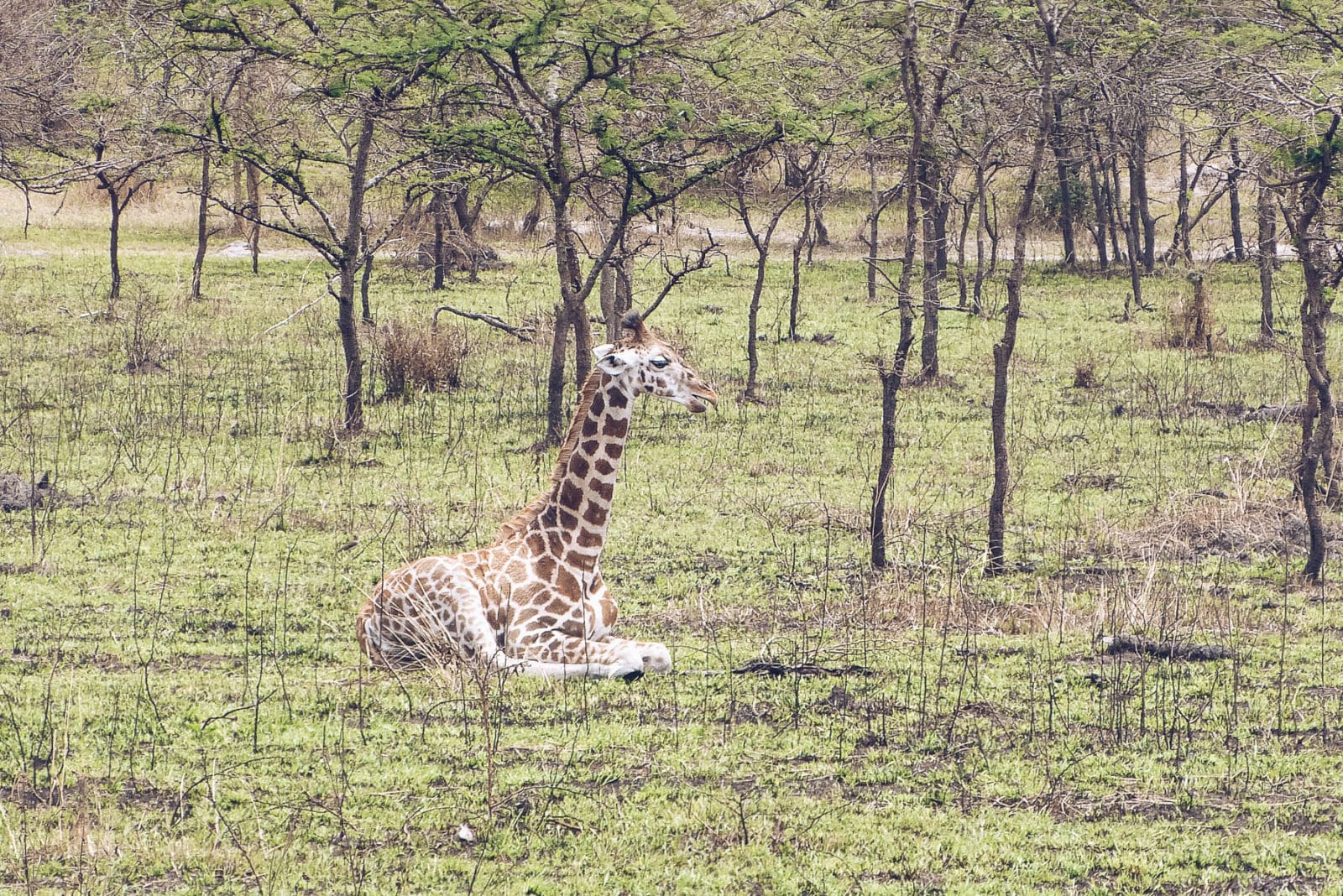
Lake Mburo National Park
It is assumed that a combination of illegal hunting (poaching) and disease caused giraffe to disappear from Lake Mburo National Park about 100 years ago. In July 2015, 15 giraffe were re-introduced into the landscape for ecological and ecotourism reasons from Murchison Falls National Park – an exciting and bold venture by UWA to expand the range of the endangered Nubian giraffe. Whilst poaching is minimal, the giraffe’s new home will be under pressure from expanding human populations surrounding the park and increasing demand for land. After the birth of at least ten calves the giraffe population is now estimated at 45. GCF is supporting UWA and a local conservation group to regularly monitor the giraffe population and work with local communities to make giraffe play a valuable role in this landscape once again.
Pian Upe Wildlife Reserve
Pian Upe Wildlife Reserve once supported Uganda’s largest population of critically endangered Nubian giraffe, but by the 1990s giraffe had totally disappeared from the area.In two conservation translocations ( Operation Twiga IV in 2019 and Operation Twiga V in 2020), 30 Nubian giraffe were returned to this landscape in a collaborative effort by GCF and UWA. Ongoing post-translocation monitoring by UWA and regular surveys by GCF show that the population is thriving in their new home. After the birth of several calves the population stands at a proud 36 animals in 2023.
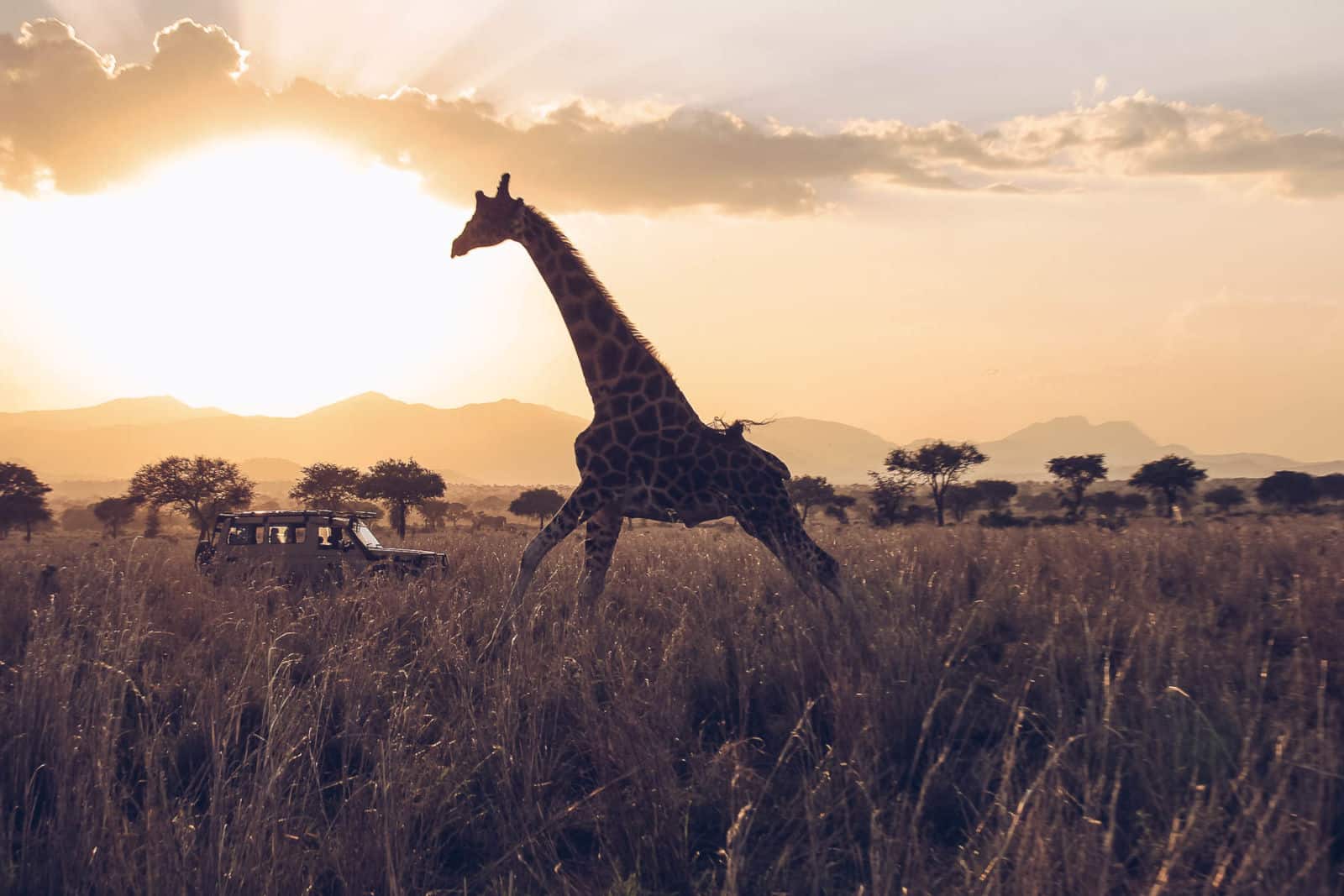
To find out more about GCF’s ongoing work on Nubian giraffe in Uganda, download our reports here:
- State of Giraffe in Uganda 2023
- Murchison Falls Survey, June 2023
- Pian Upe Survey, April 2023
- Lake Mburo Survey, March 2023
- State of Giraffe in Uganda 2022
- Lake Mburo Update, June 2020
- Kidepo Valley Survey, March 2020
- Pian Upe Survey, Mar 2020
- Lake Mburo Update, March 2020
- Lake Mburo Update, Dec 2019
- UWA Capture Team Exposure Trip, Namibia 2019
- Lake Mburo Update, Sept 2019
- Lake Mburo Update, June 2019
- Murchison Falls Survey, March 2019
- Kidepo Valley Survey, March 2019
- Lake Mburo Update, March 2019
- MFNP Giraffe Survey Update, Dec 2018
- Lake Mburo Update, August 2018
- Lake Mburo Update, May 2018
- Kidepo Valley NP, April 2018
- UWA Giraffe Conservation Awareness Report, April 2018
- Field Notes, July/Aug 2017
- Field Notes, April 2017
- Kidepo Valley NP, April 2017
- Field Notes, December 2016
- Lake Mburo MCF Annual Report 2016
- Field Notes, August 2016
- Kidepo Valley NP, April 2016
- Operation Twiga Report January 2016
- Field Notes, December 2015
- Field Report, July 2015
- Field Report, March 2015
- Field Report, December 2014
- Field Report, July 2014
To find out more about this programme, download the latest East Africa Programme Update Reports here:
- EA Programme Update Report (Nov 2020-Mar 2021)
- EA Programme Update Report (Aug-Oct 2020)
- EA Programme Update Report (Apr-July 2020)
- EA Programme Update Report (Jan-Mar 2020)
- EA Programme Update Report (Aug-Dec 2019)
- EA Programme Update Report (Apr-Jul 2019)
- EA Programme Update Report (Jan-March 2019)
- EA Programme Update Report (Sep-Nov 2018)
- EA Programme Update Report (May-Aug 2018)
- EA Programme Update Report (Jan-May 2018)
- EA Programme Update Report (May-Aug 2017)
- EA Programme Update Report (Jan-Apr 2017)
This programme is supported by:

Programme Updates
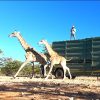
Shop For Giraffe

Proudly wear your support for GCF! The GCF Gift Shop has official t-shirts, tote bags, and more items. Proceeds from every sale help fund our conservation work in Africa.
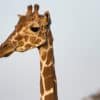

Uganda Giraffes (Rothschild giraffes)
Uganda Giraffes, Uganda is one of the very few countries in the whole world blessed to have Giraffes. The Rothschild giraffes are only found in Uganda and Kenya. They are easily distinguished by the paler less jagged coloring of their coat and they are also taller than any other specie reaching up to 5.90 meters tall (19 .7 feet), the males are also known to be bigger than the females.
There are different types of giraffe species but the type of giraffe species found in Uganda is known as the ROTHSCHILD Uganda Giraffe. In Uganda, Giraffes can only be found in the parks below:
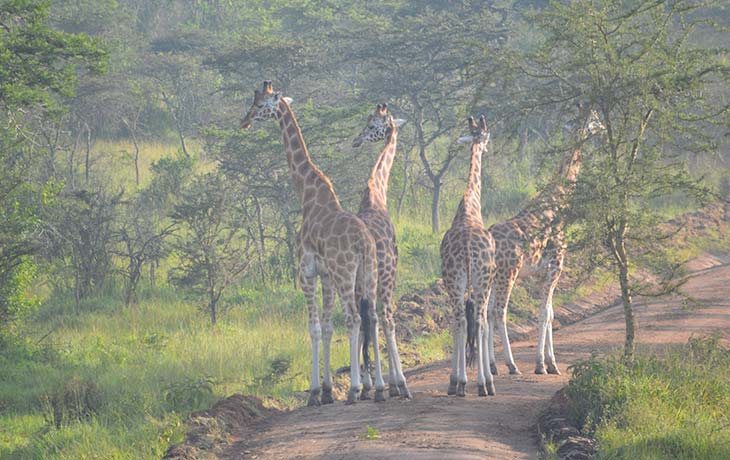
1) Giraffes in Murchison falls National Park
Murchison falls has the highest concentration of giraffes in Uganda, in the northern part of the river Nile. This is the best location to view the giraffes.
2) Giraffes in Kidepo Valley National Park
This park provides one of the best and most unique giraffe viewing experiences in Uganda. Since it is sparsely populated by both tourists and vegetation, it makes it easy to see these tall creatures roam the outstretched savannas in the distance without any distractions.
3) Giraffes in Lake Mburo National Game Park
This has 15 giraffes which were recently trans-located there from Murchison falls to help restock This park has 15 Uganda giraffes that were recently translocated from Murchison falls to help restock and diversify these animals, Lake Mburo is ideal for giraffes since it has many acacia shrubs on which Giraffes are known to feed. The Rothschild giraffe species also known as the Ugandan giraffe or the Baringo giraffe, is one of the most endangered species with only 1500 giraffes of its kind left in the wild due to the loss of habitat and poaching. But this has not been carefully paid attention to which has led to what is called the “SILENT EXTINCTION”.
The Rothschild giraffe is only found in Uganda and Kenya. They are easily distinguished by the paler less jagged colouring of their coat and they are also taller than any other specie reaching up to 5.90 meters tall ( 19.7 feet ), The males are also known to be bigger than the female.
- Share on Twitter
- Share on Facebook
- Share on LinkedIn
- About Uganda
- 2 days Tracking Gorilla Bwindi Via Rwanda
- 3 Days Gorilla tracking Bwindi
- 3 Day Gorilla Habituation Experience
- 3 days Gorilla Trekking Flying Bwindi
- 3 days Gorilla trekking Bwindi & Lake Bunyonyi
- 4 Days Gorilla tracking Bwindi & Queen
- 4 days Uganda Safaris Gorilla & Queen Elizabeth
- 5 days Gorilla Vacation Tracking Bwindi & wildlife Safari
- 6 days Primates Tracking Safaris Uganda
- 8 Days Uganda Safari & Gorilla Rwanda tracking
- 12 Days Uganda safaris & Primate tracking
- 2 Days chimpanzee tracking Budongo Forest
- 2 Days chimpanzee tracking Kibale Forest
- 3 Day chimpanzee habituation experience
- 3 Days Chimpanzee tracking safari Kibale
- 4 Day Chimpanzee Tracking & Queen Elizabeth
- 4 Days Chimpanzee tracking with Lake Nkuruba
- 6 Days Primates Tracking safaris Uganda
- 2 Days Murchison Falls Safari
- 2 Days Lake Mburo Tour Uganda
- 2 Days Queen Elizabeth National Park
- 3 Days Lake Mburo Queen Elizabeth
- 3 Days Murchison falls & wildlife Safari
- 3 Days Queen Elizabeth Safari
- 4 Day Murchison Falls, Chimpanzee & Rhino
- 4 Days Kidepo Valley flying Safari
- 4 Days Kidepo Valley National Park
- Uganda National Parks
- About Rwanda
- 1 day Gorilla Trekking Volcanoes
- 2 days Gorilla trekking Volcanoes
- 3 days Gorilla Trekking Rwanda
- 5 Days Visit Rwanda with Gorilla trekking
- 6 Days Rwanda Primates tracking
- 2 days chimpanzee trekking Nyungwe
- 3 days chimpanzee trekking Nyungwe
- Volcanoes National Park
- Akagera National Park
- Nyungwe Forest National Park
- 2 Days Akagera Wildlife safari
- 3 Days Akagera wildlife safaris
- Exclusive Rwanda safaris
- Uganda Rwanda safari combined
- 3 Days Masai Mara Safari Kenya
- Tanzania Safaris
- Wildlife Adventure
- 1 Day Kampala City Tour Uganda
- 1 Day Kigali City Tour
- 1 Day Entebbe City Tour
- 1 Day White Water Rafting Jinja
- 1 Day Experience Equator Uganda
- 1 Day Mabamba Swamp Birding
- 1 Day Mabira forest Birding
- 1 Day Lake Mburo Safari Uganda
- 1 Day Ngamba Island Chimpanzee
- 1 Day Sipi Falls tour in Uganda
- 1 Day Ziwa Rhino Sanctuary
- Our Safari Photos
- Why book with us
- Car hire & rental Uganda
- Booking Terms & Conditions
- Our Latest Customer’s Reviews
- Online Payment Option
- +256 785 101122
- [email protected]
- +256 787 696371

Where to Find Nubian Giraffe in Uganda
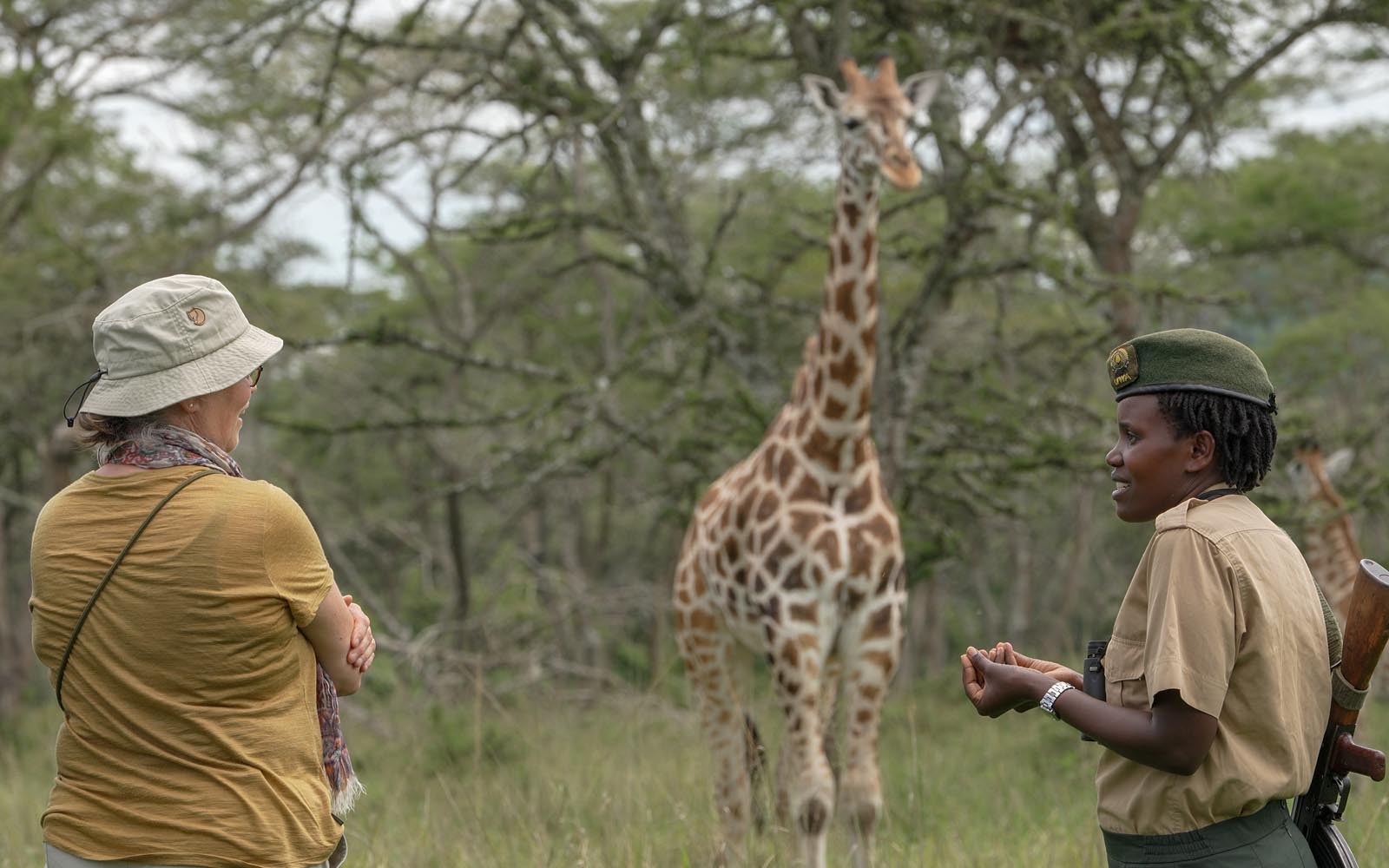
Warren Ankwasa
- January 26, 2024
Uganda, a country known for its stunning wildlife and diverse landscapes, is home to one of the most captivating and rare species on the planet – the Nubian Giraffe. Also known as the Rothschild’s Giraffe, these majestic creatures can be found in select regions of Uganda, making it a prime destination for wildlife enthusiasts and nature lovers.
Today, we will delve into the world of the Nubian Giraffe, exploring their habitat, the reasons why they thrive in Uganda, and the specific regions where they can be found. We will also discuss the best time to spot these remarkable creatures, the conservation efforts being made to protect their population, and provide valuable tips on planning a safari adventure to witness them up close.
So, if you’ve ever dreamt of coming face to face with these graceful giants, join us as we embark on a journey to discover where to find Nubian Giraffes in Uganda. Get ready for an unforgettable wildlife experience and the chance to witness the beauty of these endangered creatures in their natural habitat.
Understanding Nubian Giraffes: An Introduction
Why nubian giraffes live in uganda, specific regions where nubian giraffes are found, seasonal patterns of the nubian giraffe, ideal timing for sightings, threats to nubian giraffe population, conservation programs and their impact, choosing the right safari tour, travel tips and recommendations.
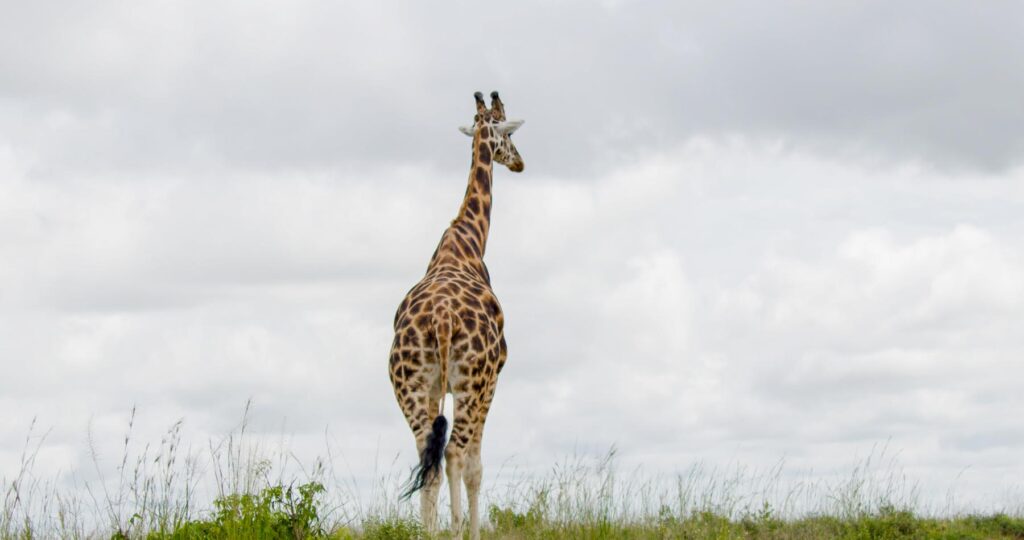
The Nubian Giraffe, scientifically known as Giraffa camelopardalis rothschildi, is a subspecies of giraffe that is native to the African continent. Renowned for its distinctive appearance and endangered status, the Nubian Giraffe holds a special place in the hearts of wildlife enthusiasts and conservationists alike.
One of the key characteristics that sets the Nubian Giraffe apart from other subspecies is its coat pattern. Unlike other giraffes, the Nubian Giraffe boasts a lighter coloration, with large orange-brown patches separated by bright white lines. This unique coat pattern makes them easily distinguishable and incredibly beautiful to behold.
In terms of physical features, Nubian Giraffes can reach impressive heights, standing up to 18 feet tall. Their long necks and legs, along with their striking pattern, make them an iconic symbol of African wildlife. Additionally, Nubian Giraffes possess a prehensile tongue that can extend up to 18 inches in length, allowing them to reach and strip leaves from thorny acacia trees, their primary source of food.
Unfortunately, the Nubian Giraffe population has faced significant challenges over the years, primarily due to habitat loss and poaching. As a result, they have been classified as endangered by the International Union for Conservation of Nature (IUCN). However, Uganda has emerged as a valuable refuge for these magnificent creatures, providing them with a safe haven to thrive and regain their population numbers.
Understanding the importance of Nubian Giraffes and their unique characteristics is crucial in appreciating their presence in Uganda. By learning more about these gentle giants, we can develop a deeper connection and appreciation for their conservation and the efforts being made to protect them. So, let’s delve further into the habitat of Nubian Giraffes in Uganda and discover why this country plays a vital role in their preservation.
Habitat of Nubian Giraffes in Uganda
The habitat of Nubian Giraffes in Uganda is characterized by a diverse range of landscapes that provide an ideal environment for these majestic creatures to roam and thrive. From lush savannahs to dense forests, Uganda offers a variety of habitats that cater to the specific needs of the Nubian Giraffe population.
Uganda’s unique geography and climate make it an attractive habitat for Nubian Giraffes. The country’s location near the equator ensures a relatively stable climate throughout the year, with warm temperatures and abundant rainfall. These favorable conditions support the growth of vegetation, providing a consistent food source for the giraffes.
Furthermore, Uganda’s conservation efforts and protected areas have played a crucial role in preserving the natural habitat of the Nubian Giraffes. National parks and wildlife reserves, such as Murchison Falls National Park and Kidepo Valley National Park, have been instrumental in maintaining suitable habitats and safeguarding the giraffe population.
While Nubian Giraffes can be found in various regions across Uganda, there are a few notable areas where sightings are more common. Here are some of the key regions where you can expect to encounter these magnificent creatures:
- Murchison Falls National Park : Situated in northwestern Uganda, Murchison Falls National Park is home to a significant population of Nubian Giraffes. The park’s diverse landscape, which includes savannahs, woodlands, and the dramatic Murchison Falls themselves, provides an ideal habitat for these giraffes.
- Kidepo Valley National Park : Located in the northeastern part of Uganda, Kidepo Valley National Park is known for its remote and untouched wilderness. This park offers a unique opportunity to spot Nubian Giraffes against the backdrop of stunning mountain ranges and vast savannah plains.
- Lake Mburo National Park : Situated in western Uganda, Lake Mburo National Park is a smaller but equally impressive habitat for Nubian Giraffes. The park’s network of lakes, swamps, and acacia woodlands provides a diverse ecosystem that supports a variety of wildlife, including giraffes.
- Queen Elizabeth National Park : In southwestern Uganda, Queen Elizabeth National Park offers a mix of grasslands, wetlands, and forests that attract a wide range of wildlife, including Nubian Giraffes. Exploring the park’s vast plains and scenic landscapes presents a great opportunity for giraffe sightings.
- Pian Upe Game Reserve: Located in the eastern part of Uganda, Pian Upe Wildlife Reserve is known for its expansive grasslands and rugged terrain. This reserve is home to a notable population of Nubian Giraffes, making it a prime location for spotting these magnificent creatures.
These regions provide a glimpse into the diverse habitats where Nubian Giraffes in Uganda can be found. With careful planning and the assistance of experienced guides, visitors have the opportunity to witness these gentle giants in their natural surroundings and contribute to their conservation efforts.
Best Time to Spot Nubian Giraffes in Uganda
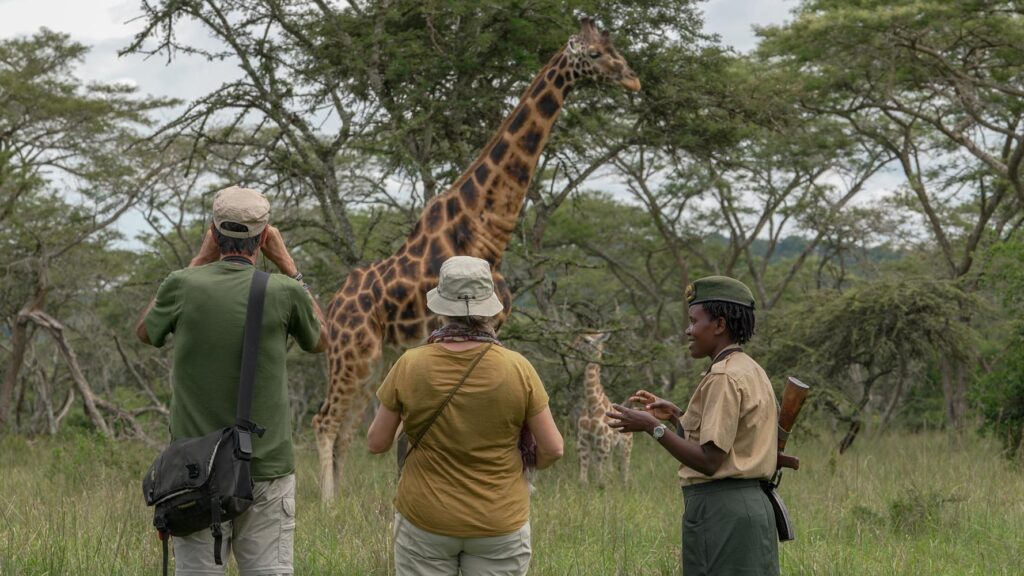
When it comes to spotting Nubian Giraffes in Uganda, timing is key. Understanding the seasonal patterns and behavior of these majestic creatures will greatly enhance your chances of witnessing them in their natural habitat. Here, we explore the best time to spot Nubian Giraffes in Uganda and provide insights into the ideal timing for sightings.
Uganda experiences two distinct seasons: the dry season and the wet season. Each season brings its own advantages and considerations for wildlife viewing, including Nubian Giraffes.
- Dry Season: The dry season in Uganda typically runs from June to September and December to February. During this time, the vegetation tends to be less dense, making it easier to spot giraffes as they move through the open grasslands and woodlands in search of food and water. Additionally, the reduced foliage offers clearer visibility for wildlife observation, increasing the chances of spotting these magnificent creatures.
Wet Season: The wet season in Uganda occurs from March to May and October to November. While the wet season brings lush greenery and abundant water sources, it can make wildlife viewing more challenging. The dense foliage and taller grasses can obstruct visibility, making it harder to spot giraffes in their natural habitat. However, the wet season also brings an abundance of food, attracting giraffes to specific areas where vegetation is plentiful.
To maximize your chances of spotting Nubian Giraffes in Uganda, it is recommended to plan your visit during the dry season. This is when the vegetation is less dense, allowing for easier visibility and increased chances of encountering these magnificent creatures. The months of June to September, in particular, are considered prime time for wildlife viewing, including giraffes.
When planning your safari, it’s important to consider the specific regions where Nubian Giraffes are found in Uganda. Research the seasonal patterns and weather conditions of these areas to ensure an optimal experience. Consulting with local tour operators or experienced guides can provide valuable insights and help you plan your visit during the best time for giraffe sightings.
It’s worth noting that wildlife sightings can never be guaranteed, as these are wild animals in their natural habitat. However, by visiting during the recommended dry season and seeking guidance from knowledgeable experts, you increase your chances of spotting the magnificent Nubian Giraffes in Uganda.
Conservation Efforts for Nubian Giraffes in Uganda
The Nubian Giraffe population in Uganda faces numerous challenges, including habitat loss, poaching, and human-wildlife conflicts. To protect these majestic creatures and ensure their long-term survival, dedicated conservation efforts have been implemented in Uganda. In this section, we will explore the threats to the Nubian Giraffe population and the conservation programs that aim to safeguard their future.
- Habitat Loss: As human populations expand and agricultural activities increase, the natural habitat of Nubian Giraffes is being degraded and fragmented. Deforestation, land conversion, and encroachment on wildlife areas are significant threats that reduce the available space for giraffes and disrupt their natural behavior.
- Poaching: Unfortunately, Nubian Giraffes are also targeted by poachers, primarily for their meat, hides, and body parts. Poaching not only reduces the population of giraffes but also disrupts the delicate balance of ecosystems in which they play a crucial role.
Human-Wildlife Conflicts: Giraffes sometimes come into conflict with local communities, especially when they venture into farmlands and consume crops. This can result in negative perceptions and retaliatory actions, further endangering the giraffe population.
To address these threats and protect the Nubian Giraffe population, several conservation programs have been implemented in Uganda. These initiatives aim to raise awareness, promote sustainable practices, and create protected areas for the giraffes to thrive. Here are some notable conservation programs and their impact:
- Giraffe Conservation Foundation (GCF): The GCF collaborates with local partners in Uganda to conduct research, monitor giraffe populations, and implement conservation strategies. Their efforts include community engagement, capacity building, and anti-poaching measures.
Protected Areas and Wildlife Reserves: National parks and wildlife reserves in Uganda, such as Murchison Falls National Park and Kidepo Valley National Park, play a vital role in conserving the Nubian Giraffe population. These protected areas provide a safe haven for giraffes and other wildlife, ensuring their long-term survival.
Community-Based Conservation Initiatives: Engaging local communities in conservation efforts is crucial for the success of giraffe conservation. Programs that promote sustainable livelihoods, alternative income sources, and education about the importance of wildlife conservation help foster positive attitudes towards giraffes and reduce human-wildlife conflicts.
Ecotourism and Responsible Travel: The promotion of responsible tourism practices and the generation of revenue from wildlife tourism contribute to the conservation of Nubian Giraffes. By supporting eco-friendly lodges, guided safaris, and community-based tourism initiatives, travelers can directly contribute to the conservation efforts and economic development of local communities.
These conservation programs, in collaboration with government agencies, NGOs, and local communities, have made significant strides in protecting the Nubian Giraffe population in Uganda. However, continued efforts and support are essential to ensure the long-term survival and thriving of these magnificent creatures.
Planning a Safari to See Nubian Giraffes
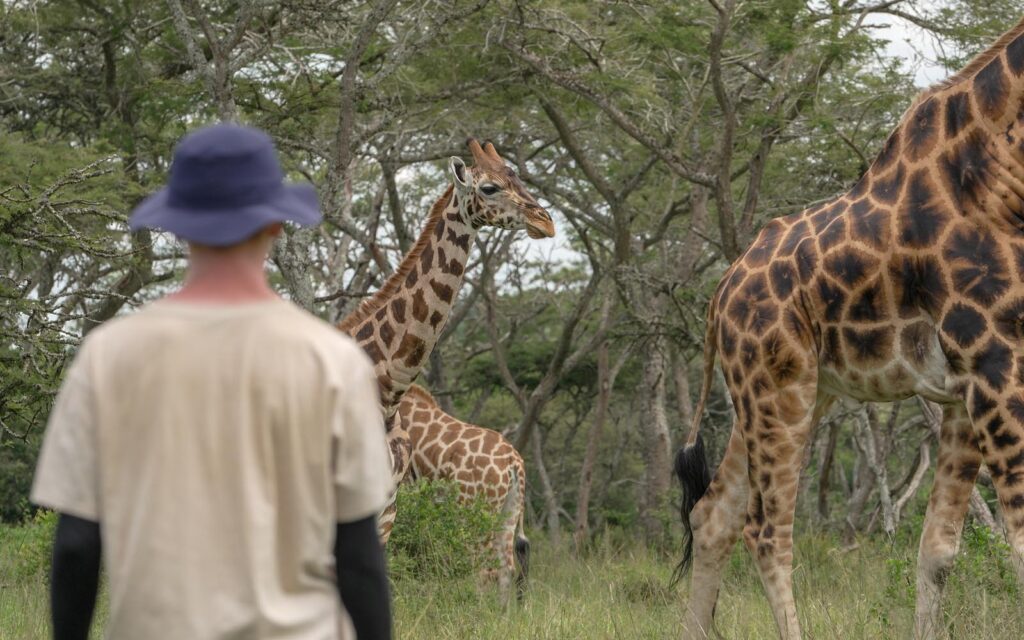
Planning a safari to see Nubian Giraffes in Uganda requires careful consideration and preparation. In this section, we will provide valuable insights and recommendations to help you plan an unforgettable wildlife adventure.
- Research Reputable Safari Operators: Look for safari operators with a strong reputation for ethical and sustainable practices. Read reviews, seek recommendations, and ensure they have experience in organizing wildlife-focused safaris in Uganda.
- Customized vs. Group Safaris: Decide whether you prefer a customized Uganda safari tailored to your preferences or a group safari that offers a shared experience with like-minded travelers. Consider factors such as budget, desired itinerary, and personal preferences when making this decision.
- Wildlife-Focused Itineraries: Opt for safari tours that specifically highlight wildlife viewing and include the regions known for Nubian Giraffe sightings. Look for itineraries that prioritize spending ample time in national parks and wildlife reserves where giraffes are known to inhabit.
- Timing and Season: As discussed earlier, plan your safari during the dry season, particularly from June to September, for better visibility and increased chances of spotting Nubian Giraffes. Check the weather conditions and consult with local experts for the most updated information.
Duration of Safari: Consider the duration of your safari. Ideally, allocate at least a few days to focus on wildlife viewing and maximize your chances of encountering Nubian Giraffes. Longer safaris allow for a more immersive experience and increase the possibility of witnessing other remarkable wildlife species.
Experienced Guides: Ensure that your safari tour provides knowledgeable and experienced guides who are familiar with the behavior, habitat, and movement patterns of Nubian Giraffes. Their expertise will greatly enhance your wildlife encounters and provide valuable insights into giraffe conservation.
Packing Essentials: Pack appropriate clothing for both warm and cool temperatures, as well as comfortable walking shoes, a hat, sunscreen, insect repellent, and binoculars. Additionally, bring a camera with extra batteries and memory cards to capture your memorable moments.
- Respect Wildlife and the Environment: When on safari, adhere to responsible tourism practices. Respect the natural habitat of the giraffes, follow park regulations, and maintain a safe distance from the animals. Avoid littering and support eco-friendly accommodations and tour operators committed to sustainability.
By considering these tips and recommendations, you can plan a safari experience that not only offers the opportunity to see Nubian Giraffes in their natural habitat but also contributes to their conservation. Immerse yourself in the beauty of Uganda’s wildlife and create memories that will last a lifetime while supporting the ongoing efforts to protect these magnificent creatures.
Experience East Africa by booking a safari with Kikooko Africa Safaris , a locally owned and operated safari company based in Uganda.
Get stories and updates from Uganda sent straight to you each month.
Recent Posts
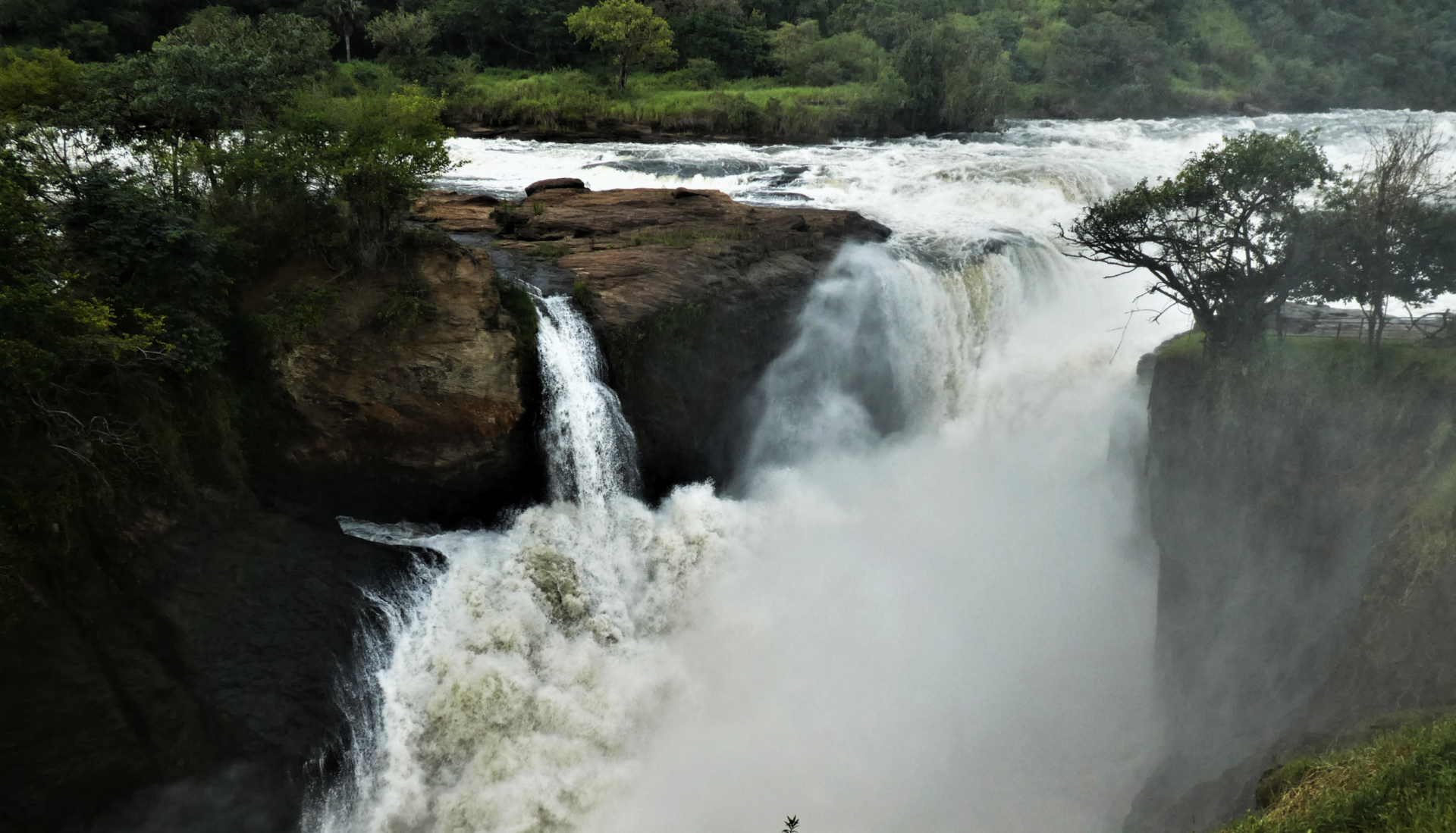
Explorer’s Guide to Murchison Falls National Park
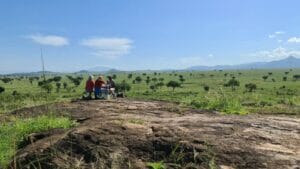
The Ultimate Guide to Kidepo Valley National Park
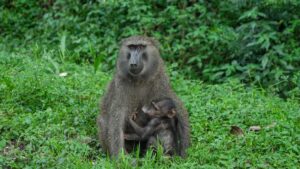
Where to Find Olive Baboons in Uganda
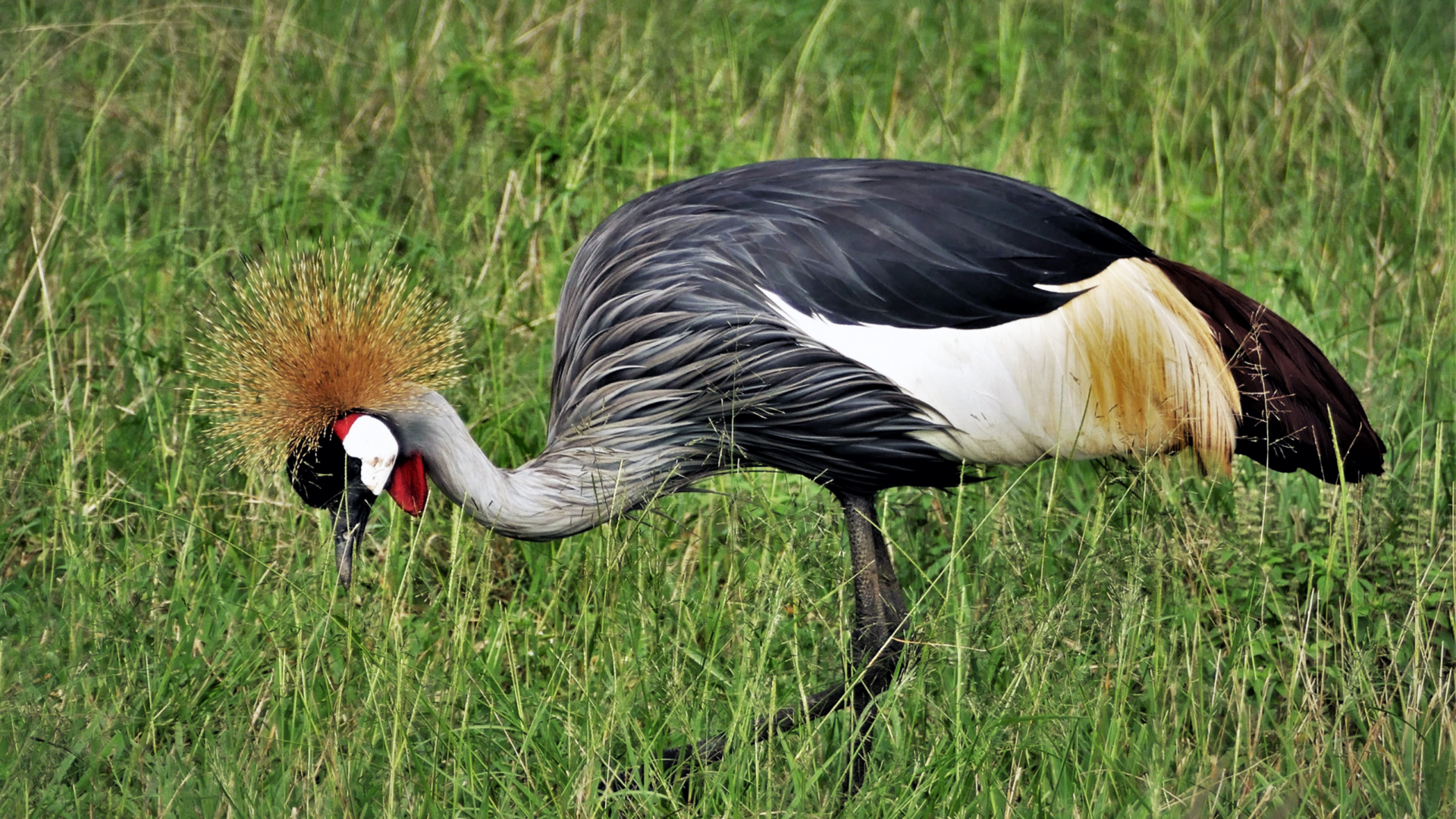
Where to See Grey Crowned Crane on Uganda Birding Tour
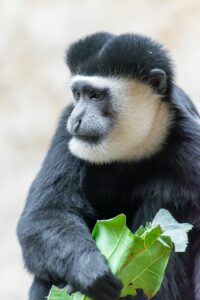
How to Track Black-and-White Colobus in Uganda
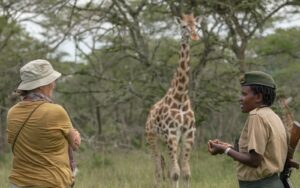
Related Posts
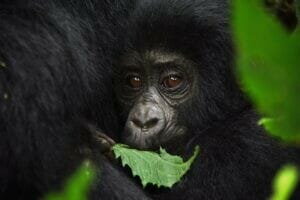
2024 Mountain Gorilla Permit Prices in Uganda, Rwanda, and DRC
The current mountain gorilla permit prices for gorilla tracking in Uganda, Rwanda, and DRC.
A local safari operator’s guide to Murchison Falls National Park including the wildlife you’ll see, how to enjoy a boat safari, and where to get the best views.
What to know before you head north to Kidepo Valley National Park, including when to travel, what wildlife to expect, and what seasons to travel.
Everything to know about where to find Olive Baboons in Uganda, including the best national parks and seasons to see them.
Let’s start planning your next safari.

Founder, Kikooko Africa Safaris
Our tailor-made safaris are designed to offer you the best possible value to make your East African experience a memorable one.
As a boutique tour operator, we are happy to personalise your trip budget and package according to your needs. When you’re ready, send us a message .
We’ll be in touch within 2 business days with ideas for your next adventure.
Safari Inspiration – Straight To Your Inbox
Wondering where in Africa to go on your first safari ? How to budget for a safari ? Want the latest baby mountain gorilla photos ?
Each month, we send tips and stories straight from Kikooko’s headquarters in Entebbe, Uganda, sharing our unique perspective on where to go, what to do, and the impact your travels can have.
Sign up today.

- KIKOOKO AFRICA SAFARIS LTD 8, Left Lane – Manyago, P.O. Box 172 Entebbe, UG
- SEND US AN EMAIL [email protected]
- TALK TO US Phone :+256 785 101 122 WhatsApp : +256 777 277 136
Latest Blogs
Partnerships.

Updates From East Africa
Uganda safaris.
- Best of Uganda
- Birder's Paradise
- Primate Habituation
- Summit Uganda
IMPORTANT LINKS
- About Kikooko
- Kikooko Cares
GORILLA SAFARIS
- 4-Day Uganda Gorilla Tour
- 10-Day Uganda Primate Habituation Tour
- 3-Day Rwanda Gorilla Tour
- 14-Day Rwanda Gorilla Tour
- 26-Day Rwanda & Uganda Tour
KIKOOKO GUIDE FAVORITES
- Abundant Wildlife of Uganda
- Luxury of a Lifetime
- Terms & Conditions
- Privacy Policy
Username or email *
Inquire About - Northern Tanzania - Classic Safari
We respond to all inquiries within 2 business days.
Inquiry Form
" * " indicates required fields
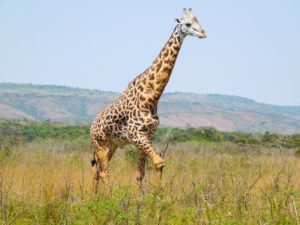
When Are You Looking To Travel?
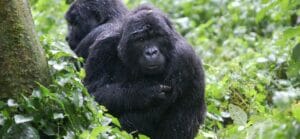

3 Best Places to See Giraffes in Uganda
- September 12, 2022
3 best places to see giraffes in Uganda: Giraffes are the tallest animals, and interestingly, a few most enchanting creatures are often spotted on a guided Uganda safari or during most African safari holidays. Not more than 1575 giraffes still live in Uganda alone, and these reside not across the country, except only in 3 key areas where they can be spotted in the wild. That are Murchison Falls National Park , Lake Mburo National Park, and Kidepo Valley National Park.
The 3 Uganda safari parks protect mainly the Rothschild type of giraffes. Giraffes stand tall up to 5-6m and weigh approximately 1200kgs for males and females 850kgs. On a guided game drive in Murchison Falls National Park, giraffes often welcome guests while they forage.
Murchison Falls National Park to see giraffes
Murchison Falls National Park supports the highest population of giraffes in Uganda, and they concentrate around the Northern region. Murchison Falls N/Park is the only Uganda park that is found in the Northwest, and it is also the biggest of the 10 parks, occupying a vast area of about 3840sq. km.
Murchison Falls National Park is one of the premier wildlife safari destinations in Uganda. The popular attractions in this park besides giraffes, include Murchison Falls -one of the world’s powerful waterfalls that is often witnessed squeezing itself into a narrow rock of about 7m before plunging about 43m below creating a permanent rainbow and powerful roar.
Other wildlife in Murchison Falls National Park includes variety of antelope families (Jackson’s Hartebeests, Uganda Kobs, Oribis, Uganda Kobs), elephants, buffaloes, leopards, lions, warthogs, primates residing in Budongo Forest, the Southern section of the park and they include olive baboons, black and white colobus monkeys, blue monkeys, red tailed monkeys, red colobus monkeys, pottos etc. Over 451 bird species exist in Murchison Falls N. Park alone, and they include African jacana, shoebill stork, malachite kingfishers, Abyssinian ground hornbill, yellow foot flycatchers, etc.
Kidepo Valley National Park giraffes
Located in the far end of Northeastern Uganda, Kidepo Valley National Park is a true wilderness, a home to more than big game. Kidepo is one special location in Uganda where you can find giraffes on a game drive. Founded in 1962, Kidepo National Park is Uganda’s 3 rd biggest safari park, covering the land area of about 1442sq.kms featuring the sweeping savanna plains.
Nubian Giraffe Conservation in Uganda
Over 75 mammal species live in Kidepo plus 470 bird species in addition to numerous giraffe population. A game drive or viewing in Kidepo is a remarkable opportunity to keep an eye on diverse mammals including Kudus, roan antelopes, elands, cheetahs, lions, leopards, buffaloes, reedbucks, hyenas, zebras, waterbucks, oryx, Uganda Kobs, duikers, elephants, to mention but a few.
The birds of interest on Kidepo tour include ostriches, Egyptian vultures, pygmy falcon, Jackson’s hornbill, Abyssinian rollers, yellow billed hornbills, Verreaux’s eagle, yellow rumped seedeaters, black coucal, yellow billed shrikes, Karamoja apalis, Clapperton’s francolins, broad tailed warblers, black breasted barbet etc.
Lake Mburo National Park
Lake Mburo National Park is currently a home to giraffes that were translocated in 2018 from Murchison Falls National Park. A total of 15 Rothschild giraffes were transported from Northwestern Uganda to Lake Mburo N.P making it a special destination in Western Uganda.
In addition to giraffes, visitors with plans to go Uganda tour to Lake Mburo National Park can also look out for the park’s other special mammals, reptiles, birds etc. Over 68 species of mammals live in Lake Mburo N/Park and they include hyenas, buffaloes, elands, Uganda Kobs, topis, zebras, bush bucks, jackals, warthogs, impalas. More than 350 bird species also reside in this compact park, also Uganda’s most accessible destination.
The birds to interest you on Uganda safaris in Lake Mburo National Park include African finfoot, bare-faced go-away bird, black bellied bustard, saddle billed stork, African wattled lapwing, Southern ground hornbill, brown chested lapwing, greater painted snipe, blue headed coucal, African scops owl, African finfoot, tabora cisticola, red faced barbet, white winged swamp warblers, yellow rumped tinker bird, papyrus yellow warblers, shoebill stork, papyrus gonoleks and more.
The best time to visit Lake Mburo National Park for birding expeditions is around June and July when rains are less. For birders who are interested in migratory birds, then consider planning your birding trip to Lake Mburo N/Park Uganda from November to April.
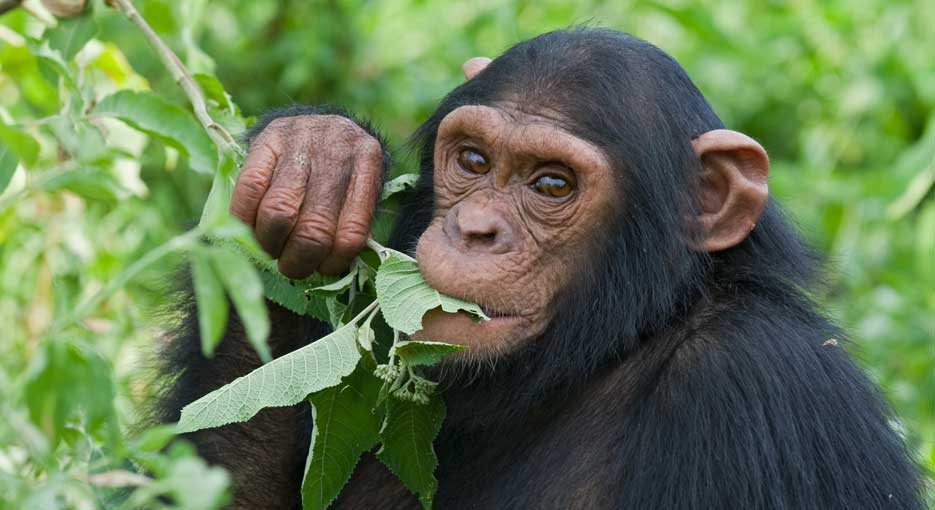
3 Days Ngamba & Faith-Based Tourism
3 Days Ngamba & Faith-Based Tourism 3 days Ngamba and faith-based tourism offer a perfect…

Gorilla Gives Birth
18-Year-Old Gorilla Gives Birth in Bwindi Impenetrable National Park An 18-year-old gorilla gives birth in…
New Baby Gorilla in Ruhija Sector
New Baby Gorilla in Ruhija Sector, Bwindi It is yet another great news in the…
- previous post: Cycling Tours in Rwanda
- next post: Where to go for night game drives in Uganda?
- You are here:
Where To See Giraffes in Africa – The 10 Best Places To Go

Philip is a renowned Africa expert and author of more than 20 guidebooks to African destinations.
The giraffe is the skyscraper of the animal kingdom. Arguably the most extraordinary of Africa’s wildlife icons, it is the world’s tallest terrestrial animal. It stands up to 6m high, thanks to an elongated neck that comprises just seven footlong vertebrae. Needless to say, no African safari would be complete without a sighting of these magnificently gangly creatures.
If you’re wondering where to see giraffes in Africa, the good news is that they’re common and conspicuous in most safari destinations. But a few places do stand out as perhaps the best places to see giraffes in Africa, and below are some suggestions that I have found particularly rewarding over the years.
11,014 African Safaris
1. Amboseli National Park – Kenya
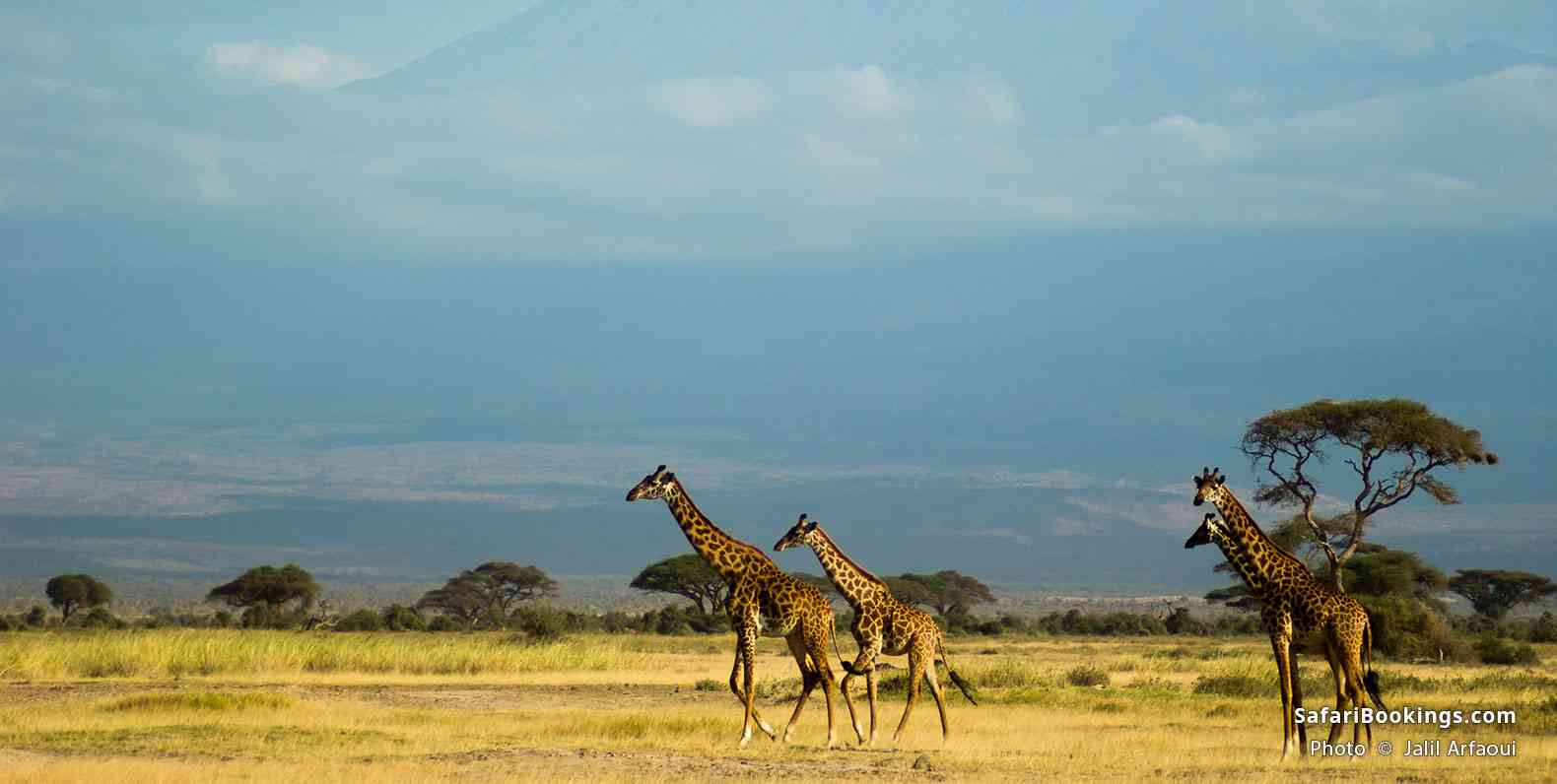
Dominated by ashy plains and perennial marshes, Amboseli supports many large stands of umbrella thorn, a flat-topped acacia that’s catnip to a hungry giraffe. Giraffes are largely restricted to the acacia forests in the park’s east, near Kimana Gate. The park’s most distinctive feature is snowcapped Kilimanjaro, which towers 5km above the plains, and makes for a stunning photographic backdrop when the giraffes and acacias line up correctly.
916 Amboseli Safaris
2. Murchison Falls National Park – Uganda

Uganda’s Murchison Falls is home to around 1,250 Rothschild’s giraffes, more than half the global population of this localized subspecies. The giraffe herds here are perhaps the largest I’ve seen, often numbering 30-plus individuals, a memorable sight as they march through the borassus grassland in the north of the park. I’ve also often seen giraffes from the boat trips that follow the Nile River to the base of the spectacular waterfall for which the park is named.
536 Murchison Falls Safaris
3. Lake Naivasha – Kenya

It isn’t all that long ago that giraffes ranged widely across unprotected parts of East Africa. Today, sadly, they are almost entirely confined to national parks and game reserves. A notable exception is Kenya’s Naivasha, a gorgeous Rift Valley lake where giraffes are frequently encountered browsing in the fringing fever trees. Naivasha’s giraffes are super-relaxed and can often be approached on foot – a neck-craning angle that allows you to fully appreciate their height.
610 Lake Naivasha Safaris

4. Kruger National Park – South Africa

Renowned as a superb Big Five destination, South Africa’s largest national park is also one of the best places to see giraffes in Africa. It is geared to self-drivers, who have the opportunity to explore at their own pace and enjoy viewing the park’s habituated giraffes in action. Fascinating behavior that might be seen includes necking, a form of ritualized fighting that involves two males battering each other’s necks repeatedly to establish dominance.
424 Kruger Safaris
5. Nyerere (Selous) National Park – Tanzania

Curiously, while giraffes are absent from southern Nyerere (formerly Selous Game Reserve), they are so common in the park’s northern tourist circuit that it has been nicknamed ‘Giraffic Park’. Boat trips on the Rufiji – a magnificent tropical waterway alive with hippos, crocs and birds – offer a great opportunity to witness giraffes drinking. This improbable feat of natural engineering requires the animal to splay its legs wide apart before gingerly lowering its long neck until its head touches water.
266 Nyerere Safaris
6. Arusha National Park – Tanzania
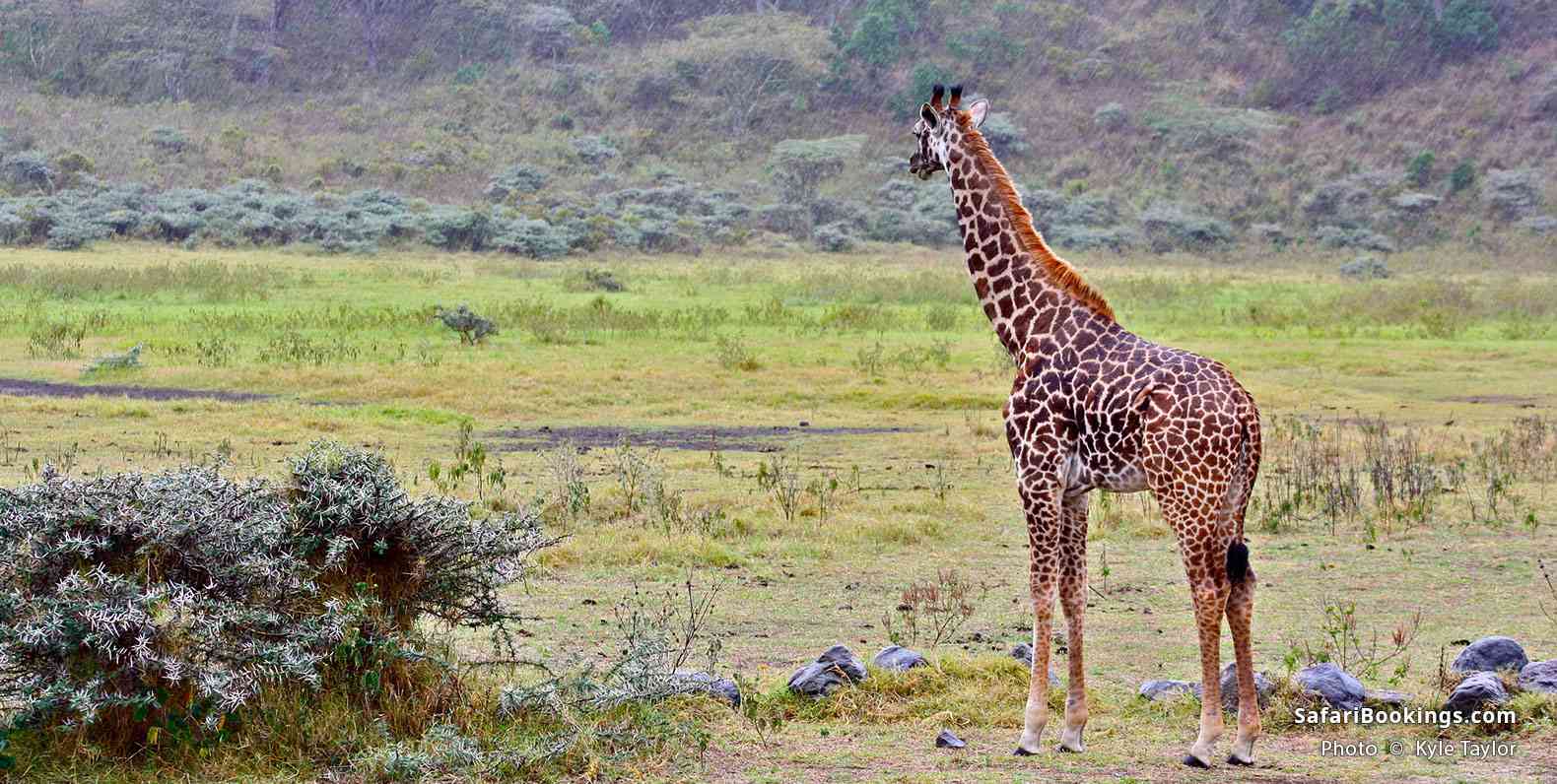
Tanzania’s Northern safari circuit, centered on the world-famous Serengeti and Ngorongoro, is one of Africa’s finest wildlife destinations. For giraffe viewing, the circuit’s highlight is the underrated Arusha National Park, where guided walks provide a humbling opportunity to see these lofty creatures on foot. A bonus is the magnificent backdrop provided by Mt Meru (and if you’re lucky, more distant Kilimanjaro). Arusha National Park is about one hour’s drive from either of the northern circuit’s two main airports; why not start or end your Tanzanian safari with a night there?
185 Arusha NP Safaris
7. Hwange National Park – Zimbabwe

Although giraffes are no more common in Hwange than in many other major African reserves, Zimbabwe’s largest national park is notable for two behavioral quirks. It is the only place I know where giraffes regularly lie down in the middle of the day and where they routinely stoop down to nibble on grass. Logistically, I’d recommend this excellent Big Five reserve as a convenient add-on to the ever-popular Victoria Falls, only two or three hours’ drive northwest.
68 Hwange Safaris
8. Luangwa Valley – Zambia
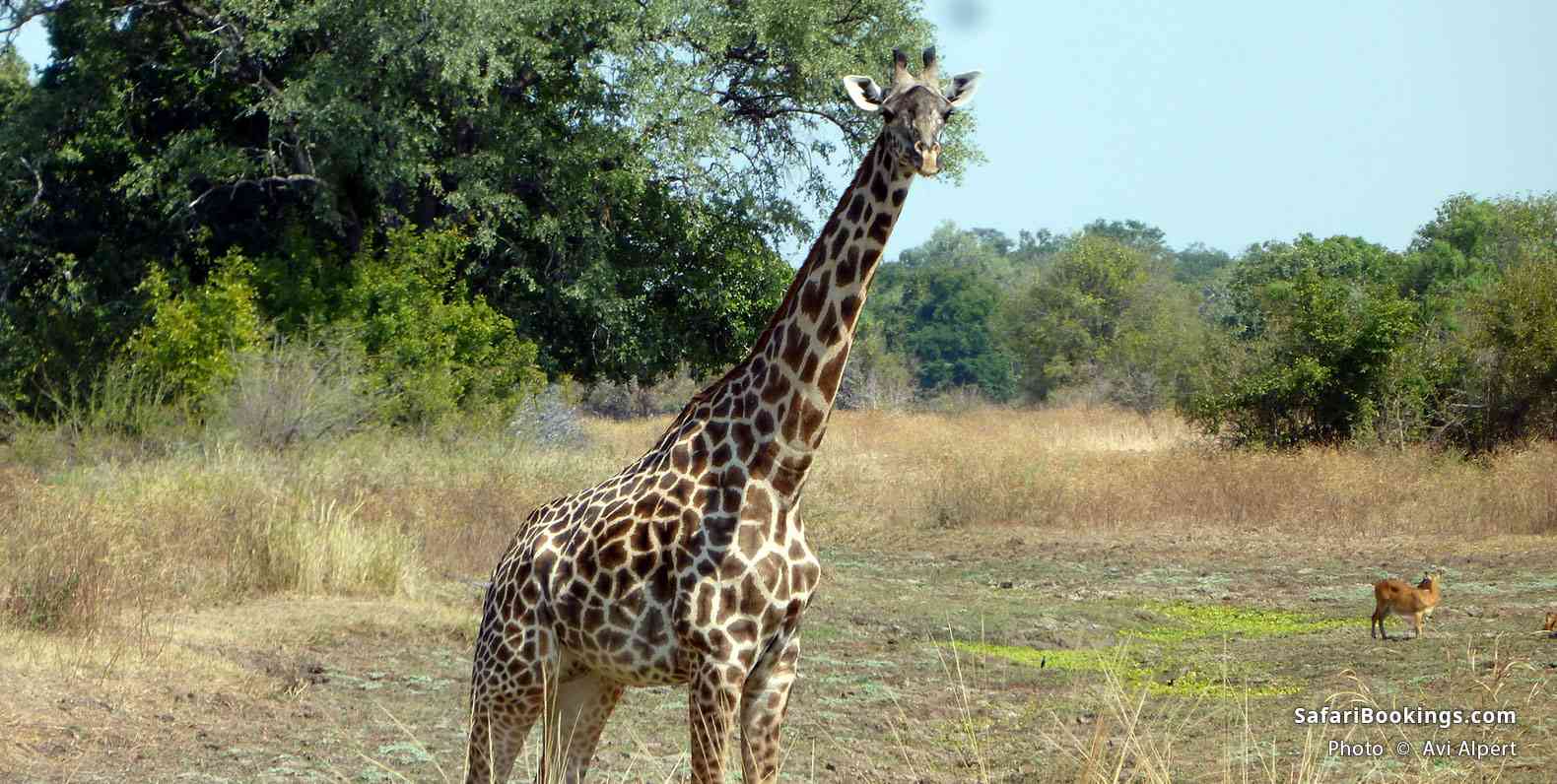
This alluring southern extension of the Great Rift Valley is best known for its guided walking safaris and for the visibility of its leopards. It is also home to the world’s last 550 Thornicroft’s giraffes, an endangered subspecies unknown in captivity or in any other part of Africa.
15 South Luangwa Safaris
9. Giraffe Centre – Kenya

Situated in the leafy northern suburbs of Nairobi, the capital city of Kenya, this family-friendly breeding center has played an important role in the conservation of Rothschild’s giraffes (which are distinguishable by having no markings below their knees). An elevated platform allows day visitors to go eyeball-to-eyeball with the world’s tallest animal, and to check out those long flirtatious eyelashes at close quarters. Breakfast for guests at the high-end, neighboring boutique hotel called Giraffe Manor is frequently interrupted by an inquisitive giraffe poking its head through the window. Once they reach three years old, some of the giraffes are translocated to the wild, including to Lake Nakuru National Park, a few hours’ drive away.
21 Giraffe Centre Safaris
10. Meru National Park – Kenya
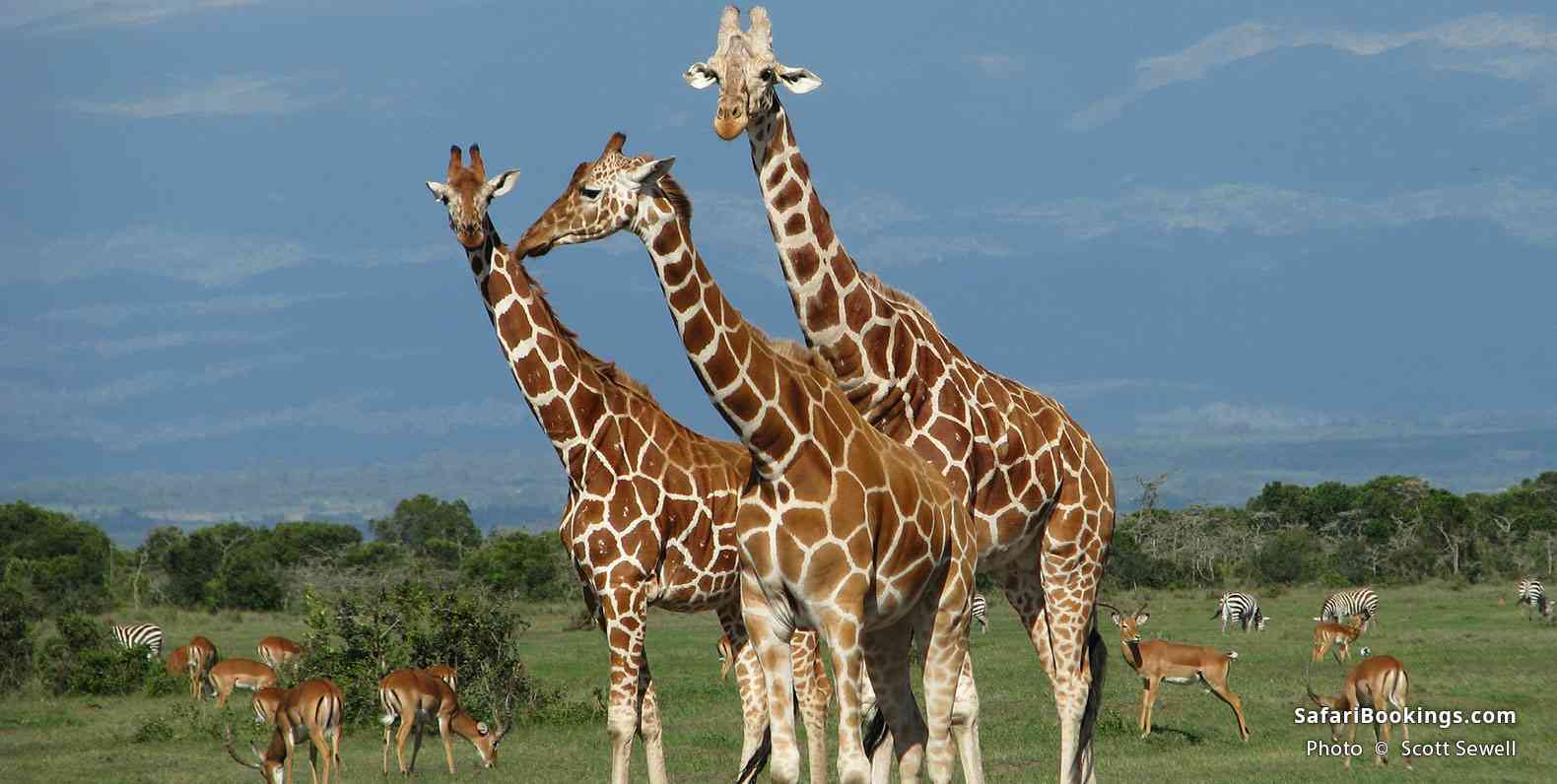
The reticulated giraffe is the most striking and beautiful of nine recognized subspecies. Listed as endangered, it has a distinctive coat pattern of dark orange polygonal spots outlined by clean white lines. Reticulated giraffes once ranged widely across northeast Africa, but are now effectively endemic to northern Kenya. My favorite place to see them is Meru National Park, where small herds stride photogenically between the tall palm trees that line the streams.
15 Meru Safaris
Want To Go on an African Safari?
Click on the button below to compare African safaris offered by top-rated tour operators.
About SafariBookings
SafariBookings is the largest online marketplace for African safari tours. Easily compare offers from top-rated tour operators. Make decisions like a pro by using our 102,889 reviews and 223 destination guides. More About Us
Safaris by Type
- Luxury Safaris
- Budget Safaris
- Gorilla Trekking
- Chimp Trekking
- Family Safaris
- Private Safaris
- Group Safaris
- Photo Safaris
- Overland Tours
- Camping Safaris
- Fly-in Safaris
- Walking Safaris
- Birding Safaris
- Self-drive Safaris
- Canoe Safaris
Most Popular Blog Posts
- Best Time for African Safari
- Best Safari in South Africa
- Family Safari in South Africa
- African Safari Tips
- Game Reserves Near Cape Town
- What to Pack for a Safari
- Best African Safari Parks
- Top 5 Best African Honeymoon Safaris
- Top 5 Best Tanzania Family Safaris
- Best Places to See Cheetahs in Africa
- How Much Does an African Safari Cost?
- Best Places To Visit In Africa in 2024
Blog Categories
African safari tours.

8-Day Custom Safari (Big 5) & Gorilla Trekking in Uganda
$2,706 pp (USD)
Rwanda & Uganda: Private tour Lodge & Tented Camp
You Visit: Entebbe (Start) , Ziwa Rhino and Wildlife Ranch, Murchison Falls NP, Kibale NP (Chimps) , Queen Elizabeth NP, Bwindi NP (Gorillas) , Kigali Airport (End)
Home To Africa Tours and Travel
4.9 /5 – 278 Reviews

7-Day The Great Southern Savannah Economical Safari
$1,958 to $2,379 pp (USD)
Kenya: Private tour Lodge & Tented Camp
You Visit: Nairobi (Start) , Amboseli NP, Lake Naivasha (Naivasha) , Lake Nakuru NP, Masai Mara NR, Nairobi (End)
Mufasa Tours and Travels
4.9 /5 – 385 Reviews

7-Day Journey of the Wildebeest - Mid-Range
$3,550 to $4,420 pp (USD)
Tanzania: Private tour Lodge & Tented Camp
You Visit: Arusha (Start) , Lake Manyara NP, Ngorongoro Crater, Central Serengeti, Serengeti NP, Arusha (End)
Unlimited Expeditions: The Soul of Tanzania
4.9 /5 – 438 Reviews
- Adventure in the Jungles of Africa
- +256 414-253597
- +256 773 064487
- [email protected]
Where to see Giraffes in Uganda
- Kidepo National Park Safaris
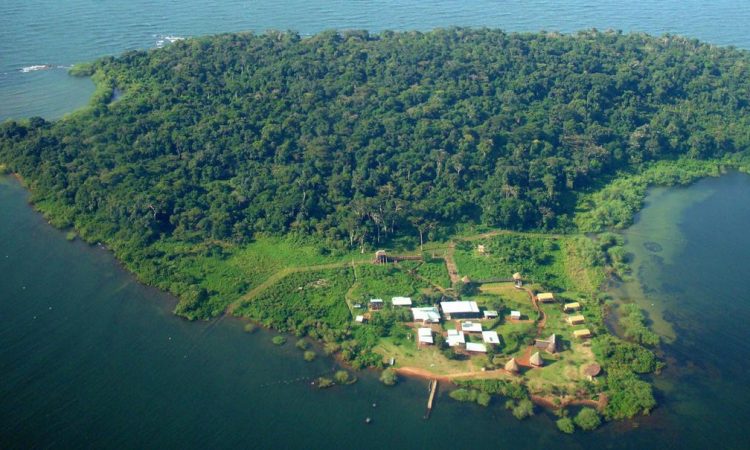
Ngamba Island Chimpanzee Sanctuary

Bird Watching Nyungwe National Park Rwanda
- Latest Safari News
- Nature walking safaris in Uganda
- Short Uganda Safaris
- Uganda Adventure Tours
- Uganda Safari and Tours
- Uganda Safaris
- Uganda Special Rates
- Uganda Wildlife Tours
- Wildlife Safaris in Tanzania
- wildlife uganda
Acacia Safari
- Acacia safari Uganda
- Acacia Safaris
- Acacia Safaris Africa
- Acacia Safaris Uganda
- acacia safaris uganda ltd
- acacia tour uganda acacia safaris ltd
- Adventure in Africa
- Adventure in Uganda
- Adventure Tour
- Adventure Tours
- Adventures of a lifetime
- Africa Adventure Tours
- Africa Cultural Tours
- Africa gorilla trekking
- Africa Holidays
- Africa Safari
- Africa Safari Holidays
- Africa Safaris
- Africa Tour
- Africa Tour Packages
- Africa Trips
- Africa Vacations
- Africa wildlife safari
- Best Africa Safaris
- Best time to visit Africa
- Best time to visit Uganda
- Best Uganda Safaris
- Bird watching tour
- chimpanzee safari
- chimpanzee tour
- chimpanzee tracking
- Chimpanzee tracking in Africa
- Chimpanzee tracking in Uganda
- chimpanzee tracking price
- chimpanzee tracking safari
- chimpanzee tracking tour
- cost of gorilla safari
- cost of gorilla tour
- cost of Uganda safari
- cost of Uganda tour
- cost of wildlife safari
- cost of wildlife tour
- Giraffes in Uganda
- Gorilla Habituation
- gorilla habituation experience
- Gorilla safari
- gorilla tour
- Gorilla Tracking
- gorilla tracking price
- Gorilla Tracking tour
- Gorilla trekking
- Gorilla trekking experience
- Gorilla trekking safari
- Gorilla trekking tour
- Kibale forest national park
- Mountain Gorillas
- Mountain trekking
- Murchison Falls National Park
- Queen Elizabeth National Park
- Uganda Adventures
- Uganda Birding
- Uganda Cultural Tours
- Uganda Gorillas
- Uganda holidays
- Uganda National Parks
- Uganda safari
- Uganda Safari Holidays
- Uganda Tour Packages
- Uganda Trips
- Uganda wildlife
- uganda wildlife safari
- Uganda’s Tourism Sector Fully Opens after Four Months of Lockdown
- Visit Uganda
- WIldlife Tour
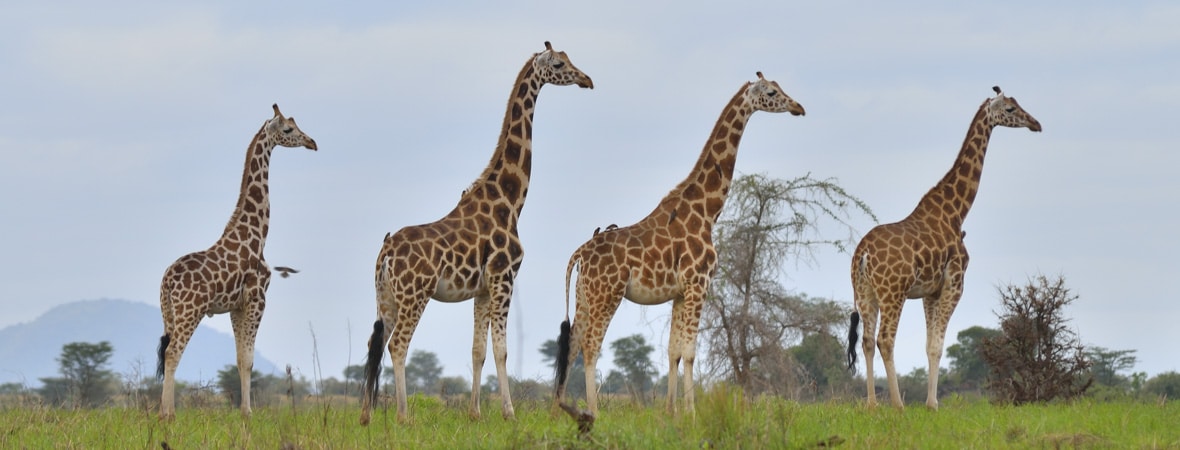
Nubian Giraffe in Kidepo Valley National Park
Am sure you are still confused about where to find giraffes on a Uganda wildlife safari . Giraffes with their beautiful skin and marvelous height are one of the wildlife species in Uganda. The Nubian Giraffe also known as the Rothschild giraffe is one of the most endangered giraffe species. This Giraffe species can be spotted during Uganda wildlife Safaris.
Giraffes are such amazing creatures! Their swaying gait comes in as a result of moving both right legs simultaneously followed by both left legs. Its favorite food is the hideously spiky acacia which it strips of leaves using its long dark purple tongue. Though its neck is very long, it contains just seven vertebrae just like a human being. A newborn giraffe stands at six feet (2m) tall.
In Uganda, giraffes are found in Murchison Falls National Park , Lake Mburo National Park , Kidepo Valley National Park , and the Pian Upe Wildlife Reserve.
Murchison Falls National Park Giraffes in Uganda
In Murchison Falls National Park, it is estimated that over 1500 giraffes are found in the park. In the southern bank where giraffes were introduced in 2016 with an initial seed population of 18 giraffes has 45 giraffes.
Giraffes can be spotted easily during any kind of game drive be it morning or evening while on a tour at Murchison Falls National Park.
Giraffes in Uganda’s Lake Mburo National Park
Initially, the park was known to have giraffes hundreds of years ago but they disappeared due to illegal hunting. In July 2015, 15 giraffes were re-introduced into the landscape for ecological and ecotourism reasons from Murchison Falls National Park. After the birth of at least seven calves, the giraffe population is now estimated at 22.
This reintroduction of giraffes at Lake Mburo National Park was a bold venture by the Uganda Wildlife Authority to expand the range of the endangered Nubian giraffe. Giraffe Conservation Fund is supporting the Uganda Wildlife Authority and a local conservation group to regularly monitor the giraffe population and work with local communities to make giraffes play an important role in the park again.
Though poaching is a general minimum now, the giraffe population will be under pressure from expanding human populations surrounding the park and increasing demand for land.
Kidepo Valley National Park – Giraffes in Uganda
With the civil unrest in neighboring South Sudan in the 1990s the giraffe population in Kidepo Valley National Park was reduced to 3 after illegal poaching. In 2018 after the Giraffe Conservation Fund carried out a census with the Uganda Wildlife Authority, giraffes in Kidepo Valley National Park increased to 36 individuals.
To provide a boost for the populations’ viability, an additional 14 giraffes (13 females and one male) were translocated to the park in August 2018 from Murchison Falls National Park. On a game drive safari in Uganda ’s Kidepo giraffes can easily be spotted in the morning or evening game drive.
Giraffes in Pian Upe Wildlife Reserve – Uganda Wildlife Safari
15 giraffes were translocated to Pian Upe Wildlife Reserve in October 2019. The population here thrives in a very beautiful wilderness that is most less visited but host to great wildlife species.
Giraffes are only one of the Uganda wildlife safari adventures that can be spotted during safaris. There are many other animals including the Big Five that can be seen during Uganda wildlife safaris in the same national parks or other parks.
Other top Uganda safari activities include gorilla safaris in Uganda , hiking, birding, white water rafting, and cultural tours. These can be tailored into the tour with visits to parks that inhabit giraffes in Uganda.
You May Also Be Interested In The Following Packages – Book Uganda Gorilla Safari Packages at a Discount
3 Day Uganda gorilla trekking safari, Uganda safari, Acacia safaris
3 Days Uganda Gorilla Trekking Safari is done in Bwindi Impenetrable National Park which is located in southwestern Uganda a magnificent verdant swathe across the steep ridges of the Albertine Rift Valley. This ancient rainforest is one of the few in Africa to have flourished and home is to half of the world’s endangered population of mountain gorillas.
Looking into the expressive brown eyes of these giants is surely the most exciting and poignant wildlife encounter Uganda has to offer! Apart from the gorilla trekking Tour , the park boasts of 90 mammal species, including 11 primates and prominent bird species.
The 3 Days Bwindi Gorilla Safari Uganda Tour
3 Days Bwindi Gorilla Safari Uganda Tour
3 Days Bwindi Gorilla Safari Uganda Tour takes you on Uganda gorilla tour to Uganda gorilla safaris tour destination for gorilla trekking tours while on your Uganda s afari to Bwindi Impenetrable forest park.
The 3 Days Gorilla Safari Uganda Bwindi Impenetrable Park Tour, Uganda gorilla tour , gorilla safaris, gorilla trekking tours , gorilla safaris, Uganda safaris , gorilla tracking, Gorilla forest camp, where to visit in Africa, attractions in Uganda. Find the gorillas in the marvelous primates.
An encounter with an earth-shaking 350-pound silverback or baby gorilla is an unforgettable experience! view the long-horned Ankole cattle papyrus acacia woodlands and terraced landscape of Kigezi highlands on your way to Bwindi’s impenetrable national park.
Uganda Wildlife Safaris Related Searches
- Uganda Safaris Tour
- Uganda Gorilla Safari Packages
- Uganda Wildlife Safari Packages
- Uganda Birding Safari Packages
- Chimpanzee Trekking Safari Packages
- Long Uganda Gorilla Safaris
- Long Uganda Wildlife Safaris
- Short Uganda Gorilla Safari Tours
- Short Uganda Wildlife Safaris
- Uganda Wildlife Safaris
- 5 Days Best Gorilla Trekking Safaris Uganda
- 5 Days Best Uganda Wildlife Safaris Tour
- 6 Days Best Uganda Adventure Tour
- 7 Days Best Uganda Gorilla Trekking Safari
- 7 Days Uganda Primate Tour
- 8 Days Best Uganda Safari Itinerary
- 9 Days Best Uganda Tour Itinerary
- East Africa Safaris
- Uganda Safari
Related posts
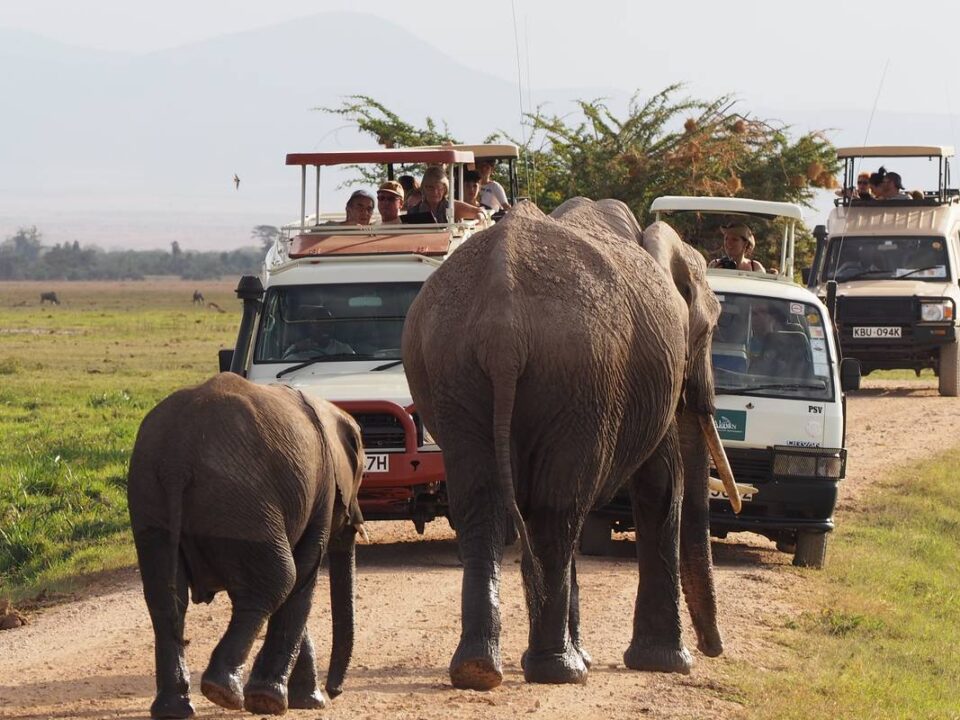
Game drive safaris in Uganda
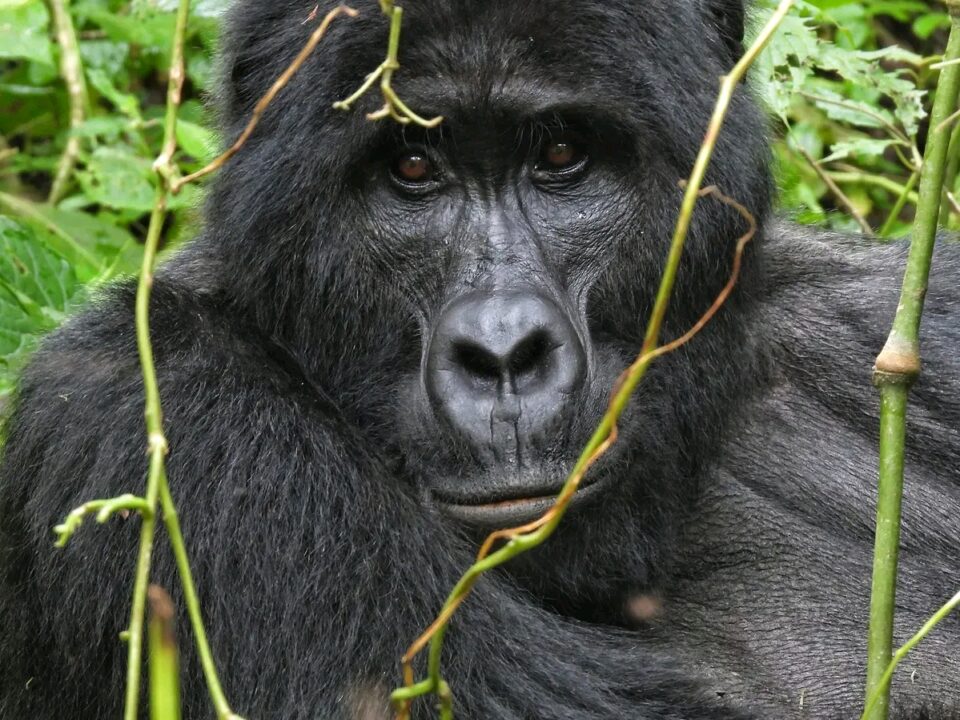
10 Days Best Rwanda Gorilla Safaris
Best Rwanda Gorilla Safaris

8 Days Kenya & Mountain Gorillas
8 Best things to do in Rwanda
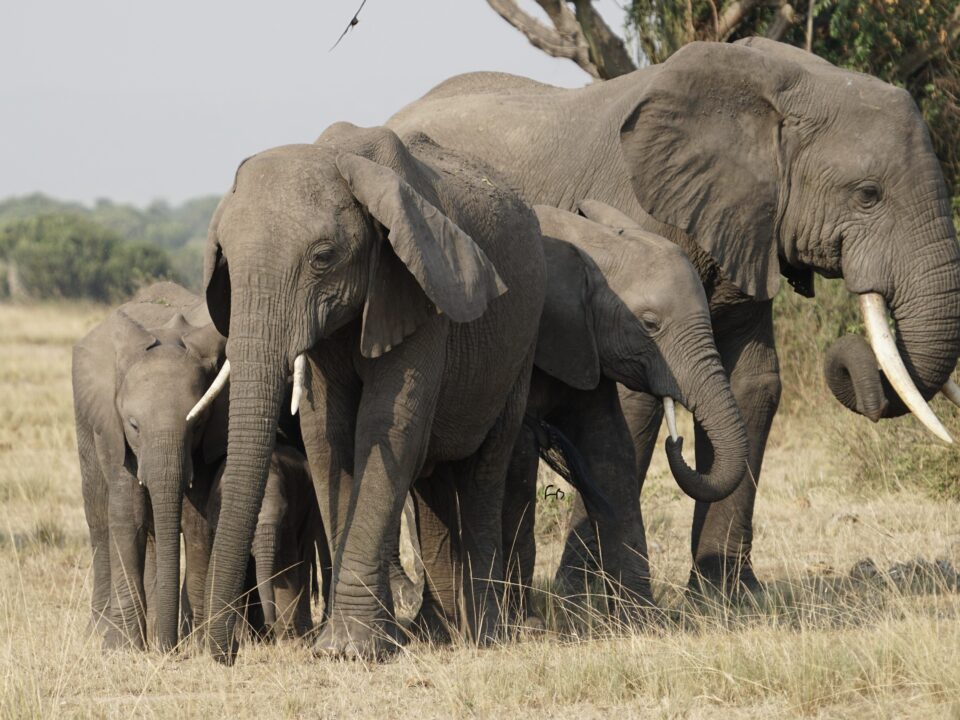
Is Uganda or Kenya better for safari?
Comments are closed.
- +256-392-177-904
- +256-702-613-081
- [email protected]
- Accommodation
- Agent's Section
- Online Payments

Home » Blog » The Rothschild giraffes in Uganda
The Rothschild giraffes in Uganda
The Rothschild giraffes in Uganda : When it comes to rare mammal species in Uganda, almost immediately the mountain gorillas are mentioned. However, in Uganda, with its abundant flora and fauna, lives an even rarer mammal: the Rothschild’s giraffe (also called Uganda giraffe or Baringo giraffe). Today (September 2015), the total number of wild individuals is estimated at around 840 individuals, spread across 13 populations in Uganda and Kenya (in South Sudan, the species is already extinct). This makes the Rothschild’s giraffe one of the rarest mammals in the world. To compare, although still in the danger zone, today more than 900 mountain gorillas inhabit again the Afromontane forests of Uganda, Rwanda and Democratic Republic of Congo.
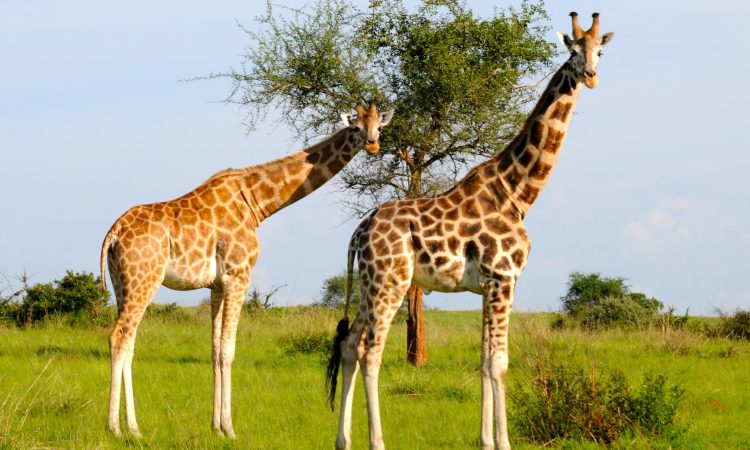
Originally, the Rothschild’s giraffe inhabited the region from the Rift Valley of west-central Kenya across Uganda to the Nile River and northward into southern South Sudan. Nowadays, the Rothschild’s giraffe occurs in the wild only in Uganda while in Kenya small, reintroduced populations occur in mutually isolated, fenced areas, including Lake Nakuru National Park. In connection with inbreeding mixing is required between the Kenyan populations, but unfortunately not possible. The drastic decline of the Rothschild’s giraffe population began in the sixties and seventies of the last century during the civil war. From about 2000 individuals around 1960, the population dropped to about 200 individuals in 1999. Today the greatest threats are the massive human population growth, habitat encroachment, segregation of giraffe populations, severe poaching and human-wildlife conflicts.
Since 2007 the Rothschild’s giraffe is recognized as a species and not as a subspecies. In 2012 the Rothschild’s giraffe was listed endangered by IUCN. If no immediate action is taken, the Rothschild’s giraffe will extinct in the near future. Extra bitter is the fact that there are almost as much of these beautiful animals in zoos around the world as there are in the wild.
In Uganda you can find the Rothschild’s giraffe in the northern savannah parks Murchison Falls National Park and Kidepo Valley National Park. It is the only giraffe species that you can see in Uganda. The wild population in Murchison Falls National Park is according to the Uganda Wildlife Authority estimated at approximately 750 individuals (in 1991 only 78 individuals). The total population in Kidepo Valley National Park in 1995 consisted only of five individuals (400 in 1970). In 1997 three individuals (one male and two females) were translocated from Kenya’s Lake Nakuru National Park. At present time, there is a population of around 65 individuals.

Late June and early July 2015, the Uganda Wildlife Authority translocated 15 Rothschild’s giraffes to Lake Mburo National Park. The purpose is to ensure the conservation of the species by spreading the population across Uganda. By spreading, the population is, for example, less vulnerable for deadly infectious diseases, which could wipe out the largest part of the Rothschild’s giraffe population in Murchison Falls National Park.
In the future, more Rothschild’s giraffes from Murchison Falls National Park will be translocated to Queen Elizabeth National Park and the southern sector of Murchison Falls National Park, located south of the Victoria Nile.
When you visit the Ugandan parks Murchison Falls National Park, Kidepo Valley National Park and Lake Mburo National Park, be aware of the fact that when you see Rothschild’s giraffes, they are the last of their kind. It can not and should not happen that this unique type of giraffe will extinct in the near future.
Uganda Wildlife Authority now seems to be convinced with the seriousness to protect the Rothschild’s giraffe from extinction. It is therefore not to be understood that despite two negative reports in 2011 stating that oil drilling in Murchison Falls National Park will be very harmful for the Rothschild’s giraffe, oil production just continues and has already resulted in destruction of wildlife habitat.

Giraffe Itineraries
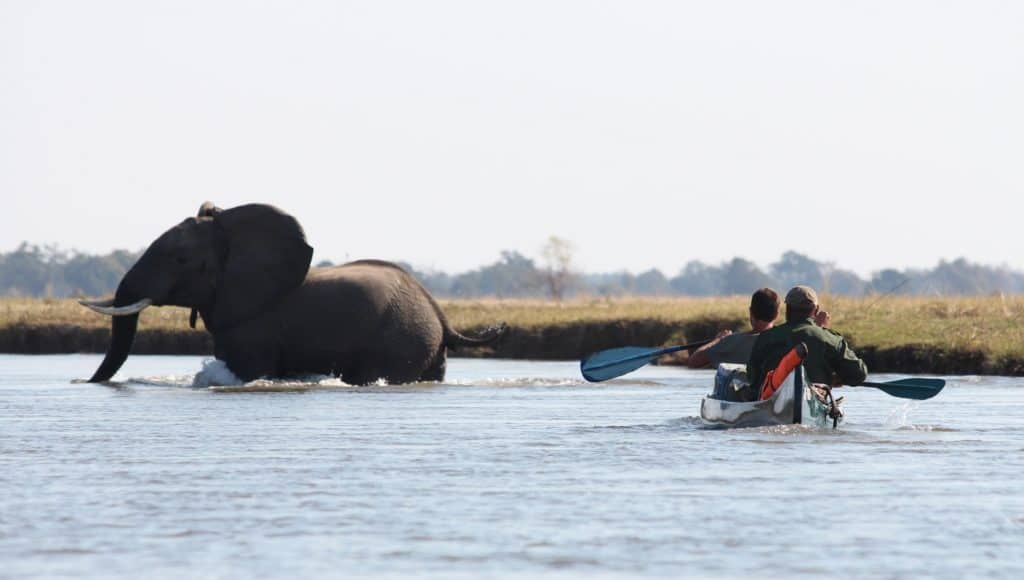
Intrepid Zimbabwe Explorer: Victoria Falls, Hwange and Canoeing Mana Pools (Origins Collection)
Step back in time to the era of exploration with our Intrepid Zimbabwe Explorers itinerary, customized for remote adventure in some of the most pristine wilderness on Earth.
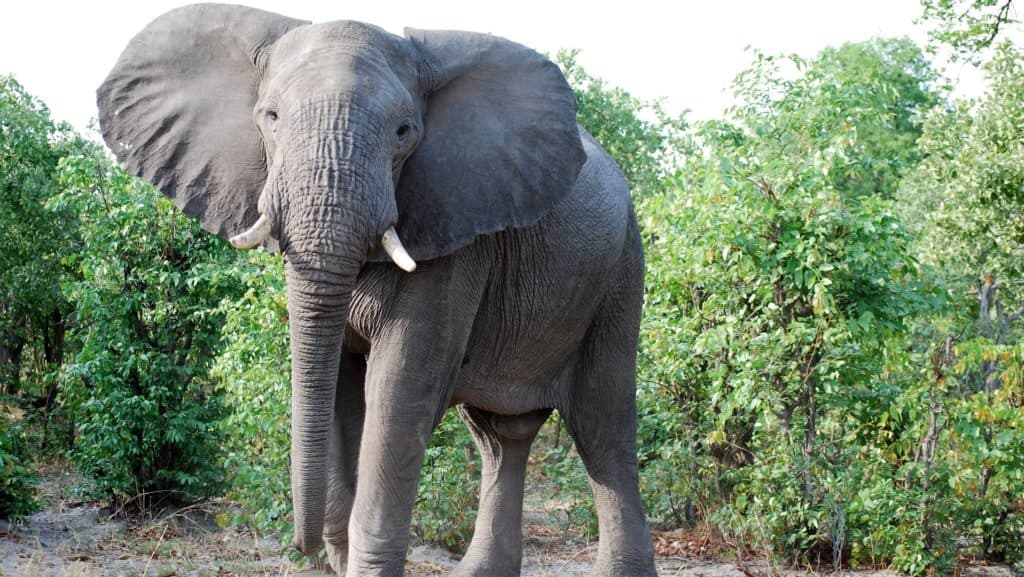
Big Five of Southern Africa
Southern Africa is an incredibly diverse region with varying weather, landscapes, cultures, and wildlife. This itinerary covers three major highlights of Southern Africa: The Greater Kruger National Park, Victoria Falls and the Okavango Delta.
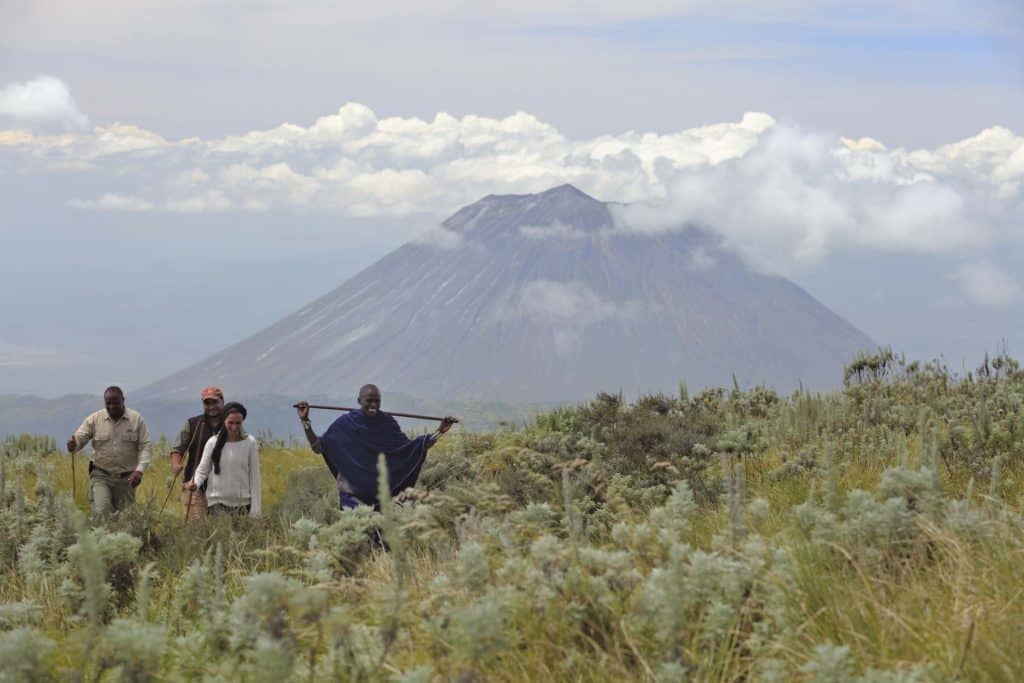
Wonders of the Crater and Trek to Lake Natron with optional Serengeti Biologist Finale (Origins Collection)
Our Tanzania Trekking and Wonders of the Ngorongoro adventure is the very epitome of getting off the beaten track. This adventure takes you on foot through the volcanic landscapes of northern Tanzania, traveling through areas that are impossible to reach by road.
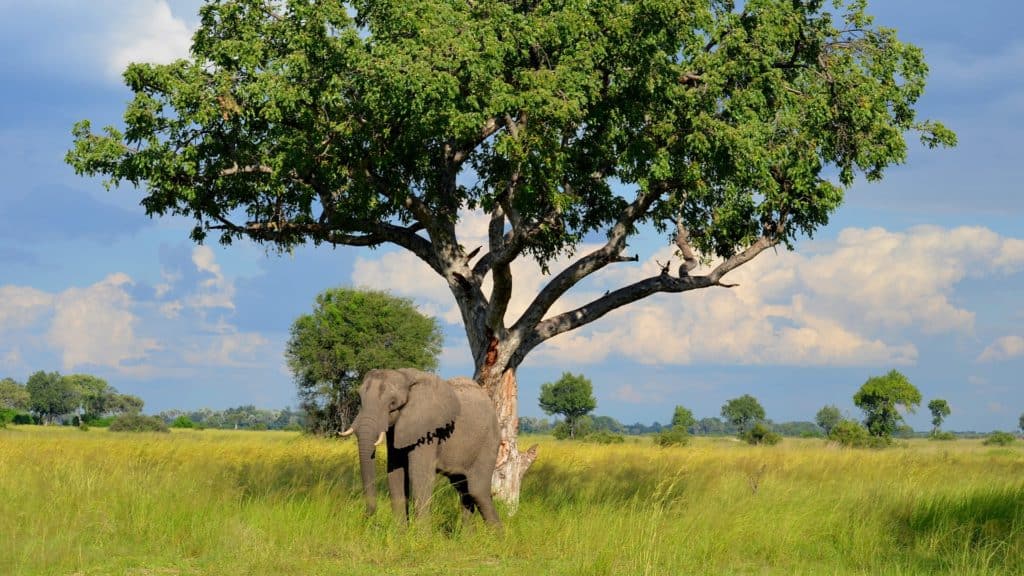
Botswana Elephant Safari
This elephant-focused safari takes you to some of the best locations in all of Africa for seeing and interacting with elephants.
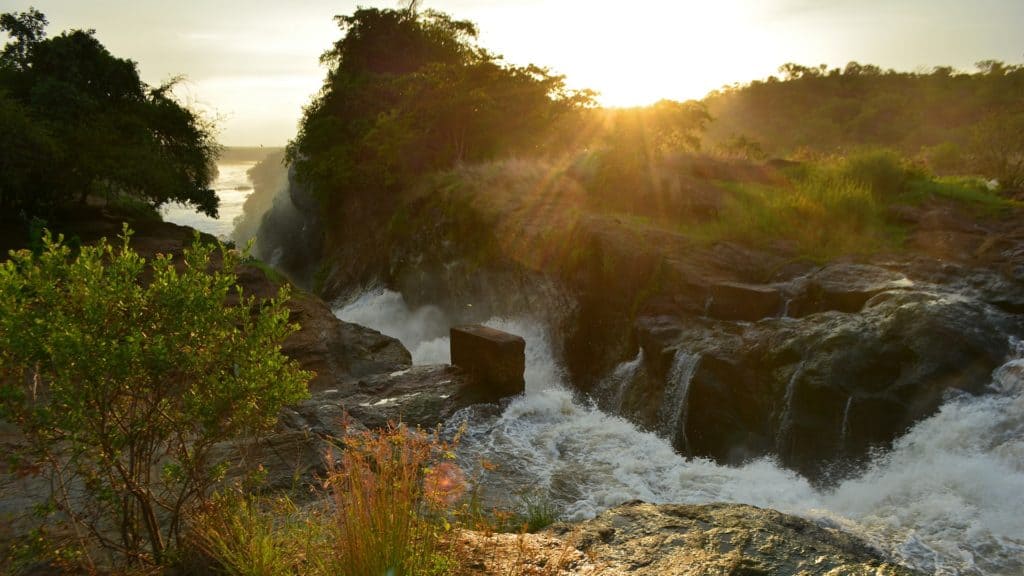
Ultimate Uganda
This safari has been custom designed to provide an in-depth adventure in Uganda featuring some of the most intimate and immersive experiences on the continent – primate trekking.
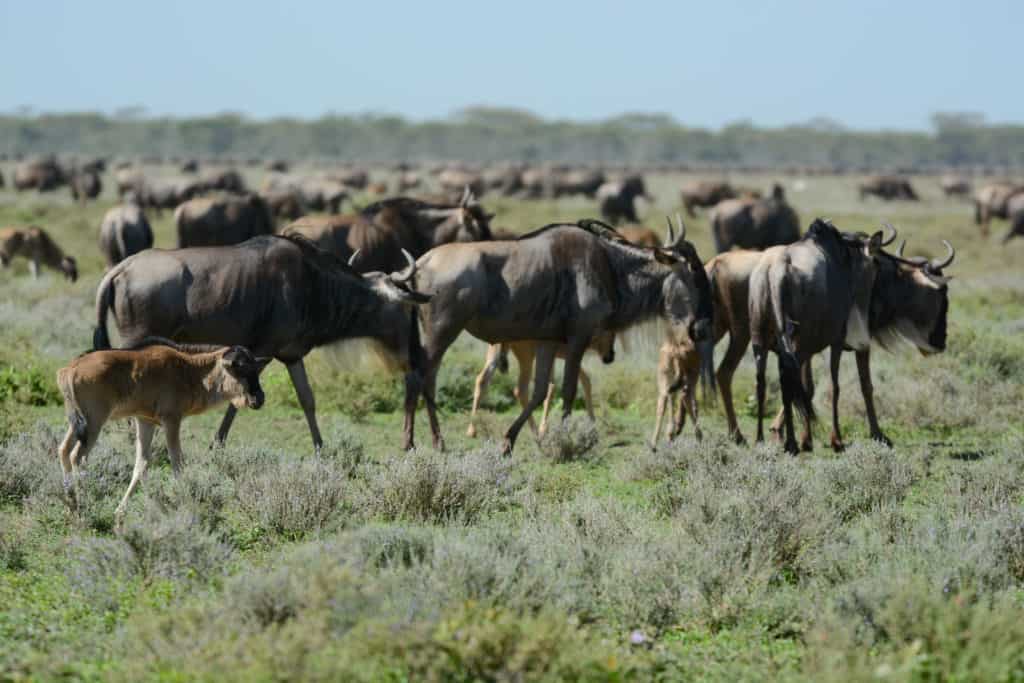
Big Cats & The Great Migration (Calving Season) – Group Trip 2024 (FULL)
The ultimate small group Serengeti adventure with elite biologist guide team, Fadhil Magoye and David Maira. Explore three distinct areas of the Serengeti ecosystem including Ndutu for the Great Migration Calving Season and the world's best cheetah viewing, the Central Serengeti's remote eastern plains and the Northern Serengeti which is incredibly exclusive at this time of year (perhaps the best kept safari secret)! Your guides have an unrivaled passion for the wilds of Tanzania, and the skills and knowledge to match. The knowledge of big cats and overall wildlife behavior between these guides is astounding and they are ready to share it all with their guests on this safari. The group size is guaranteed to be small, with a minimum of 2 and a maximum of just 8 guests.
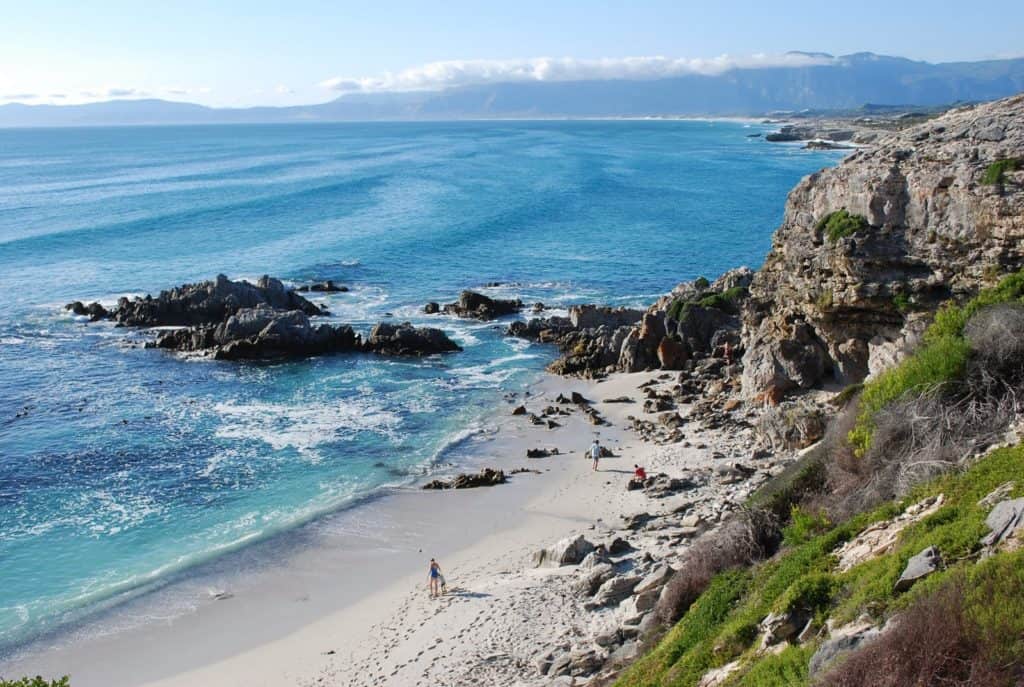
South African Splendor: Cape Town and Sabi Sands Safari
Southern Africa is an incredibly diverse region with varying weather, landscapes, cultures, and wildlife.
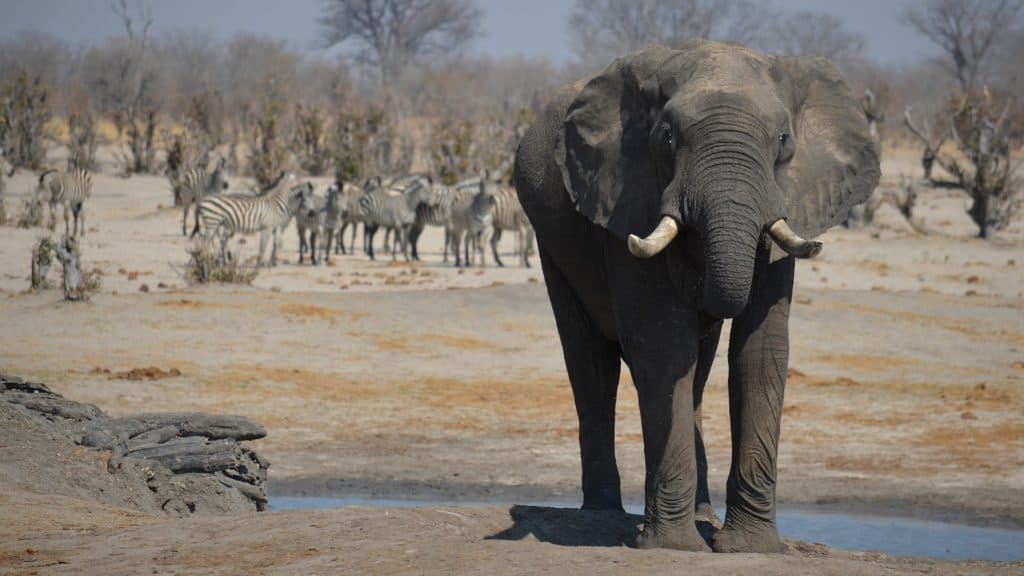
Classic Zimbabwe: Hwange and Mana Pools with Victoria Falls
This adventure-level safari features classic bush camps, thrilling walking safaris, and an excellent value.
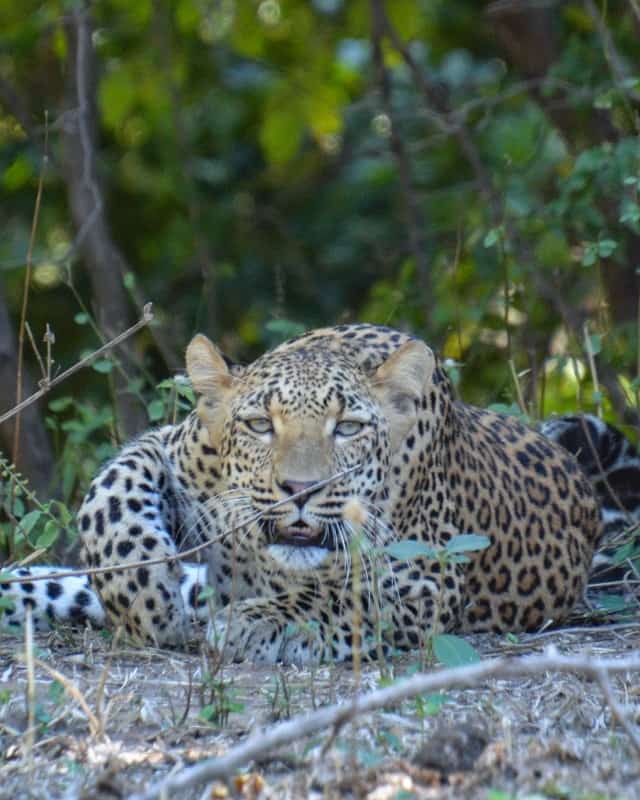
Zambia Walking and Waterways Safari
Zambian safaris are distinguished by the vintage expedition-style adventure delivered under the care of exceptional guides in remote wilderness areas teeming with wildlife.
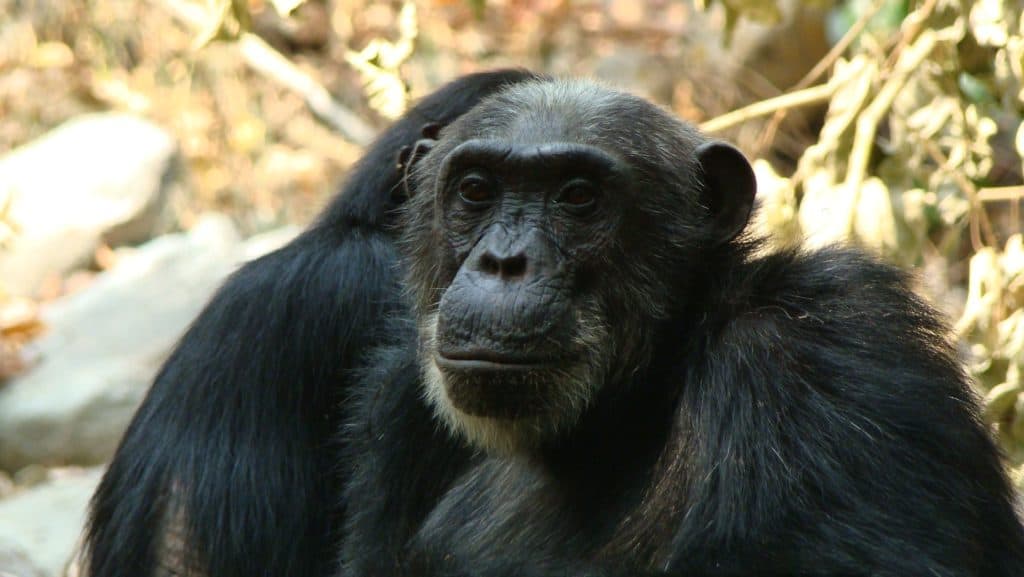
Tanzania Frontier
This safari is the ultimate trip for those who truly want to get away from it all, exploring some of Tanzania's less-visited gems.
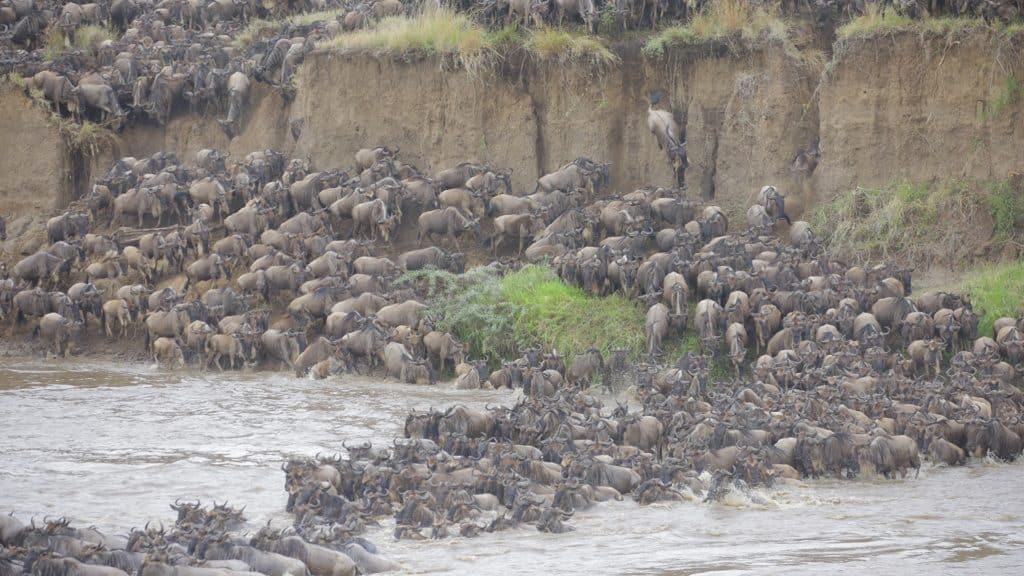
Quintessential Tanzania: River Crossing Season
With the Great Migration of nearly 2 million animals in the area, the Northern Serengeti is the stage for one of nature's most famed events - the dramatic migration crossings of the Mara River.
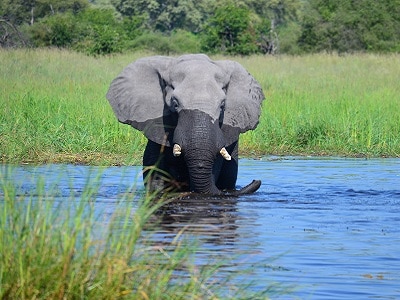
Botswana Desert and Delta Safari: Outstanding Value, Top Wildlife and Diverse Landscapes
This safari is customized to take advantage of the best opportunities for the green season in Botswana to observe diverse wildlife.
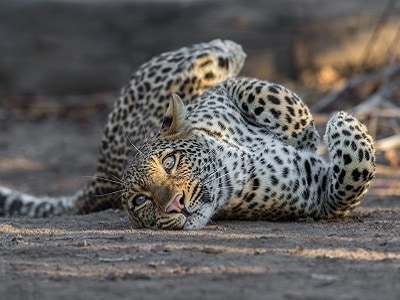
Kenya Luxury For Less
This safari includes some of our favorite unique Kenyan accommodations and a huge variety of activities, all for an incredible discount- over 40% off of the high season rate.
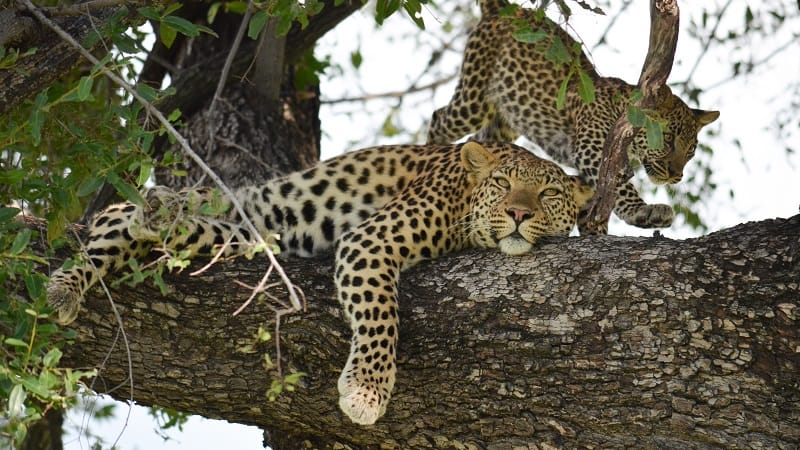
Ultimate East Africa: Exceptional Guiding in Northern Tanzania and the Masai Mara
This incredible itinerary features East Africa's top guides on a private safari through Tanzania and Kenya.
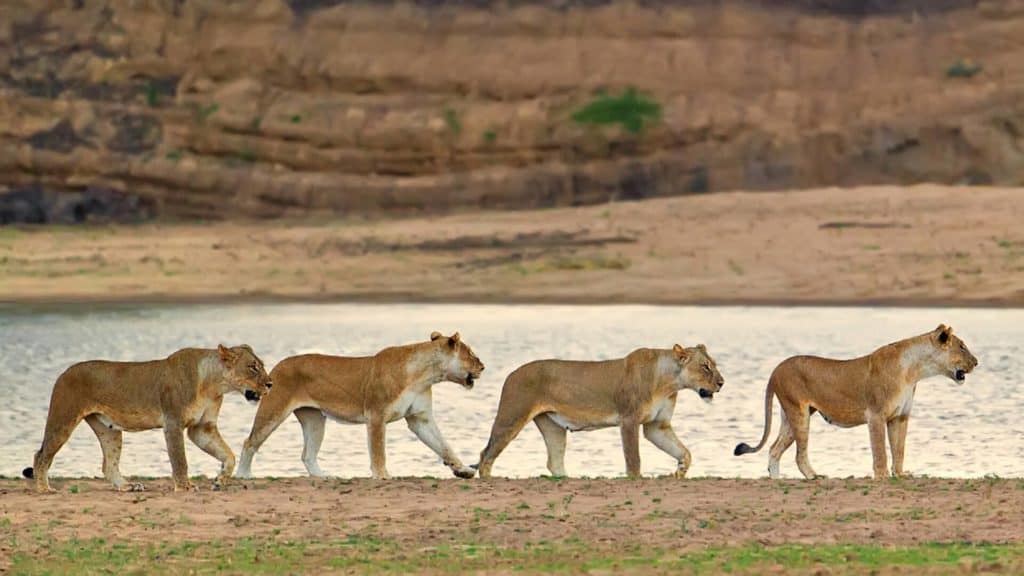
Kenya Family “Lion King” Safari
Kenya is the original safari country and still delivers the classic game viewing experience. This family safari is inspired by Disney's 2019 remake of its classic animated film, "The Lion King."
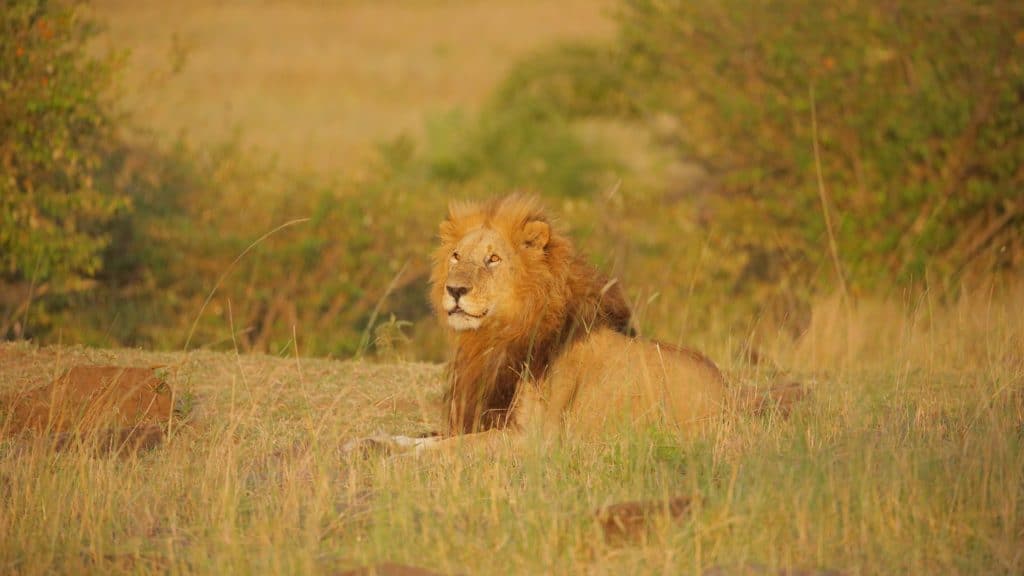
Wild Kenya: Big Cats and Biodiversity in the Mara
Kenya is the original safari country and still delivers the classic game viewing experience. Featuring the Masai Mara Reserve, which is quite likely the most productive wildlife viewing area in all of Africa, this is a superb location for serious game viewing and photography.
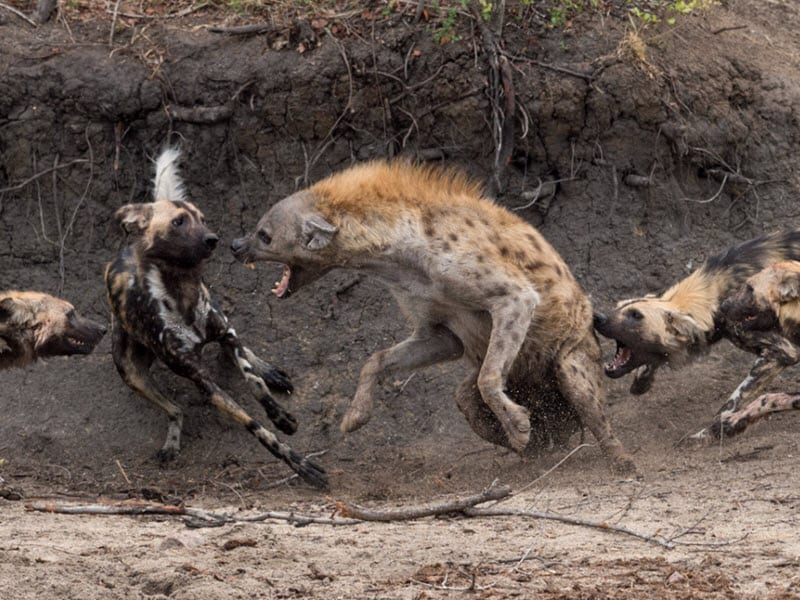
Ultimate Predators of Botswana
This safari includes our favorite private concession areas which have proven to provide exceptional opportunities to view Botswana's iconic predator species including lion, leopard, cheetah, and wild dog.
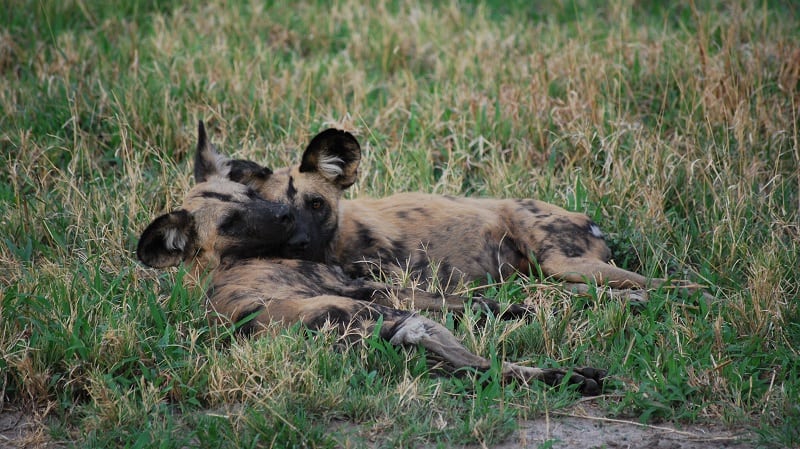
Botswana Exquisite Expedition: Luxury for Less
Explore the great variety of habitats and species Botswana offers. You will likely see between 30 and 35 different mammal species along with a spectacular array of birds and other wildlife.
Giraffe Videos

Best Places to See Giraffes on Safari
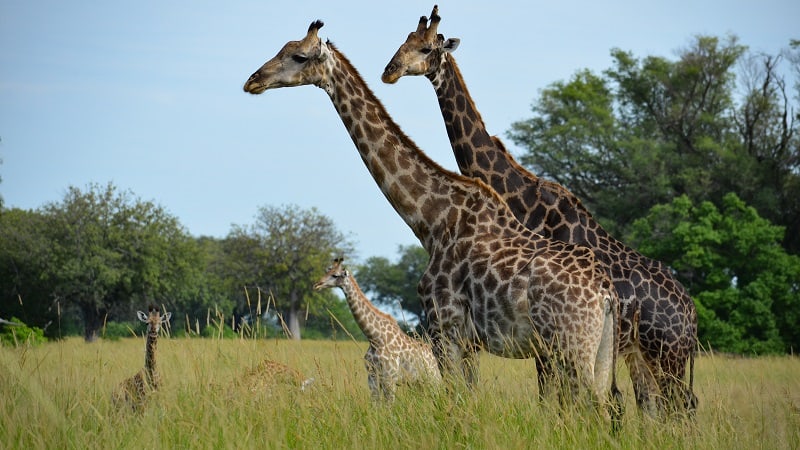
Other Areas of Note
Something extra, learn about other wildlife.
- African Wild Dog
- Cape Buffalo
- Hippopotamus
- Meerkats (Suricates)

wildlife guide to the giraffe
Perhaps the ultimate icon of the African savanna, the giraffe is an unmistakable land mammal known for its long neck and spotted coat. Read on for a few interesting facts about this intriguing animal.
Latin name: Giraffa camelopardalis
Group name: Tower
Size: 4.3 meters to 5.7 meters tall
Weight: 1,192 kg for an adult male and 828 kg for an adult female
Skip to: Characteristics , Range & habitat , Diet , Behaviour , Fun facts , Video

Giraffe characteristics
With nine subspecies sharing its distinctive characteristics, the giraffe is the tallest land animal and the largest ruminant on earth. Considering the length of its neck and legs, the giraffe’s body is quite short. The giraffe sees in colour and its eyes are located on either side of its head, giving it a good view of its surroundings and any approaching predators. Moreover, it has a sharp sense of hearing and smell, another defense against predators, while it can close its nostrils during sandstorms and against ants.
Considering its long neck, it’s no wonder the giraffe has an unusually long tongue – about 45 cm to be exact. Giraffes use their tongues to deftly pick leaves from between thorns.
The giraffe’s coat is characterised by dark blotches on lighter hair. With age, male giraffes may become darker, and while calves inherit spot patterns from their mothers, each giraffe has a unique coat pattern that sets it apart.
Underneath their spotted coats, however, the giraffe is actually gray in colour, with a skin that is quite thick and allows it some protection from thorns.

Range & habitat
With a range that extends all over most of Africa, the giraffe is a staple sighting on any African safari. They are, however, most common in southern and eastern Africa, where the savannas and open woodlands offer the perfect habitat. However, the Angolan giraffe, which occurs in Namibia as well, prefers a more desert environment.
Giraffes have home ranges but are not territorial. Home ranges will vary relative to factors such as rainfall and proximity to humans.
Overall though, giraffes prefer to inhabit savannas and woodlands that are open with foliage like the acacia tree, instead of more dense environments like miombo woodlands.
During the wet season, groups of giraffe may be more spread out, enjoying the resplendent food sources around them. But when the dry season arrives, giraffes are found to congregate around the few evergreen bushes and trees in their area.
Giraffes mothers tend to feed where an area is most open, which gives her a better view over the surroundings and any danger close by.
Giraffes feed mainly on leaves, fruits and flowers of acacia trees, easily reaching up to nibble on the top parts that other herbivores can’t reach. Acacias seem to be one of their favourite sources of food, as well as trees from the Commiphora and Terminalia genera, which provide giraffes with their much-needed source of protein and calcium.
Notwithstanding their long necks, giraffes may also bend down and feed on shrubs and grasses. All in all, they feed and ruminate for most of the day, consuming a total of about 34 kg of foliage every day. However, the giraffe actually needs much less food than other herbivores as the food it does get is much higher in nutrients, while its digestive system is extremely efficient.

Behaviour & lifestyle
When out on safari, keep a lookout for giraffes arranged in groups of calves watched over by one or two mothers. These calving pools are often colloquially referred to as giraffe creches and they allow the mothers to feed elsewhere while a trusted individual keeps a lookout for danger.
For the most part, giraffe herds consist of either related females and their offspring or groups of unrelated adult bachelors. However, the different groups may sometimes come together and gather in larger herds.
Giraffe hierarchies are established by the males through an activity known as “necking” in which two giraffes use their necks as a weapon during fights, swinging and hitting each other. The winning male is dominant and has better access to the fertile females for reproduction. However, when it comes to raising the young, that is solely in the sphere of female giraffes.
Female giraffes give birth to their young standing up. The calf drops to the ground, which severs the umbilical cord. After its mother has groomed and cleaned the newborn, the calf will slowly attempt to stand up, but within a few hours it will be able to run around.
Fun giraffe facts
- Giraffes spend most of their lives standing up, even giving birth standing up. The calves fall up to 2 meters to the floor at birth as their introduction to the world.
- Giraffes don’t need much sleep to function, typically getting less than two hours each day!
- Giraffes can run at speeds of up to 56 kilometers per hour over short distances!
- Like human fingerprints, each giraffe’s spot pattern is completely unique, and no two are the same.
Meet the giraffe
Have you seen a giraffe in the wild? What is your favourite memory of an African safari that involved giraffes? Tell us in the comments below!
Dagg, A. I. (1971). “Giraffa camelopardalis” (PDF). Mammalian Species . 5 (5): 1–8. doi:10.2307/3503830. JSTOR 3503830.
Estes, R. (1992). The Behavior Guide to African Mammals: including Hoofed Mammals, Carnivores, Primates . University of California Press. pp. 202–07 . ISBN 978-0-520-08085-0.
Fennessy, J. (2004). Ecology of desert-dwelling giraffe Giraffa camelopardalis angolensis in northwestern Namibia (Ph.D. thesis). University of Sydney.
Fennessy, S.; Fennessy, J.; Muller, Z.; Brown, M. & Marais, A. (2018). “Giraffa camelopardalis ssp. rothschildi”. IUCN Red List of Threatened Species . 2018 .
Kingdon, J. (1988). East African Mammals: An Atlas of Evolution in Africa, Volume 3, Part B: Large Mammals . University Of Chicago Press. pp. 313–37. ISBN 978-0-226-43722-4.
Kingdon, J. (1997). The Kingdon Field Guide to African Mammals . Academic Press. pp. 339–44. ISBN 978-0-12-408355-4.
Knüsel, Mara; Lee, Derek; König, Barbara; Bond, Monica (March 2019). “Correlates of home range sizes of giraffes, Giraffa camelopardalis “. Animal Behaviour . 149 : 143–151. doi:10.1016/j.anbehav.2019.01.017.
Prothero, D. R.; Schoch, R. M. (2003). Horns, Tusks, and Flippers: The Evolution of Hoofed Mammals . Johns Hopkins University Press. pp. 67–72. ISBN 978-0-8018-7135-1.
Simmons, R. E.; Scheepers, L. (1996). “Winning by a Neck: Sexual Selection in the Evolution of Giraffe” (PDF). The American Naturalist . 148 (5): 771–86. doi:10.1086/285955.
Skinner, J. D.; Smithers, R. H. M. (1990). The mammals of the southern African subregion . University of Pretoria. pp. 616–20. ISBN 978-0-521-84418-5.
Swaby, S. (2010). “Giraffe”. In Harris, T. (ed.). Mammal Anatomy: An Illustrated Guide . Marshall Cavendish. pp. 64–84. ISBN 978-0-7614-7882-9.
Williams, E. (2011). Giraffe . Reaktion Books. ISBN 978-1-86189-764-0.
Top countries for safaris
- Botswana safaris
- Kenya safaris
- Namibia safaris
- South Africa safaris
- Tanzania safaris
- Uganda safaris
Safari basics
- Safari animals
- How to find the right safari company
- When to go on safari
- What to take on safari
- Safari clothing – what to wear
- Safari rules & etiquette
- Wildlife spotting tips
Most read articles
- All about the ‘big five’ animals
- Collective nouns for animals
- Safari movies to watch before you go
- The world’s fastest land animals
- Apex predators
- 10 Fascinating African tribes
- The biggest animals in the world
- 17 Epic hybrid animals
- The world’s ugliest animals
- Why are flamingos pink?
Africa’s best game reserves
- Chobe National Park, Botswana
- Etosha National Park, Namibia
- Kruger National Park, South Africa
- Masai Mara National Reserve, Kenya
- Moremi Game Reserve, Botswana
- Okavango Delta, Botswana
- Serengeti National Park, Tanzania
Session expired
Please log in again. The login page will open in a new tab. After logging in you can close it and return to this page.
One of Africa’s most recognisable animals, the Giraffe
With their unique and beautiful colouring, giraffes are one of Africa’s most recognised animals. As the tallest animals on the planet, standing at between 14 and 19 feet (4.2 to 5.8 metres) they’re hard to miss. They use there impressive height to browse on leaves and shoots from the very tops of trees that few others can reach – a favourite of giraffes is the acacia tree. The other adaptation that helps giraffes feed on these leaves is their 21 inch tongue – which is very rough, protecting it from thorns. Given their size, giraffes are almost continuously eating in order to consume enough food. As a result, they have cover large distances to find enough.
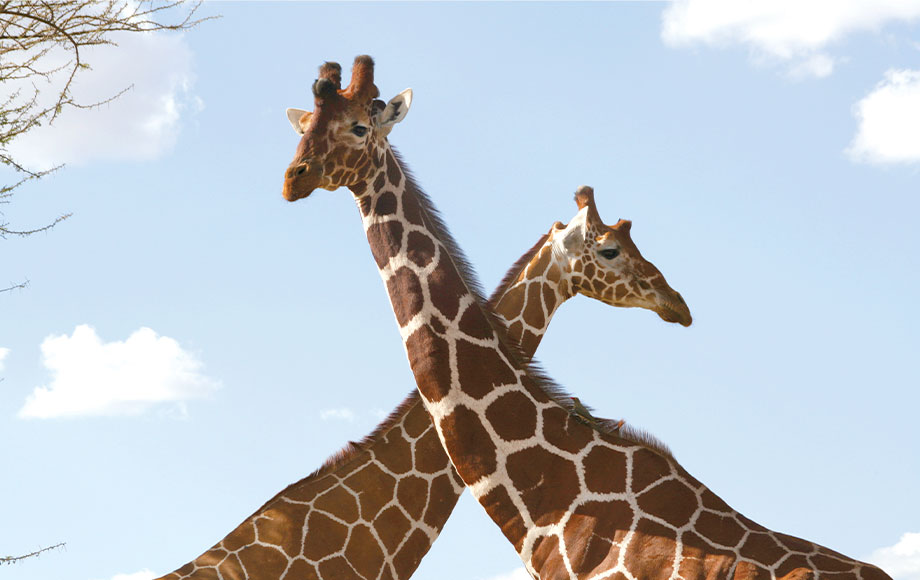
Common Name – Giraffe
Scientific Name – Giraffa camelopardalis
Current IUCN Red List Status – VU
Estimated no. of mature individuals – 68 ,000 – studies suggest a declining population.
Though there are few predators to worry about, giraffes do keep a look out for big cats – some lions have been known to specialise in hunting giraffe. This is particularly true when it comes to drinking from rivers or shallow pools. Their large hulking frames put them at a significant disadvantage and to drink at a water source, they must spread their legs awkwardly to bend down and drink – making them vulnerable to predators. To combat this need for water, giraffes absorb most of their water from plants and therefore do not need to drink from a water source every day.
Giraffe Viewing on Safari
Giraffe viewing depends on where you are in Africa – as there are 9 subspecies of giraffe. Recent research has suggested however that some of these may actually be distinct species in their own right. Physically, giraffe subspecies differ in their size and pattern. The two most common species in East Africa (Kenya and Tanzania) is the Masai giraffe and the Reticulated Giraffe. The Masai giraffe is significantly darker than other species while their patches have a distinct vine leaf shape with jagged edges. The Reticulated giraffe, found in central, north and north-eastern Kenya is recognisable by its neat and clear orange-brown patches, which are separated by clear white lines.
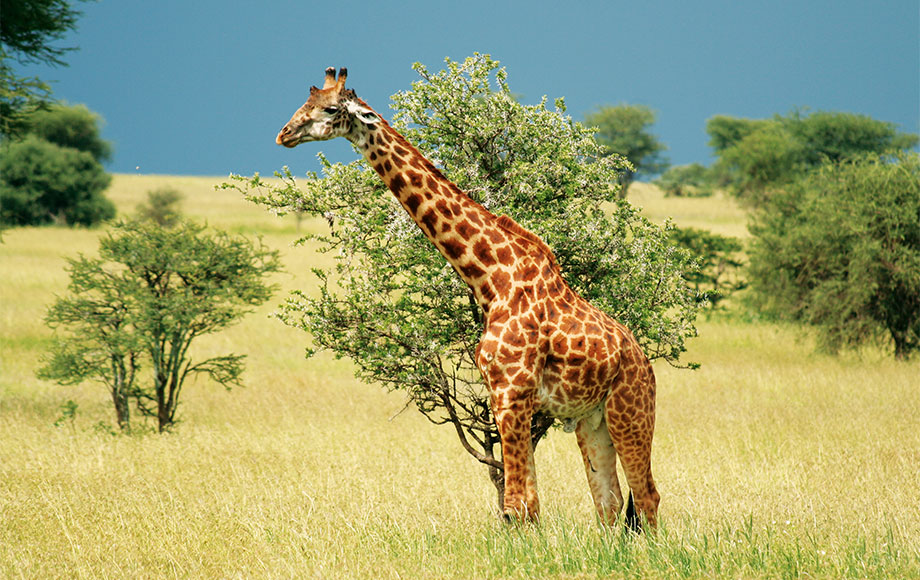
Contrary to the two species mentioned above, the South African giraffe (found throughout many southern African countries) has distinct patches in varied shapes and sizes that spread down its legs.
Non-territorial, giraffes are gregarious animals that often live in groups (called towers) ranging from 5 or 6 up to 20 individuals – if you spot one giraffe you are likely to spot a few more nearby. They can be found in many national parks and reserves throughout Africa in varying numbers. Renowned Giraffe Manor holds the unofficial title of the most “unforgettable bucket-list breakfast experience in the world” for good reason. The property is a sanctuary for the highly endangered Rothschild giraffe who join guests for a memorable breakfast, poking their heads through the windows in search of a snack.
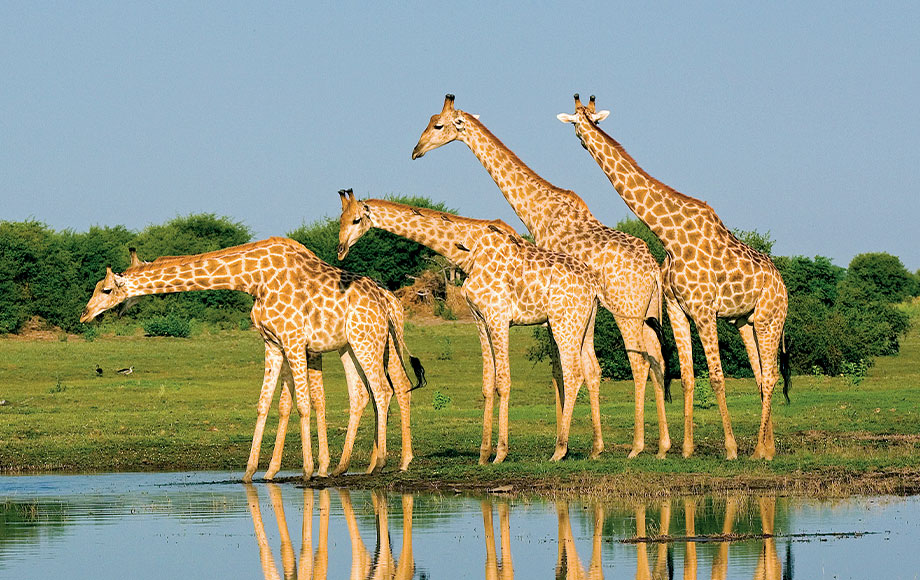
Best safaris to see giraffes
Ker & downey botswana.
Experience this authentic 7 day Okavango Delta safari with Ker & Downey Botswana, one of the country's most respected operators.
Desert & Delta Safari Botswana
Discover epic wildlife in the Okavango Delta, Moremi Game Reserve and Savute with Desert & Delta Safaris, one of Botswana's most respected operators.
Highlights of Kenya
Discover the Highlights of Kenya on this classic safari itinerary, taking in the Samburu National Reserve, Mt Kenya, Lake Nakuru and the renowned Masai Mara.
Best of Kenya and Tanzania
This safari combines the best wildlife experiences of Kenya and Tanzania, including the Samburu, Lake Nakuru, the Masai Mara and Serengeti.
Kruger and The Cape
Discover some of South Africa's best known attractions on this journey that begins with a big game safari in the world-renowned Sabi Sand and concludes in beautiful Cape Town.
Best places to see giraffe
Ultra-luxurious, Moroccan-themed Sasaab is a stylish oasis in the heart of Kenya’s desert-like northern wilderness, lying just west of the breathtaking Samburu National Reserve.
Giraffe Manor
This boutique hotel is a Nairobi icon and offers one of the city’s most unique experiences: the opportunity to feed and walk with rare Rothschild's giraffe.
Selinda Camp
Selinda Camp is located in the breathtakingly unspoilt Selinda Reserve, home to some of Africa’s largest herds of elephant and buffalo, as well as rare African wild dog.
Lemala Mpingo Ridge
Sitting at the top of an escarpment with sweeping views across the perennial Tarangire River and valley below, Lemala Mpingo Ridge offers not just sensational views but outstanding standards of
Mara Plains Camp
In the heart of big game country, ultra-luxurious Mara Plains Camp sits on a bend of the Ntiakitiak River on the northern border of Kenya's Masai Mara.
Elephant Bedroom
Shaded by doum palms on the banks of the Uaso Nyiro River, upscale Elephant Bedroom Camp occupies a prime position in the stunning Samburu National Reserve.
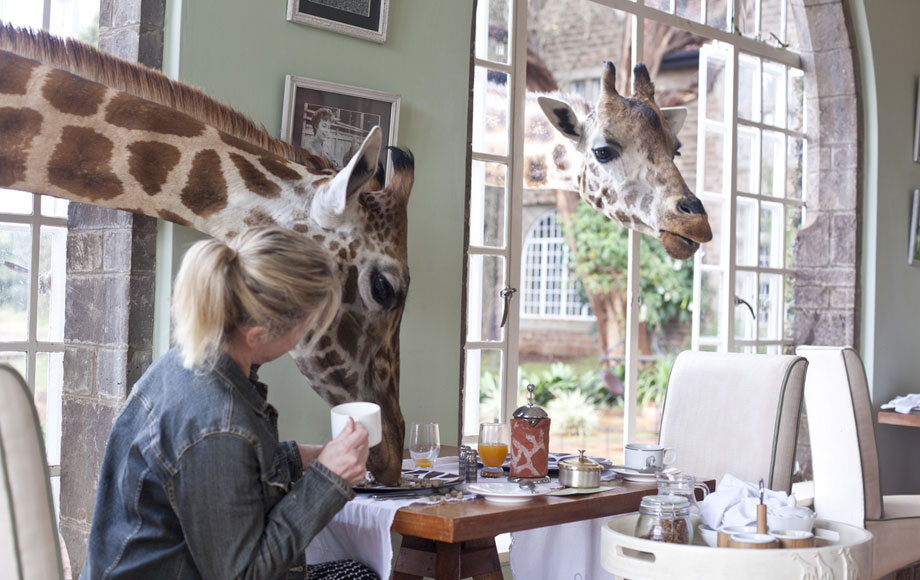
Where is Giraffe Manor?
Giraffe Manor is one of the most sought-after hotel stays in Africa. It is an exclusive boutique hotel located in the suburbs of the Kenyan capital of Nairobi. Built in 1932 as a colonial hunting lodge, today Giraffe Manor is a Nairobi icon and offers one of the city’s most special experiences. What sets Giraffe Manor truly apart is its herd of endangered Rothschild’s giraffe, who are known to join guests for breakfast or for a cheeky snack through open windows or doors. Giraffe Manor is a fantastic addition at the beginning or end of any Kenyan safari.
Unique Adaptations
Fighting Gravity and adjusting pressure Giraffes have a number of unique adaptations in their circulatory system to fight against gravity in order to pump blood. Elastic and muscular arteries above the heart pump blood up the neck –fighting against gravity. The arteries below are the opposite – narrower with thick walls – that can bear high pressure, preventing blood from pooling. Giraffes have a complex network of elastic vessels that expand when they lower their heads, this prevents blood from flooding the brain.
Super Heart Relative to its size, the giraffe has quite a small heart – weighing just 11 kilograms. Giraffes have extremely high blood pressure (twice that of a humans) as they need to maintain blood flow against gravity. Looking more closely, the left ventricle of the heart has thick muscular walls in order to pump blood up to the head and then around the body. In comparison, the right ventricle is thinner and only pumps blood to the lungs. Their heart beats up to 170 times a minute.
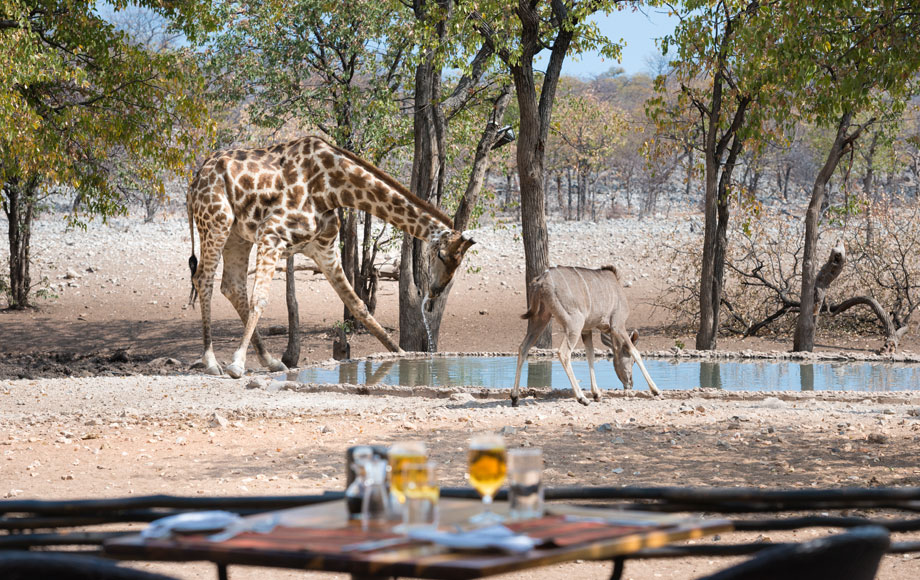
Giraffe Facts:
Tallest Animal Giraffes are the tallest mammals on Earth, standing at between 14 and 19 feet (4.2 to 5.8 metres) they’re hard to miss!
Standing sleepers Adult giraffes require less sleep than other mammals. There is some debate as to the exact amount, but research has suggested it is somewhere between 1 to 3 hours in a 24 hour period. Most of this sleep however is taken in short naps while they stand. They will arch their necks around and rest their heads on their rear end.
Surprisingly speedy Ungainly in appearance and particularly when in motion, giraffes don’t appear at first glance to be the fastest runners. However, their long legs do along them to reach a top speed of 35mph (56 kph), but only for a short time.
Horns? What horns? A giraffes “horns” are actually knobs that are covered with skin and hair. These knobs protect their head and eyes from injury.
Find out more about our tailor made African safaris. Get in touch with one of our Destination Specialists.
Subscribe below to keep up to date, find out more about our tailor made african safaris, more wildlife.
The Cape buffalo is a member of Africa’s “Big 5” and therefore a must-see for any safari-goer.
Cape Buffalo
The Cheetah is the fastest land animal on the planet and one of Africa’s most well-known and sought-after sightings when on safari
African elephants are the world’s largest land mammal and were once numerous, roaming across the whole African continent.
With their unique and beautiful colouring, giraffes are one of Africa’s most recognised animals.
Grizzly bear or grizzly is the name given to the subspecies of brown bear that inhabits North America.
Grizzly Bear
The largest cat in the Western Hemisphere, jaguars are strongly built, well-muscled predators native to the Americas
King Penguins don’t actually live on the Antarctic ice shelf, instead they prefer the sandy snowless beaches of the Sub-Antarctic islands.
King Penguin
Lemurs are endemic to the island nation of Madagascar where 107 species can be found. However each individual species is often only found in a
Leopards are graceful cats and still geographically wide-spread across Africa, including isolated parts of Morocco and Egypt.
A member of the “Big 5” and perhaps Africa’s most iconic species, the African Lion is a highly sought after sighting while out on safari.
Meerkats are found in Southern Africa and they are often seen standing on their rear legs, forever gazing out over the sweeping plains.
Orcas, informally referred to as killer whales because of their fearsome reputation, are majestic mammals.
Polar bears are found in the Arctic regions of Canada & Europe. The majority of their population are found in Canada, particularly around the
Impressively large and with horns for a nose, these prehistoric looking creatures are one of the most iconic African animals.
E-Newsletter
Sign up to receive updates about exciting journeys, special offers and more

- Ready-made safaris
- Experiences
- Special offers
- Accommodation
- Start planning
- Booking terms
- When to go on safari - month by month
- East or Southern Africa safari?
- Solo travellers
- Women on safari
- Accommodation types & luxury levels
- General tips & advice
- All stories
- Afrika Odyssey Expedition
- Photographer of the Year
- Read on our app
- 2024 entries
- 2024 details
- 2024 prizes
- 2024 entry form
- 2023 winners
- Collar a lion
- Save a pangolin
- Rules of engagement
- Job vacancies
- Ukuri - safari camps

Celebrating the planet's tallest creature

Tuesday, 7 February 2023
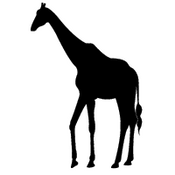
Millennia of evolutionary problem-solving have conferred upon animals a weird and wonderful array of adaptations from trunks to tails and patterned coats to thick fur. Predators have been equipped with offensive weaponry, and prey species are similarly prepared to defend themselves in an eternal evolutionary arms race. The peculiar, unique creatures on the planet have been shaped by innumerable overlapping conditions never again to be repeated – every living thing is the product of circumstance. And perhaps nowhere is this more apparent than the giraffe, one of Africa’s most fantastical offerings.

In the know
As the tallest animal on Earth, giraffes do not exactly keep a low profile and probably need little by way of introduction. Their leggy silhouettes have appeared in some of the most iconic images of the continent, hordes of tourists have marvelled at their outlandish shapes, and cartoon representations abound. Yet despite their rather significant stature, these quiet and unassuming herbivores spent much of the 20 th century flying under the conservation and ethological radar. They are perhaps one of the most under-studied large mammals in Africa, and scientists are only now beginning to unravel the secrets of their social lives and communication. Worse, it is only in the last decade that the reality of their “silent extinction” has made it into the public eye.
Giraffes are possibly one of the most intriguing animals on safari. While we are far from knowing everything there is to know, recent scientific discoveries around their complex physiology and behaviours are endlessly fascinating.

Quick facts
The fast-walking leopard camel.
The common name “giraffe” comes from the Arabic word zarāfah , meaning “fast-walker”, but it is the scientific name that is particularly entertaining. Until recently, all giraffes were considered one species (more on this later): Giraffa camelopardalis . “Camelopard” is an archaic English name for the giraffe, derived from Greek and referring to the giraffe’s physical similarity to a camel and the spotted, leopard-like colouration (from pardus , meaning “spotted” or “mottled”).
The characteristic pattern of dark patches on a lighter background – slightly different for each species – probably serves a thermoregulatory function, as the darker patches are rich in large sweat glands. The camel comparison is particularly relevant to their walking styles – giraffes and camels move both legs on the same side of the body simultaneously in a gait known as pacing. This confers a rocking motion to their movement and means that while they can gallop, they cannot truly trot in the way a horse or zebra can. Naturally, having legs over two metres long implies that even a leisurely stroll qualifies as fast walking. Still, giraffes can also reach speeds of over 60km/hour when forced into a reluctant run.
Despite this (admittedly tenuous) similarity, camels and giraffes are only very distantly related as members of the Artiodactyla (even-toed ungulates). The closest relative of all giraffe species is a bizarre and endangered animal called an okapi , found only in the highland forests of the Democratic Republic of the Congo.

Why the long neck (and legs)?
The famous question that has dominated scientific interest in giraffes since the Galapagos finches first lit the fire of Darwin’s interest in evolution. Giraffes proved to be the textbook example of how a physical trait of some individuals (height, stripes, spots) conferred an advantage and, over many thousands of years, became the signature look of a species. So, during times of nutritional stress, slightly taller giraffe ancestors could reach leaves above the reach of their competitors. Thus, they survived and passed the “tall gene” onto their offspring.
This is, of course, a massive oversimplification and a bit unfair to Darwin to boot. For a start, Darwin was more impressed by the giraffe’s tail as a perfectly designed flyswatter and only focussed on the giraffe’s neck in a later argument with a staunch critic . Extracting the “reasons” why an animal evolved to look the way it does will invariably produce competing theories and disagreements. It is also impossible to look at the contemporary advantages of an evolved trait and assume these explain its evolution.
As it turns out, long necks confer several advantages. For example, they increase the momentum and power of the devastating blows delivered by fighting males to rivals, suggesting a sexual competition element. A long neck (and good eyesight) is also helpful for keeping an eye out for predators. The increased surface area may aid heat dissipation to assist thermoregulation in warm climates. In simple terms, we don’t fully understand how the giraffe came to stand as tall as it does.
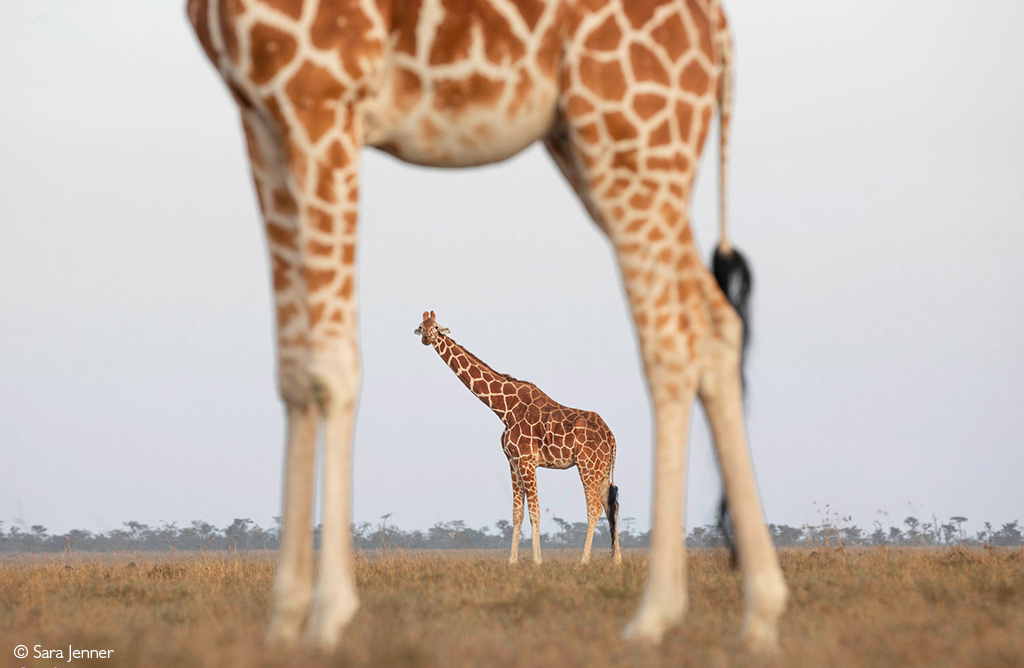
Gotta keep your head up
We know that the evolution of the giraffe’s six-metre height necessitated several further physiological adaptations to deal with the resultant physics. Though a full exploration of these features is beyond the scope of this article, it essentially comes down to fluid dynamics and gravity. Each of the seven cervical vertebrae can be over 28cm long, and together, these neck vertebrae comprise over 50% of the entire length of the vertebral column, raising the brain two metres above the heart. The hooves lie roughly the same distance below the heart on the opposite end.
Giraffes have relatively large hearts (though not that much heavier than would be expected for an animal of their size) and mean average blood pressure twice that of other mammals . Their heart rate ranges between 40-90 beats per minute, which is also quite fast for an animal of their size (a resting horse’s heart rate rarely goes above 20 beats per minute, by comparison). This ensures that the brain is well supplied, despite its lofty position. Tight, thick skin around the legs prevents fluid from accumulating and encourages its return to the heart via the venous network. Enormous neck veins, a muscular jugular and robust valves also help prevent the giraffe from fainting when assuming its awkward straddle to drink.
Blood flow aside, a neck that long results in several other challenges. The amount of “dead space” (the parts in our respiratory system not participating in gas exchange – the trachea, bronchi, etc.) increases due to the long trachea. As a result, giraffes have a much larger tidal volume (air breathed in and out) to compensate. As ruminants, they also have an unusually muscular oesophagus to transport the balls of cud back into the mouth.
Giraffes have a highly developed nuchal ligament that runs from the back of the head to the spinal processes of the shoulder vertebrae. The stiff band of elastic tissue helps support the muscular and heavy neck without the giraffe having to invest any energy in holding its head up. However, they need to contract these muscles against the force of the ligament to lower the head. This may have led to the misconception that giraffes sleep very little and seldom lie down. However, research shows that giraffes sleep roughly the same amount as other ruminants (a couple of hours a day – though generally in short bursts) and usually do so lying down, with the head tucked to the side and resting on their hip.
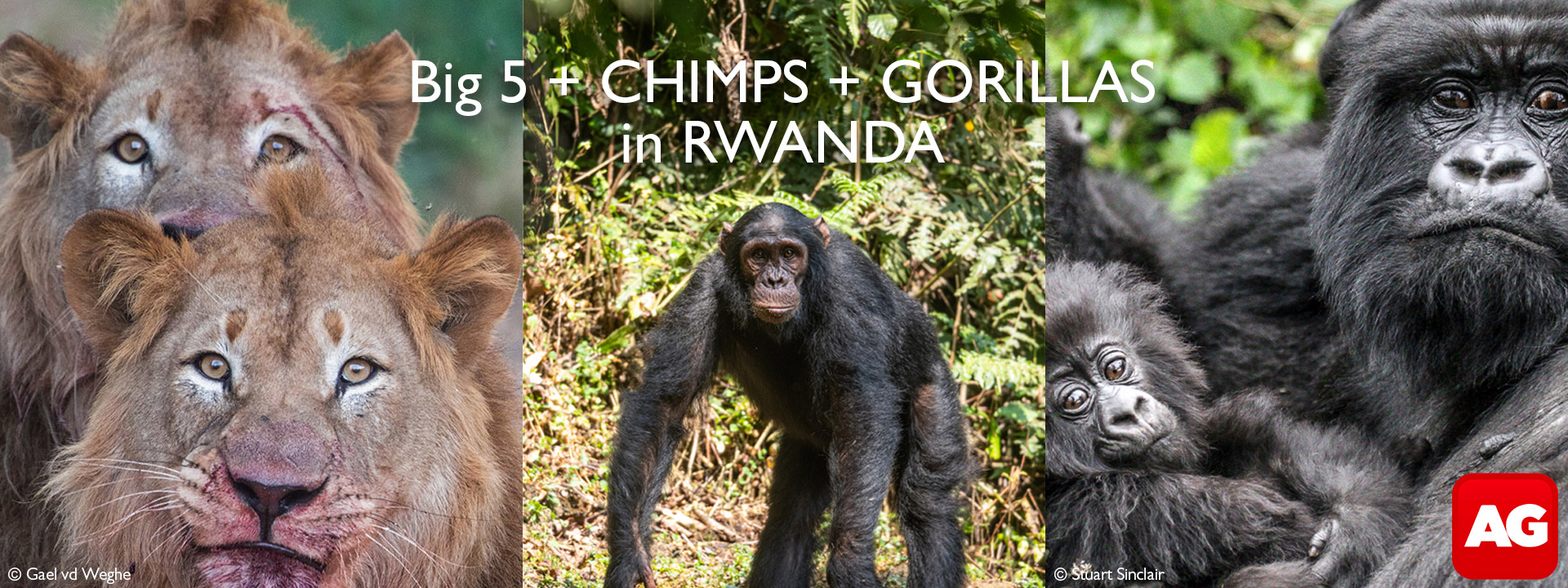
The journeys of giraffes
The life of a giraffe begins dramatically with a two-metre drop to the ground below the standing mother. Once the tiny creature has recovered from the shock of its brutal entry into the world, it immediately tries to stand; a feat made all the more challenging as a giraffe calf is already around two metres tall at birth. They are born with their ossicones folded down on the skull – these will become erect a few days later. A closer look at a giraffe calf also reveals that they are oddly disproportionate, with a (relatively) short neck, which allows them to suckle comfortably.
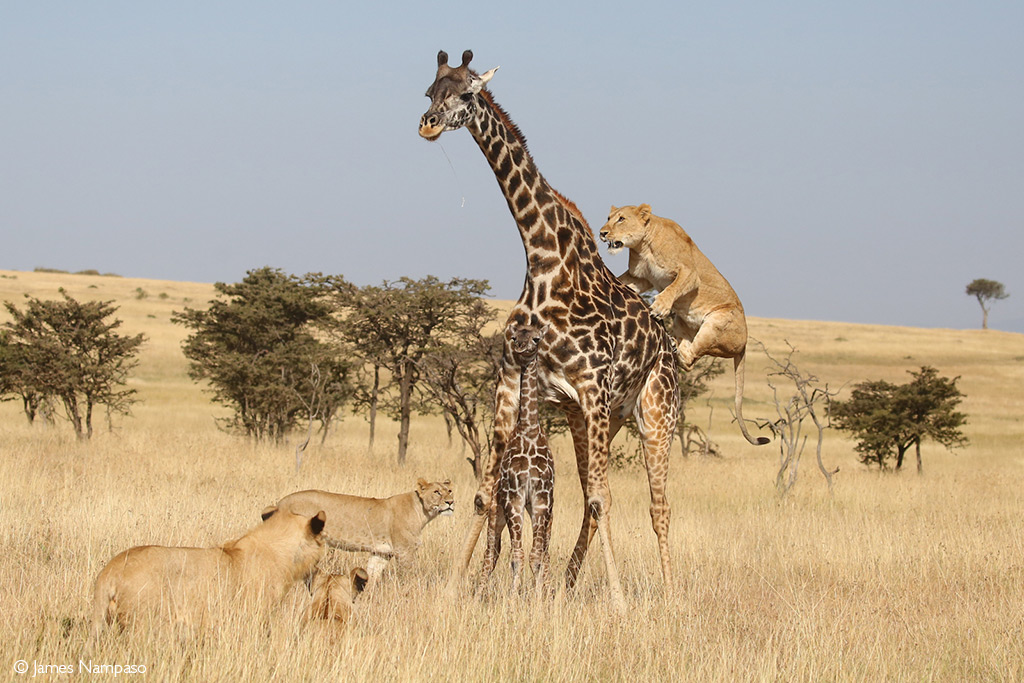
Giraffe calves are most vulnerable to predators during their first few weeks. Still, giraffe cows are formidable protectors and will attempt to fight off even the largest predators with potentially lethal kicks. It is not uncommon to encounter slightly older calves in a “calving pool” under the care of one female. The calves suckle for up to eight months and remain with their mothers for just over a year.
It was generally assumed that giraffes formed no lasting social bonds, but research now shows that their social dynamics are far more complex than initially believed . Females live in matrilineal societies, and associations between mothers, daughters, and grandmothers may last for years. These small kinship groups may link up with other herds for a while before separating again – a more typical fission-fusion society. Distress signs have also been observed in cows that have witnessed the death of another cow’s calf, suggesting a degree of cooperation in calf raising.
Naturally, any social structure requires communication and giraffe are not the mute creatures they were once believed to be. They have been recorded humming, snorting, grunting, moaning and even growling. Fascinatingly, they can also use infrasonic sounds to communicate below the level of human perception, like elephants.
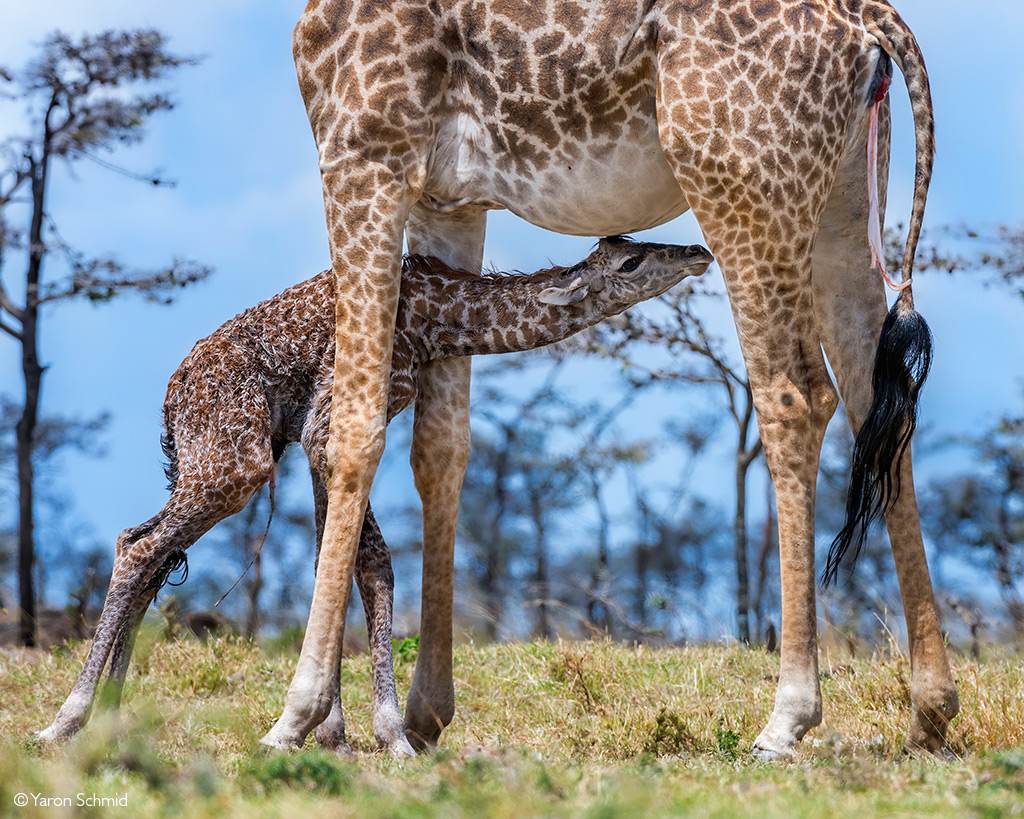
Boys are smelly
Unlike the females, the bulls seemingly form no lasting social bonds. Once they disperse from their mothers, they may temporarily join bachelor herds but become increasingly solitary as they age. Sexual maturity is attained at around four years of age, but it may take several years until they can compete for mating rights.
A fight between two equally matched males is one of Africa’s greatest spectacles. The process is (perhaps somewhat deceptively) termed “necking” and involves swinging the neck round in powerful arcs and using the ossicones to club the flanks of a rival. The blows can be exceedingly violent, and while it is rare, such fights can be lethal. For this reason, the ossicones of bulls are far thicker, more rounded, and hairless than those of the females.
All giraffes smell somewhat pungent, but mature bulls are downright malodorous. This is because their skin is coated with copious amounts of a secretion containing 3-methylindole, a chemical responsible for the smell of mammalian faeces, and para-cresol. These substances discourage the growth of fungi and bacteria on the skin.

The Silent Extinction
Currently, the IUCN Red List recognises only one giraffe species, which is classified as “Vulnerable”. However, the most recent genetic research shows that there are four species of giraffe, three of which have several different subspecies. These are:
- West African giraffe – G. c. peralta
- Nubian giraffe (including the Rothschild’s giraffe) – G. c. camelopardalis
- Kordofan giraffe – G. c. antiquorum
- South African giraffe – G. g. giraffa
- Angolan giraffe – G. g. angolensis
- Masai giraffe – G. t. tippelsirchi
- Luangwa giraffe (often termed the Thornicroft’s giraffe) – G. t. thornicrofti
- Reticulated giraffe ( Giraffa reticulata)
Though there has been considerable academic debate over the exact species/subspecies designations, the discussion is essential as it goes to the heart of conservation efforts. While giraffes across Africa may only be “vulnerable”, many species and subspecies face potential extinction due to habitat loss, bushmeat poaching, and snaring. It is helpful to consider the distinction between the four species as one might of the difference between white and black rhinos to understand how vital it is for their future.
For those wishing to make a meaningful contribution to giraffe conservation, you can visit the Giraffe Conservation Foundation’s page on our app (see instructions on how to get the app below this story).

Final thoughts
In the Southern Hemisphere, the Southern Cross constellation (Crux) revolves its way through the night sky, pointing out south for weary travellers and excited novice stargazers. In a much more exciting interpretation from some traditional Bushman stories, these four stars are two giraffes, forever wandering the inky black of night. And just as the stars are an essential element of the sky, so too are giraffes a vital part of Africa’s ecosystems, which makes it astonishing that we still know so little about them…
Further reading
For a more in-depth analysis of the giraffe species and the threats facing them, read Giraffes: The Silent Extinction
For the most recent species and subspecies classification, have a look at Four giraffe species, seven subspecies
And for the latest populations and trends, Giraffe conservation status – the latest numbers give hope!
HOW TO GET THE MOST OUT OF AFRICA GEOGRAPHIC:
- Travel with us . Travel in Africa is about knowing when and where to go, and with whom. A few weeks too early / late and a few kilometres off course and you could miss the greatest show on Earth. And wouldn’t that be a pity? Browse our ready-made packages or answer a few questions to start planning your dream safari .
- Subscribe to our FREE newsletter / download our FREE app to enjoy the following benefits.
- Plan your safaris in remote parks protected by African Parks via our sister company https://ukuri.travel/ - safari camps for responsible travellers

Friend's Email Address
Your Email Address
- +256-392-177-904
- +256-702-613-081
- [email protected]
- COVID-19 Safari Policy
- Gorilla trekking
Facts about Giraffes
Facts about Giraffes : The giraffe is a unique and outstanding mammal that has a very long neck as well as very long legs (approximately 6 feet long). Although their legs are very long, a Giraffe can run at an average speed of 35miles/hour. The amazing animals use t heir long necks to access food on the hire tree branches. On average a giraffe can grow up to 25 years while living in the wilderness and these can be seen during our exciting Uganda Wildlife Safaris in the different National Park. Although at a simple glance all giraffes may see to resemble, an interesting fact is that each one of them has its own unique pattern of the spots found on their coats.
In this article we try to answer the frequently asked questions about and highlight a number of interesting facts about them
Do Giraffes Sit Down?
Yes, Giraffes do sit down, however because of their large bodies, they hardly do so. It is very rare to come across a giraffe sitting as this may cause a body imbalance between their long legs and necks.
Secondly, giraffes hardly seat because it is quite challenging for them to get back to a standing position if they have been sitting down, this makes extremely vulnerable to predators. While resting, they normal fold their legs below their bodies while they keep their neck up-straight watching out for any advancing predators.
Do Giraffes Sleep, and for how long?
As they sleep, they do not lay down. They simply curl their necks and remain standing. They do not lay dawn. On average, the sleep for about half an hour (30 minutes) out of the entire 24 hours in a day. For their safety purposes, they tend to sleep in intervals of 5 minutes. They are very alert waking up every now and again. This explains why some people refer to the sleep as a basic nap.
How do Giraffes give birth to their young?
When the females are giving birth, they do so while standing. It’s also believed that their hearts beat really hard (pump twice as hard) to pump blood up their neck to their brain. These animals are really unique.
What Do Giraffes Feed On (Eat)?
Typically, Giraffes are herbivore and feed on the buds, flowers, shoots as well as leaves of green vegetation including bushes, trees and shrubs. Occasionally they may eat some grass. They use their powerful tongues to break these parts of the vegetation. They have a very tough mouth; this enables them to also eat prickly plants as well while on Uganda Safaris Tours .
Thanks to their long necks, they can reach different plants thus boosting their diet. To satisfy their large bodies, it is said that giraffes spend over 75% of their day eating, and on average, an adult will consume up to66 pounds.
Because of their large size, giraffes require large quantities of food every day. They sometimes spend upward of 75 percent of their day grazing, especially in the dry season. A healthy adult will consume around of food when it’s available, although they survive on a good deal less when foraging is difficult.
Another interesting fact about the giraffe is that it can go for a while without drinking water. Similar to camels, they can withstand long periods of no water.
Is the colour of a giraffe’s tongue blue?
When a giraffe is feeding, it mainly uses its long tongue and this means that the tongue is exposed to the sunlight. So the dark coloration which the scientists say to be Melanin that presents as purple, blue or even black at times prevents their tongues from being sun-burned. However, if you are observant enough, you will notice that because the underside of the tongue is not always in the sun and doesn’t need any protection, it is pink in colour.
Giraffes generally have strong prehensile tongues which can grow to a length of 20 inches. These they wrap around the higher leaves which they are going to eat.
Do Giraffes communicate with one another?
Yes, giraffes communicate with one another using vibrations plus infrasonic sounds just as dolphins. These animals are generally very peaceful and very silent so they hardly ever make any vocal sounds. They have been observed to use high pitched whistles and grunts occasionally to explore while on Uganda Tours .
How tall and big does a giraffe grow?
When we analyze an adult giraffe, its tongue is 21 inches long, its feet can grow to a length of over 6 feet, while its neck is actually longer.
An adult male giraffe can grow to a weight of 2,800 pounds then a female can grow to 1,750 pounds. Then a new born giraffe is approximately six feet tall.
- Help Center
- Plan Your Visit
- Places to Stay
- Youth Programs
- Student & Youth Groups
- Dining Programs
- Events & Catering
- Live Cameras
- Our Mission
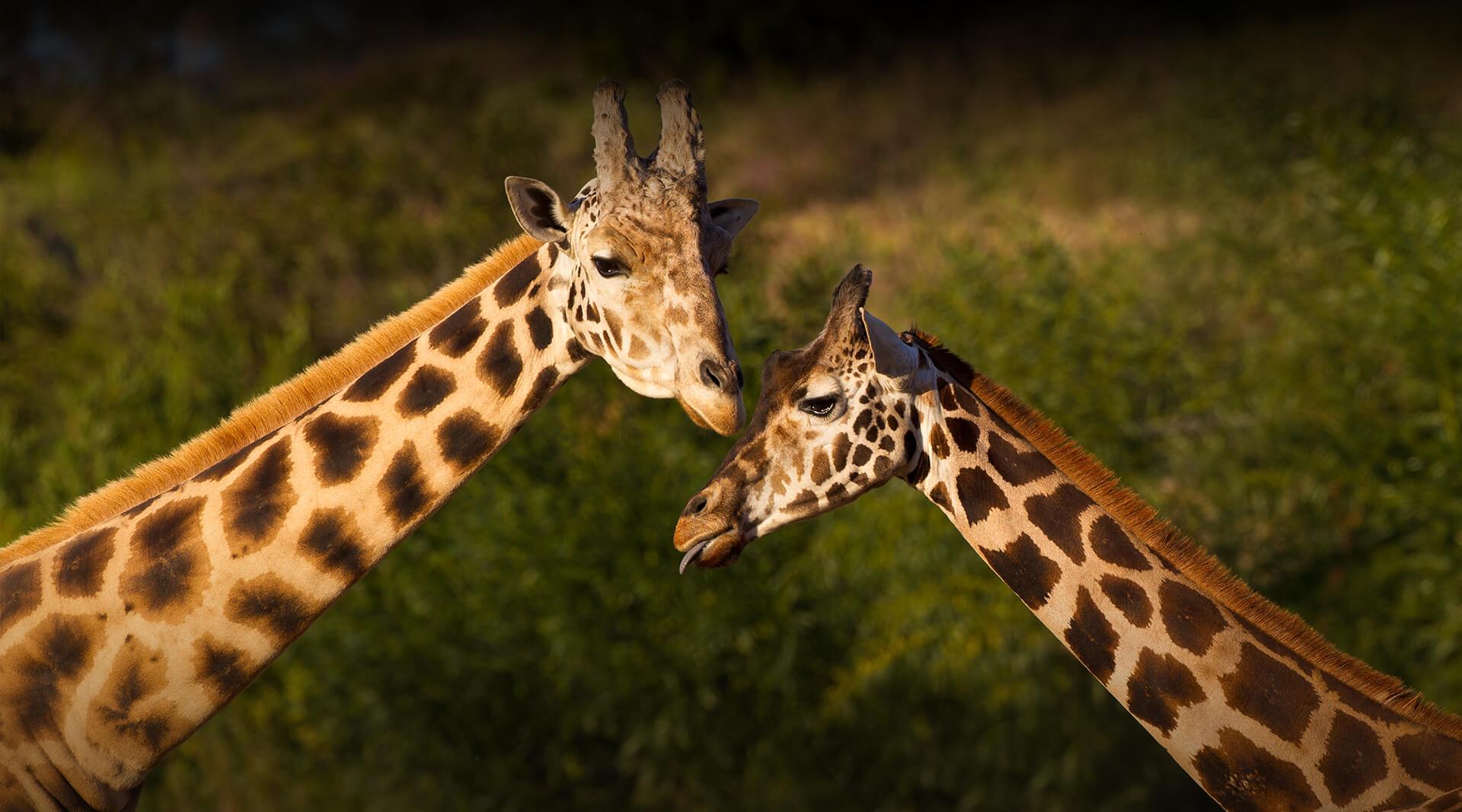
- Conservation Status: Threatened
Giraffes are the tallest land animals, able to look into a second-story window without having to stand on tiptoes! It takes a lot of leaves to fuel such large animals. Giraffes may eat up to 75 pounds (34 kilograms) of food per day, nibbling on leaves from Africa’s acacia trees. These trees often have thorns that keep most animals from munching on them, but those thorns don't stop giraffes! They just use their long tongue to reach around the thorns.
The Uganda giraffe is the only endangered giraffe subspecies. It survives in a few small, isolated populations in Kenya and Uganda. Yet at the Safari Park, we have had over 100 births so far in our large African Plains habitat!
You can admire our giraffes from the African Plains' Kijamii Overlook, from the Africa Tram, or from a Wildlife Safari, Cart Safari, or Ultimate Safari. Also, check out our new Giraffe Cam , to see livestreaming video of our African Plains giraffes and other wildlife anytime, online.

Save the Chubby Unicorns

Gorilla Shadow

PREFERRED HOTELS
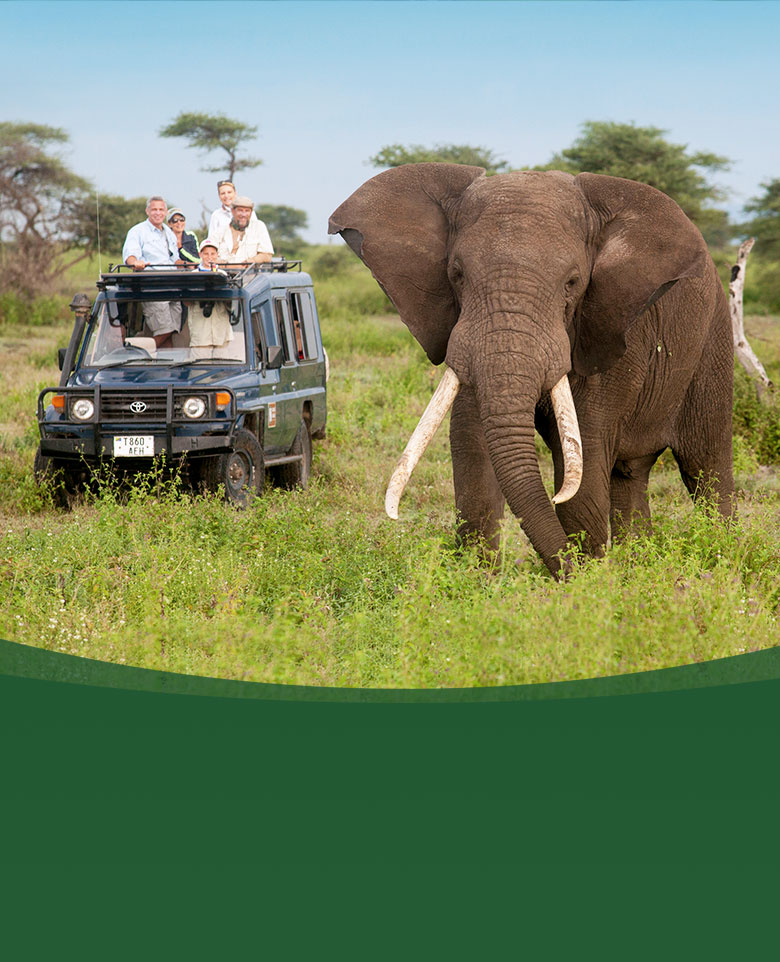
Come Travel with Us!
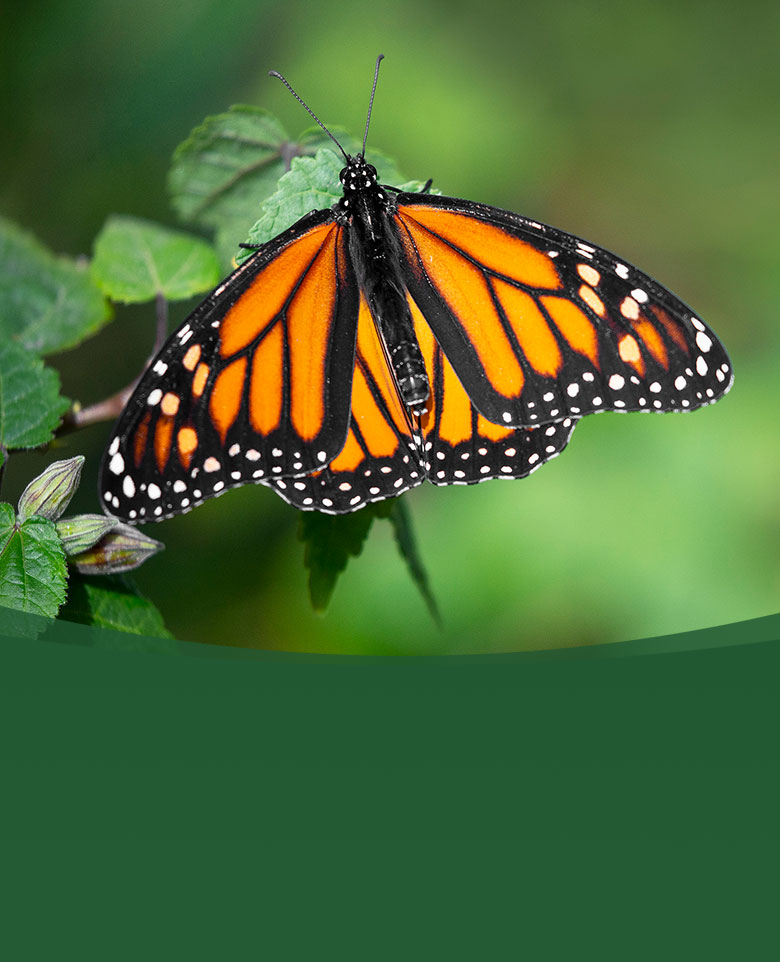
Travel with us to see Monarchs
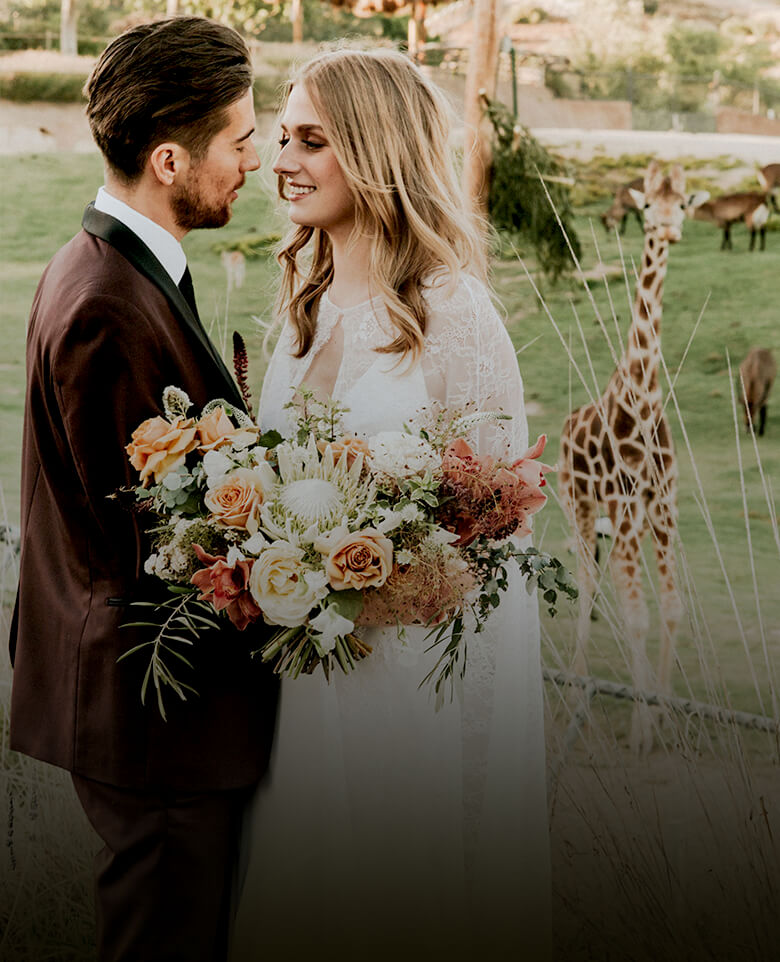
Picture Your Special Day at the Park!

IMAGES
COMMENTS
You can see groups of up to 50 giraffe in northern Selous, Tanzania, and Murchinson Falls National Park, Uganda. Back to Top Northern Selous, Tanzania. The Nyerere National Park (formerly Selous Game Reserve) is perhaps the closest Tanzania gets to a true wilderness paradise, a fantastically large, remote region - the size of Switzerland and the biggest reserve in East Africa - and with ...
1. Murchison Falls National Park is the Best Place in Uganda to see Giraffes. Murchison Falls National Park in Uganda is the best location for seeing the Nubian or Rothschild Giraffe in the Wild. With a population of over 1,550 Giraffes, you can nowhere else see groups of up to 50 Giraffes roaming the Savannah of the park.
If you are planning a safari vacation to Uganda and the Giraffe is among the animals your must see list the following are places to visit. Murchison Falls National Park. Murchison Falls National Park is simply giraffe territory! Uganda's biggest park has the biggest population of giraffes in Uganda that were numbering 1968 by 2019. This is ...
Due to concerted efforts to increase giraffe numbers in the country, Uganda is now home to over 1,800 Nubian giraffe - still a precariously low number that highlights the need for ongoing monitoring to ensure their survival. Download the National Giraffe Conservation Strategy & Action Plan for Uganda (2020-2030)
2) Giraffes in Kidepo Valley National Park. This park provides one of the best and most unique giraffe viewing experiences in Uganda. Since it is sparsely populated by both tourists and vegetation, it makes it easy to see these tall creatures roam the outstretched savannas in the distance without any distractions.
Rothschild's giraffe population were mostly affected in Kidepo Valley National Park which is situated in the semi-arid Karamoja region northeast of Uganda along the border with South Sudan and Turkan region, Kenya. About 400 individuals that lived there only 3 survived according to Uganda Wildlife Authority records by 1997.
Giraffe Sights Africa exceeded our expectations during our 5-Day Marchifon falls wildlife Safari in Uganda. From seamless planning to unforgettable experiences, every moment was exceptional. Our guide was knowledgeable and passionate,...
Your guide on where to find Nubian Giraffe in Uganda, including best national parks and ideal times of the year to spot this majestic creature. +256 785 101122; [email protected] +256 787 696371 ... Decide whether you prefer a customized Uganda safari tailored to your preferences or a group safari that offers a shared experience with like ...
Africa safari melee of antelopes and giraffes in Uganda Rothschild's giraffe behaviour. Rothschild's Giraffe is a social animal living in loose, open, unstable herds varying from 10 to 20 individuals, although researchers have observed herds of up to 70.. There is no significant rule for joining or leaving a herd; individual giraffes join and leave the herd at will.
Founded in 1962, Kidepo National Park is Uganda's 3 rd biggest safari park, covering the land area of about 1442sq.kms featuring the sweeping savanna plains. Nubian Giraffe Conservation in Uganda Over 75 mammal species live in Kidepo plus 470 bird species in addition to numerous giraffe population.
Uganda hosts the only natural remaining population of close to 1,000 of the 2,500 Rothschild's giraffes in the world. The rest are in small population. Inspire African Safaris is ranked 1# on Most Tour Platforms i.e TripAdvisor and TourRadar, Get Your Guide and Google. ... Wildlife Safaris, hiking. The Rothschild's giraffe, also known as the ...
This alluring southern extension of the Great Rift Valley is best known for its guided walking safaris and for the visibility of its leopards. It is also home to the world's last 550 Thornicroft's giraffes, an endangered subspecies unknown in captivity or in any other part of Africa. 16 South Luangwa Safaris . 9. Giraffe Centre - Kenya
The Nubian Giraffe also known as the Rothschild giraffe is one of the most endangered giraffe species. This Giraffe species can be spotted during Uganda wildlife Safaris. Giraffes are such amazing creatures! Their swaying gait comes in as a result of moving both right legs simultaneously followed by both left legs.
However, in Uganda, with its abundant flora and fauna, lives an even rarer mammal: the Rothschild's giraffe (also called Uganda giraffe or Baringo giraffe). Today (September 2015), the total number of wild individuals is estimated at around 840 individuals, spread across 13 populations in Uganda and Kenya (in South Sudan, the species is ...
Giraffe on Safari in the Okavango Delta, Botswana. ... Kenya, and Uganda with the largest populations in Kenya and Uganda, including the formerly recognized Rothschild's giraffe. With a decline rate of 95% over the last 30 years, the subspecies is listed as critically endangered. They are best encountered in the wild from Murchison Falls ...
+256 700 879 264; [email protected]
Perhaps the ultimate icon of the African savanna, the giraffe is an unmistakable land mammal known for its long neck and spotted coat. Read on for a few interesting facts about this intriguing animal. Latin name: Giraffa camelopardalis. Group name: Tower. Size: 4.3 meters to 5.7 meters tall.
Giraffe Manor is one of the most sought-after hotel stays in Africa. It is an exclusive boutique hotel located in the suburbs of the Kenyan capital of Nairobi. Built in 1932 as a colonial hunting lodge, today Giraffe Manor is a Nairobi icon and offers one of the city's most special experiences. What sets Giraffe Manor truly apart is its herd ...
The giraffe is a wonder of evolution, and a vital part of Africa's ecosystems. Read all there is to know about the planet's tallest creature. safari experts, since 1991 ... //ukuri.travel/ - safari camps for responsible travellers; Our most popular safaris. Africa's ultimate primate safari More details. Moremi Magic: ...
Am sure you still confused about where to find giraffes in Uganda which on Uganda wildlife safari. Giraffes with their beautiful skin and marvelous height are o ... Inspire African Safaris is ranked 1# on Most Tour Platforms i.e TripAdvisor and TourRadar, Get Your Guide and Google. Our Customers represent us, choose us and be part of this large ...
A giraffe safari in Africa is an extraordinary adventure that offers a unique opportunity to witness these captivating creatures in their natural habitat. Whether you choose to explore the vast savannahs of Tanzania and Kenya, the remote landscapes of Namibia, or the diverse ecosystems of Uganda and South Africa, encountering giraffes on safari ...
Facts about Giraffes : The giraffe is a unique and outstanding mammal that has a very long neck as well as very long legs (approximately 6 feet long). Although their legs are very long, a Giraffe can run at an average speed of 35miles/hour. The amazing animals use t heir long necks to access food on the hire tree branches.
The Uganda giraffe is the only endangered giraffe subspecies. It survives in a few small, isolated populations in Kenya and Uganda. Yet at the Safari Park, we have had over 100 births so far in our large African Plains habitat! You can admire our giraffes from the African Plains' Kijamii Overlook, from the Africa Tram, or from a Wildlife Safari ...